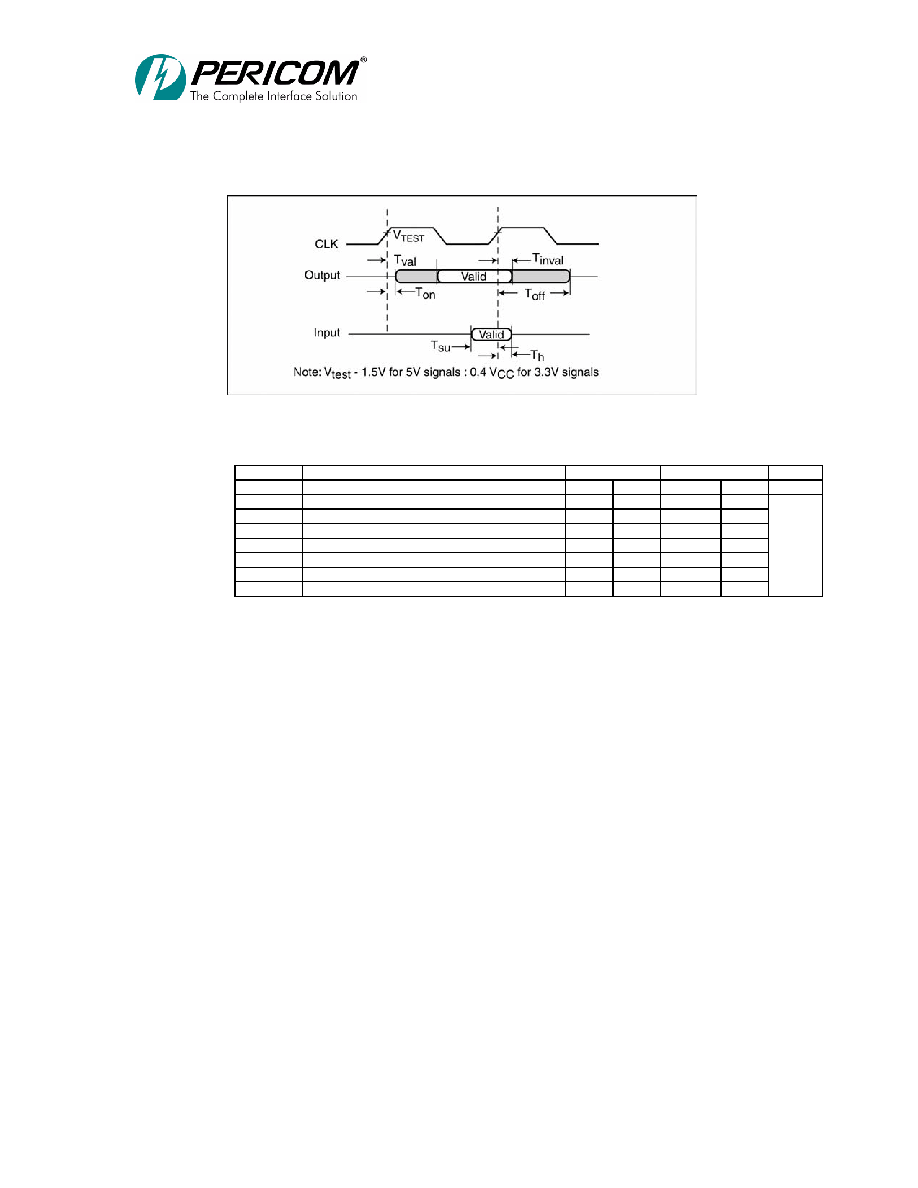 | –≠–ª–µ–∫—Ç—Ä–æ–Ω–Ω—ã–π –∫–æ–º–ø–æ–Ω–µ–Ω—Ç: PI7C8150B | –°–∫–∞—á–∞—Ç—å:  PDF PDF  ZIP ZIP |

PI7C8150B
2-Port PCI-to-PCI Bridge
REVISION 1.031
2380 Bering Drive, San Jose, CA 95131
Telephone: 1-877-PERICOM, (1-877-737-4266)
Fax: 408-435-1100
Email:
solutions@pericom.com
Internet:
http://www.pericom.com

PI7C8150B
2-PORT PCI-TO-PCI BRIDGE
ADVANCE INFORMATION
Page 2 of 115
July 31, 2003 ≠ Revision 1.031
LIFE SUPPORT POLICY
Pericom Semiconductor Corporation's products are not authorized for use as critical components in life
support devices or systems unless a specific written agreement pertaining to such intended use is executed
between the manufacturer and an officer of PSC.
1) Life support devices or system are devices or systems which:
a) Are intended for surgical implant into the body or
b) Support or sustain life and whose failure to perform, when properly used in accordance with
instructions for use provided in the labeling, can be reasonably expected to result in a significant
injury to the user.
2) A critical component is any component of a life support device or system whose failure to perform can
be reasonably expected to cause the failure of the life support device or system, or to affect its safety or
effectiveness. Pericom Semiconductor Corporation reserves the right to make changes to its products
or specifications at any time, without notice, in order to improve design or performance and to supply
the best possible product. Pericom Semiconductor does not assume any responsibility for use of any
circuitry described other than the circuitry embodied in a Pericom Semiconductor product. The
Company makes no representations that circuitry described herein is free from patent infringement or
other rights of third parties which may result from its use. No license is granted by implication or
otherwise under any patent, patent rights or other rights, of Pericom Semiconductor Corporation.
All other trademarks are of their respective companies.

PI7C8150B
2-PORT PCI-TO-PCI BRIDGE
ADVANCE INFORMATION
Page 3 of 115
July 31, 2003 ≠ Revision 1.031
REVISION HISTORY
Date Revision
Number
Description
03/26/03
1.00
First Release of Data Sheet
05/14/03
1.01
Correction to description for bit[0] at offset 48h. Changed from
Memory Read Flow Through Disable to Memory Read Flow Through
Enable.
Added reset condition to offset 4Ch, bits [31:28]
06/10/03
1.02
Revised descriptions and added ordering information for PI7C8150B-
33 (33MHz) device
Revised temperature support to industrial temperature
06/25/03
1.03
Revised temperature support back to extended commercial range (0C
to 85C)
Corrected pin descriptions for S_M66EN, P_M66EN, and
S_CLKOUT.
07/31/03
1.031
Corrected MS0 and MS1 pin assignments on Table 2.4. MS0 should
be B14 and MS1 should be R16.
Added PBGA pin assignments to signal descriptions in Section 2.2.
Revised power consumption specifications in section 17.6
Revised TDELAY specifications in sections 17.4 and 17.5

PI7C8150B
2-PORT PCI-TO-PCI BRIDGE
ADVANCE INFORMATION
Page 4 of 115
July 31, 2003 ≠ Revision 1.031
This page intentionally left blank.

PI7C8150B
2-PORT PCI-TO-PCI BRIDGE
ADVANCE INFORMATION
Page 5 of 115
July 31, 2003 ≠ Revision 1.031
TABLE OF CONTENTS
1
INTRODUCTION .............................................................................................................................. 11
2
SIGNAL DEFINITIONS ................................................................................................................... 12
2.1
S
IGNAL
T
YPES
............................................................................................................................... 12
2.2
S
IGNALS
........................................................................................................................................ 12
2.2.1
PRIMARY BUS INTERFACE SIGNALS.......................................................................... 12
2.2.3
CLOCK SIGNALS ............................................................................................................... 15
2.2.4
MISCELLANEOUS SIGNALS........................................................................................... 16
2.2.5
GENERAL PURPOSE I/O INTERFACE SIGNALS ........................................................ 17
2.2.6
JTAG BOUNDARY SCAN SIGNALS ................................................................................ 17
2.2.7
POWER AND GROUND..................................................................................................... 18
2.3
PIN
LIST
≠
208-PIN
FQFP........................................................................................................... 18
2.4
PIN
LIST
≠
256-BALL
PBGA...................................................................................................... 20
3
PCI BUS OPERATION ..................................................................................................................... 22
3.1
TYPES
OF
TRANSACTIONS..................................................................................................... 22
3.2
SINGLE
ADDRESS
PHASE........................................................................................................ 23
3.3
DEVICE
SELECT
(DEVSEL_L)
GENERATION....................................................................... 23
3.4
DATA
PHASE.............................................................................................................................. 23
3.5
WRITE
TRANSACTIONS .......................................................................................................... 23
3.5.1
MEMORY WRITE TRANSACTIONS................................................................................ 24
3.5.2
MEMORY WRITE AND INVALIDATE............................................................................ 25
3.5.3
DELAYED WRITE TRANSACTIONS............................................................................... 25
3.5.4
WRITE TRANSACTION ADDRESS BOUNDARIES....................................................... 26
3.5.5
BUFFERING MULTIPLE WRITE TRANSACTIONS..................................................... 26
3.5.6
FAST BACK-TO-BACK TRANSACTIONS ....................................................................... 27
3.6
READ
TRANSACTIONS ............................................................................................................ 27
3.6.1
PREFETCHABLE READ TRANSACTIONS.................................................................... 27
3.6.2
NON-PREFETCHABLE READ TRANSACTIONS.......................................................... 27
3.6.3
READ PREFETCH ADDRESS BOUNDARIES ............................................................... 28
3.6.4
DELAYED READ REQUESTS .......................................................................................... 29
3.6.5
DELAYED READ COMPLETION WITH TARGET ........................................................ 29
3.6.6
DELAYED READ COMPLETION ON INITIATOR BUS................................................ 29
3.6.7
FAST BACK-TO-BACK READ TRANSACTION ............................................................. 30
3.7
CONFIGURATION
TRANSACTIONS ...................................................................................... 30
3.7.1
TYPE 0 ACCESS TO PI7C8150B....................................................................................... 31
3.7.2
TYPE 1 TO TYPE 0 CONVERSION .................................................................................. 31
3.7.3
TYPE 1 TO TYPE 1 FORWARDING................................................................................. 33
3.7.4
SPECIAL CYCLES ............................................................................................................. 34
3.8
TRANSACTION
TERMINATION.............................................................................................. 34
3.8.1
MASTER TERMINATION INITIATED BY PI7C8150B ................................................. 35
3.8.2
MASTER ABORT RECEIVED BY PI7C8150B ................................................................ 36
3.8.3
TARGET TERMINATION RECEIVED BY PI7C8150B.................................................. 36
3.8.4
TARGET TERMINATION INITIATED BY PI7C8150B.................................................. 41
4
ADDRESS DECODING..................................................................................................................... 43
4.1
ADDRESS
RANGES ................................................................................................................... 43
4.2
I/O
ADDRESS
DECODING ........................................................................................................ 43
4.2.1
I/O BASE AND LIMIT ADDRESS REGISTER................................................................ 44
4.2.2
ISA MODE........................................................................................................................... 45

PI7C8150B
2-PORT PCI-TO-PCI BRIDGE
ADVANCE INFORMATION
Page 6 of 115
July 31, 2003 ≠ Revision 1.031
4.3
MEMORY
ADDRESS
DECODING............................................................................................ 45
4.3.1
MEMORY-MAPPED I/O BASE AND LIMIT ADDRESS REGISTERS ......................... 46
4.3.2
PREFETCHABLE MEMORY BASE AND LIMIT ADDRESS REGISTERS................. 47
4.4
VGA
SUPPORT ........................................................................................................................... 48
4.4.1
VGA MODE......................................................................................................................... 48
4.4.2
VGA SNOOP MODE........................................................................................................... 48
5
TRANSACTION ORDERING.......................................................................................................... 49
5.1
TRANSACTIONS
GOVERNED
BY
ORDERING
RULES ........................................................ 49
5.2
GENERAL
ORDERING
GUIDELINES...................................................................................... 50
5.3
ORDERING
RULES .................................................................................................................... 50
5.4
DATA
SYNCHRONIZATION .................................................................................................... 53
6
ERROR HANDLING......................................................................................................................... 54
6.1
ADDRESS
PARITY
ERRORS .................................................................................................... 54
6.2
DATA
PARITY
ERRORS............................................................................................................ 55
6.2.1
CONFIGURATION WRITE TRANSACTIONS TO CONFIGURATION SPACE.......... 55
6.2.2
READ TRANSACTIONS .................................................................................................... 55
6.2.3
DELAYED WRITE TRANSACTIONS............................................................................... 56
6.2.4
POSTED WRITE TRANSACTIONS.................................................................................. 59
6.3
DATA
PARITY
ERROR
REPORTING
SUMMARY ................................................................. 60
6.4
SYSTEM
ERROR
(SERR_L)
REPORTING ............................................................................... 65
7
EXCLUSIVE ACCESS ...................................................................................................................... 66
7.1
CONCURRENT
LOCKS ............................................................................................................. 66
7.2
ACQUIRING
EXCLUSIVE
ACCESS
ACROSS
PI7C8150B ..................................................... 66
7.2.1
LOCKED TRANSACTIONS IN DOWNSTREAM DIRECTION ..................................... 67
7.2.2
LOCKED TRANSACTION IN UPSTREAM DIRECTION .............................................. 68
7.3
ENDING
EXCLUSIVE
ACCESS ................................................................................................ 68
8
PCI BUS ARBITRATION................................................................................................................. 69
8.1
PRIMARY
PCI
BUS
ARBITRATION......................................................................................... 69
8.2
SECONDARY
PCI
BUS
ARBITRATION .................................................................................. 69
8.2.1
SECONDARY BUS ARBITRATION USING THE INTERNAL ARBITER.................... 70
8.2.2
PREEMPTION .................................................................................................................... 71
8.2.3
SECONDARY BUS ARBITRATION USING AN EXTERNAL ARBITER...................... 71
8.2.4
BUS PARKING.................................................................................................................... 71
9
CLOCKS ............................................................................................................................................. 72
9.1
PRIMARY
CLOCK
INPUTS....................................................................................................... 72
9.2
SECONDARY
CLOCK
OUTPUTS............................................................................................. 72
9.3
ASYNCHRONOUS
MODE......................................................................................................... 72
10
GENERAL PURPOSE I/O INTERFACE.................................................................................... 73
10.1
GPIO
CONTROL
REGISTERS ................................................................................................... 73
10.2
SECONDARY
CLOCK
CONTROL............................................................................................ 74
10.3
LIVE
INSERTION ....................................................................................................................... 76
11
PCI POWER MANAGEMENT .................................................................................................... 76
12
RESET............................................................................................................................................. 77
12.1
PRIMARY
INTERFACE
RESET ................................................................................................ 77
12.2
SECONDARY
INTERFACE
RESET .......................................................................................... 77
12.3
CHIP
RESET................................................................................................................................ 78

PI7C8150B
2-PORT PCI-TO-PCI BRIDGE
ADVANCE INFORMATION
Page 7 of 115
July 31, 2003 ≠ Revision 1.031
13
SUPPORTED COMMANDS......................................................................................................... 78
13.1
PRIMARY
INTERFACE ............................................................................................................. 78
13.2
SECONDARY
INTERFACE ....................................................................................................... 79
14
CONFIGURATION REGISTERS................................................................................................ 81
14.1
CONFIGURATION
REGISTER.................................................................................................. 81
14.1.1
VENDOR ID REGISTER ≠ OFFSET 00h......................................................................... 82
14.1.2
DEVICE ID REGISTER ≠ OFFSET 00h .......................................................................... 82
14.1.3
COMMAND REGISTER ≠ OFFSET 04h.......................................................................... 82
14.1.4
STATUS REGISTER ≠ OFFSET 04h ................................................................................ 83
14.1.5
REVISION ID REGISTER ≠ OFFSET 08h ...................................................................... 84
14.1.6
CLASS CODE REGISTER ≠ OFFSET 08h....................................................................... 84
14.1.7
CACHE LINE SIZE REGISTER ≠ OFFSET 0Ch ............................................................ 84
14.1.8
PRIMARY LATENCY TIMER REGISTER ≠ OFFSET 0Ch ........................................... 84
14.1.9
HEADER TYPE REGISTER ≠ OFFSET 0Ch................................................................... 84
14.1.10
PRIMARY BUS NUMBER REGISTSER ≠ OFFSET 18h............................................ 85
14.1.11
SECONDARY BUS NUMBER REGISTER ≠ OFFSET 18h ........................................ 85
14.1.12
SUBORDINATE BUS NUMBER REGISTER ≠ OFFSET 18h.................................... 85
14.1.13
SECONDARY LATENCY TIMER REGISTER ≠ OFFSET 18h .................................. 85
14.1.14
I/O BASE REGISTER ≠ OFFSET 1Ch.......................................................................... 85
14.1.15
I/O LIMIT REGISTER ≠ OFFSET 1Ch ........................................................................ 86
14.1.16
SECONDARY STATUS REGISTER ≠ OFFSET 1Ch................................................... 86
14.1.17
MEMORY BASE REGISTER ≠ OFFSET 20h .............................................................. 87
14.1.18
MEMORY LIMIT REGISTER ≠ OFFSET 20h............................................................. 87
14.1.19
PEFETCHABLE MEMORY BASE REGISTER ≠ OFFSET 24h ................................ 87
14.1.20
PREFETCHABLE MEMORY LIMIT REGISTER ≠ OFFSET 24h ............................ 87
14.1.21
PREFETCHABLE MEMORY BASE ADDRESS UPPER 32-BITS REGISTER ≠
OFFSET 28h ....................................................................................................................................... 88
14.1.22
PREFETCHABLE MEMORY LIMIT ADDRESS UPPER 32-BITS REGISTER ≠
OFFSET 2Ch....................................................................................................................................... 88
14.1.23
I/O BASE ADDRESS UPPER 16-BITS REGISTER ≠ OFFSET 30h .......................... 88
14.1.24
I/O LIMIT ADDRESS UPPER 16-BITS REGISTER ≠ OFFSET 30h......................... 88
14.1.25
ECP POINTER REGISTER ≠ OFFSET 34h................................................................. 88
14.1.26
INTERRUPT LINE REGISTER ≠ OFFSET 3Ch ......................................................... 88
14.1.27
INTERRUPT PIN REGISTER ≠ OFFSET 3Ch............................................................ 89
14.1.28
BRIDGE CONTROL REGISTER ≠ OFFSET 3Ch ....................................................... 89
14.1.29
DIAGNOSTIC / CHIP CONTROL REGISTER ≠ OFFSET 40h.................................. 90
14.1.30
ARBITER CONTROL REGISTER ≠ OFFSET 40h...................................................... 91
14.1.31
EXTENDED CHIP CONTROL REGISTER ≠ OFFSET 48h....................................... 92
14.1.32
UPSTREAM MEMORY CONTROL REGISTER ≠ OFFSET 48h ............................... 92
14.1.33
SECONDARY BUS ARBITER PREEMPTION CONTROL REGISTER ≠ OFFSET
4Ch .......................................................................................................................................... 92
14.1.34
UPSTREAM (S TO P) MEMORY BASE REGISTER ≠ OFFSET 50h ........................ 93
14.1.35
UPSTREAM (S TO P) MEMORY LIMIT REGISTER ≠ OFFSET 50h....................... 93
14.1.36
UPSTREAM (S TO P) MEMORY BASE UPPER 32-BITS REGISTER ≠ OFFSET 54h
.......................................................................................................................................... 93
14.1.37
UPSTREAM (S TO P) MEMORY LIMIT UPPER 32-BITS REGISTER ≠ OFFSET
58h .......................................................................................................................................... 93
14.1.38
P_SERR_L EVENT DISABLE REGISTER ≠ OFFSET 64h........................................ 93
14.1.39
GPIO DATA AND CONTROL REGISTER ≠ OFFSET 64h ........................................ 95
14.1.40
SECONDARY CLOCK CONTROL REGISTER ≠ OFFSET 68h ................................. 95
14.1.41
P_SERR_L STATUS REGISTER ≠ OFFSET 68h ........................................................ 96
14.1.42
PORT OPTION REGISTER ≠ OFFSET 74h ................................................................ 96

PI7C8150B
2-PORT PCI-TO-PCI BRIDGE
ADVANCE INFORMATION
Page 8 of 115
July 31, 2003 ≠ Revision 1.031
14.1.43
RETRY COUNTER REGISTER ≠ OFFSET 78h .......................................................... 98
14.1.44
PRIMARY MASTER TIMEOUT COUNTER ≠ OFFSET 80h ..................................... 98
14.1.45
SECONDARY MASTER TIMEOUT COUNTER ≠ OFFSET 80h ............................... 98
14.1.46
CAPABILITY ID REGISTER ≠ OFFSET B0h ............................................................. 98
14.1.47
NEXT POINTER REGISTER ≠ OFFSET B0h ............................................................. 98
14.1.48
SLOT NUMBER REGISTER ≠ OFFSET B0h .............................................................. 99
14.1.49
CHASSIS NUMBER REGISTER ≠ OFFSET B0h ....................................................... 99
14.1.50
CAPABILITY ID REGISTER ≠ OFFSET DCh............................................................. 99
14.1.51
NEXT ITEM POINTER REGISTER ≠ OFFSET DCh ................................................. 99
14.1.52
POWER MANAGEMENT CAPABILITIES REGISTER ≠ OFFSET DCh ................. 99
14.1.53
POWER MANAGEMENT DATA REGISTER ≠ OFFSET E0h................................. 100
14.1.54
CAPABILITY ID REGISTER ≠ OFFSET E4h ........................................................... 100
14.1.55
NEXT POINTER REGISTER ≠ OFFSET E4h ........................................................... 100
15
BRIDGE BEHAVIOR.................................................................................................................. 101
15.1
BRIDGE
ACTIONS
FOR
VARIOUS
CYCLE
TYPES.............................................................. 101
15.2
ABNORMAL
TERMINATION
(INITIATED
BY
BRIDGE
MASTER)................................... 101
15.2.1
MASTER ABORT.............................................................................................................. 101
15.2.2
PARITY AND ERROR REPORTING .............................................................................. 101
15.2.3
REPORTING PARITY ERRORS ..................................................................................... 102
15.2.4
SECONDARY IDSEL MAPPING .................................................................................... 102
16
IEEE 1149.1 COMPATIBLE JTAG CONTROLLER.............................................................. 102
16.1
BOUNDARY
SCAN
ARCHITECTURE ................................................................................... 102
16.1.1
TAP PINS .......................................................................................................................... 103
16.1.2
INSTRUCTION REGISTER ............................................................................................ 103
16.2
BOUNDARY
SCAN
INSTRUCTION
SET............................................................................... 104
16.3
TAP
TEST
DATA
REGISTERS ................................................................................................ 105
16.4
BYPASS
REGISTER ................................................................................................................. 105
16.5
BOUNDARY-SCAN
REGISTER.............................................................................................. 105
16.6
TAP
CONTROLLER ................................................................................................................. 105
17
ELECTRICAL AND TIMING SPECIFICATIONS................................................................. 109
17.1
MAXIMUM
RATINGS ............................................................................................................. 109
17.2
DC
SPECIFICATIONS .............................................................................................................. 109
17.3
AC
SPECIFICATIONS .............................................................................................................. 110
17.4
66MHZ
TIMING ........................................................................................................................ 111
17.5
33MHZ
TIMING ........................................................................................................................ 111
17.6
POWER
CONSUMPTION......................................................................................................... 111
18
PACKAGE INFORMATION...................................................................................................... 112
18.1
208-PIN
FQFP
PACKAGE
DIAGRAM..................................................................................... 112
18.2
256-BALL
PBGA
PACKAGE
DIAGRAM................................................................................ 113
18.3
PART
NUMBER
ORDERING
INFORMATION ...................................................................... 113

PI7C8150B
2-PORT PCI-TO-PCI BRIDGE
ADVANCE INFORMATION
Page 9 of 115
July 31, 2003 ≠ Revision 1.031
LIST OF TABLES
Table 2-1. Pin List ≠ 208-pin FQFP............................................................................................................ 18
Table 2-2. Pin List ≠ 256-pin PBGA............................................................................................................ 20
Table 3-1. PCI Transactions ........................................................................................................................ 22
Table 3-2. Write Transaction Forwarding .................................................................................................. 23
Table 3-3. Write Transaction Disconnect Address Boundaries................................................................... 26
Table 3-4. Read Prefetch Address Boundaries............................................................................................ 28
Table 3-5. Read Transaction Prefetching.................................................................................................... 28
Table 3-6. Device Number to IDSEL S_AD Pin Mapping........................................................................... 32
Table 3-7. Delayed Write Target Termination Response ............................................................................ 37
Table 3-8. Response to Posted Write Target Termination........................................................................... 39
Table 3-9. Response to Delayed Read Target Termination......................................................................... 41
Table 5-1. Summary of Transaction Ordering ............................................................................................ 52
Table 6-1. Setting the Primary Interface Detected Parity Error Bit ........................................................... 60
Table 6-2. Setting Secondary Interface Detected Parity Error Bit.............................................................. 61
Table 6-3. Setting Primary Interface Master Data Parity Error Detected Bit ............................................ 63
Table 6-4. Setting Secondary Interface Master Data Parity Error Detected Bit......................................... 63
Table 6-5. Assertion of P_PERR_L ............................................................................................................. 64
Table 6-6. Assertion of S_PERR_L.............................................................................................................. 64
Table 6-7. Assertion of P_SERR_L for Data Parity Errors......................................................................... 65
Table 10-1. GPIO Operation....................................................................................................................... 74
Table 10-2. GPIO Serial Data Format........................................................................................................ 75
Table 11-1. Power Management Transitions .............................................................................................. 76
Table 16-1. TAP Pins ................................................................................................................................ 104
Table 16-2. JTAG Boundary Register Order............................................................................................. 106
LIST OF FIGURES
Figure 8-1 Secondary Arbiter Example.................................................................................................... 70
Figure 16-1 Test Access Port Block Diagram........................................................................................ 103
Figure 17-1 PCI Signal Timing Measurement Conditions ..................................................................... 110
Figure 18-1 208-pin FQFP Package Outline......................................................................................... 112
Figure 18-2 256-pin PBGA Package Outline......................................................................................... 113

PI7C8150B
2-PORT PCI-TO-PCI BRIDGE
ADVANCE INFORMATION
Page 10 of 115
July 31, 2003 ≠ Revision 1.031
This page intentionally left blank.

PI7C8150B
2-PORT PCI-TO-PCI BRIDGE
ADVANCE INFORMATION
Page 11 of 115
July 31, 2003 ≠ Revision 1.031
1
INTRODUCTION
Product Description
The PI7C8150B is an enhanced PCI-to-PCI Bridge that will support asynchronous
operation and is designed to be fully compliant with the PCI Local Bus Specification
Revision 2.2. Both the primary and secondary interfaces are specified to run at 32-bits and
up to 66MHz (33MHz for PI7C8150B-33).
Product Features
∑ 32-bit Primary and Secondary Ports run up to 66MHz (33MHz for PI7C8150B-33)
∑ Compliant with the PCI Local Bus Specification, Revision 2.2
∑ Compliant with PCI-to-PCI Bridge Architecture Specification, Revision 1.1.
∑ All I/O and memory commands
- Type 1 to Type 0 configuration conversion
- Type 1 to Type 1 configuration forwarding
- Type 1 configuration write to special cycle conversion
∑ Compliant with the Advanced Configuration Power Interface (ACPI) Specification.
∑ Compliant with the PCI Power Management Specification, Revision 1.0.
∑ Synchronous and Asynchronous operation support
- Supported modes of asynchronous operation
Primary
(MHz)
Secondary
(MHz)
PI7C8150B
25MHz to 66MHz
25MHz to 66MHz
PI7C8150B-33
25MHz to 33MHz
25MHz to 33MHz
- Supported modes of synchronous operation
Primary
(MHz)
Secondary
(MHz)
PI7C8150B 66
66
PI7C8150B 66
33
PI7C8150B 50
50
PI7C8150B 50
25
PI7C8150B
PI7C8150B-33
33 33
PI7C8150B
PI7C8150B-33
25 25
∑ Provides internal arbitration for one set of nine secondary bus masters
- Programmable 2-level priority arbiter
- Disable control for use of external arbiter
∑ Supports posted write buffers in all directions
∑ Four 128 byte FIFO's for delay transactions
∑ Two 128 byte FIFO's for posted memory transactions
∑ Enhanced address decoding
∑ Extended Commercial temperature range 0∞C to 85∞C
∑ IEEE 1149.1 JTAG interface support
∑ 3.3V core; 3.3V and 5V signaling
∑ 208-pin FQFP and 256-pin PBGA

PI7C8150B
2-PORT PCI-TO-PCI BRIDGE
ADVANCE INFORMATION
Page 12 of 115
July 31, 2003 ≠ Revision 1.031
2
SIGNAL DEFINITIONS
2.1
Signal Types
Signal Type
Description
I Input
Only
O Output
Only
P Power
TS Tri-State
bi-directional
STS
Sustained Tri-State. Active LOW signal must be pulled HIGH for 1 cycle when
deasserting.
OD Open
Drain
2.2
Signals
Note: Signal names that end with "_L" are active LOW.
2.2.1
PRIMARY BUS INTERFACE SIGNALS
Name
Pin #
Pin #
Type
Description
P_AD[31:0]
49, 50, 55, 57, 58,
60, 61, 63, 67, 68,
70, 71, 73, 74, 76,
77, 93, 95, 96, 98,
99, 101, 107, 109,
112, 113, 115,
116, 118, 119,
121, 122
N3, T2, T4, N5,
P5, T5, N6, R5,
T6, P7, T7, R7,
T8, P8, R8, T9,
R12, P12, T14,
R13, N12, T15,
P16, N15, M14,
M13, M15,
L13, M16, L14,
L15, L16
TS
Primary Address / Data: Multiplexed address and data
bus. Address is indicated by P_FRAME_L assertion.
Write data is stable and valid when P_IRDY_L is
asserted and read data is stable and valid when
P_TRDY_L is asserted. Data is transferred on rising
clock edges when both P_IRDY_L and P_TRDY_L are
asserted. During bus idle, PI7C8150B drives P_AD to a
valid logic level when P_GNT_L is asserted.
P_CBE[3:0]
64, 79, 92, 110
R6, R9, T13,
N16
TS
Primary Command/Byte Enables: Multiplexed
command field and byte enable field. During address
phase, the initiator drives the transaction type on these
pins. After that, the initiator drives the byte enables
during data phases. During bus idle, PI7C8150B drives
P_CBE[3:0] to a valid logic level when P_GNT_L is
asserted.
P_PAR 90
N11 TS
Primary Parity. Parity is even across P_AD[31:0],
P_CBE[3:0], and P_PAR (i.e. an even number of 1's).
P_PAR is an input and is valid and stable one cycle after
the address phase (indicated by assertion of
P_FRAME_L) for address parity. For write data phases,
P_PAR is an input and is valid one clock after
P_IRDY_L is asserted. For read data phase, P_PAR is
an output and is valid one clock after P_TRDY_L is
asserted. Signal P_PAR is tri-stated one cycle after the
P_AD lines are tri-stated. During bus idle, PI7C8150B
drives P_PAR to a valid logic level when P_GNT_L is
asserted.
P_FRAME_L 80
P9
STS
Primary FRAME (Active LOW). Driven by the
initiator of a transaction to indicate the beginning and
duration of an access. The de-assertion of P_FRAME_L
indicates the final data phase requested by the initiator.
Before being tri-stated, it is driven to a de-asserted state
for one cycle.

PI7C8150B
2-PORT PCI-TO-PCI BRIDGE
ADVANCE INFORMATION
Page 13 of 115
July 31, 2003 ≠ Revision 1.031
Name
Pin #
Pin #
Type
Description
P_IRDY_L 82
T10
STS
Primary IRDY (Active LOW). Driven by the initiator
of a transaction to indicate its ability to complete current
data phase on the primary side. Once asserted in a data
phase, it is not de-asserted until the end of the data
phase. Before tri-stated, it is driven to a de-asserted
state for one cycle.
P_TRDY_L 83
R10
STS
Primary TRDY (Active LOW). Driven by the target
of a transaction to indicate its ability to complete current
data phase on the primary side. Once asserted in a data
phase, it is not de-asserted until the end of the data
phase. Before tri-stated, it is driven to a de-asserted state
for one cycle.
P_DEVSEL_L 84
P10
STS
Primary Device Select (Active LOW). Asserted by the
target indicating that the device is accepting the
transaction. As a master, PI7C8150B waits for the
assertion of this signal within 5 cycles of P_FRAME_L
assertion; otherwise, terminate with master abort. Before
tri-stated, it is driven to a de-asserted state for one cycle.
P_STOP_L 85
T11
STS
Primary STOP (Active LOW). Asserted by the target
indicating that the target is requesting the initiator to
stop the current transaction. Before tri-stated, it is driven
to a de-asserted state for one cycle.
P_LOCK_L 87
R11
STS
Primary LOCK (Active LOW). Asserted by the
master for multiple transactions to complete.
P_IDSEL 65
P6
I
Primary ID Select. Used as a chip select line for Type
0 configuration access to PI7C8150B configuration
space.
P_PERR_L 88
T12
STS
Primary Parity Error (Active LOW). Asserted when
a data parity error is detected for data received on the
primary interface. Before being tri-stated, it is driven to
a de-asserted state for one cycle.
P_SERR_L 89
P11
OD
Primary System Error (Active LOW). Can be driven
LOW by any device to indicate a system error condition.
PI7C8150B drives this pin on:
!
Address parity error
!
Posted write data parity error on target bus
!
Secondary S_SERR_L asserted
!
Master abort during posted write transaction
!
Target abort during posted write transaction
!
Posted write transaction discarded
!
Delayed write request discarded
!
Delayed read request discarded
!
Delayed transaction master timeout
This signal requires an external pull-up resistor for
proper operation.
P_REQ_L 47
P2
TS
Primary Request (Active LOW): This is asserted by
PI7C8150B to indicate that it wants to start a transaction
on the primary bus. PI7C8150B de-asserts this pin for at
least 2 PCI clock cycles before asserting it again.
P_GNT_L 46
R1
I
Primary Grant (Active LOW): When asserted,
PI7C8150B can access the primary bus. During idle and
P_GNT_L asserted, PI7C8150B will drive P_AD,
P_CBE, and P_PAR to valid logic levels.
P_RESET_L 43
P1
I
Primary RESET (Active LOW): When P_RESET_L is
active, all PCI signals should be asynchronously tri-
stated.

PI7C8150B
2-PORT PCI-TO-PCI BRIDGE
ADVANCE INFORMATION
Page 14 of 115
July 31, 2003 ≠ Revision 1.031
Name
Pin #
Pin #
Type
Description
P_M66EN 102
R14
I
Primary Interface 66MHz Operation.
This input is used to specify if PI7C8150B is capable of
running at 66MHz. For 66MHz operation on the Primary
bus, this signal should be pulled "HIGH". For 33MHz
operation on the Primary bus, this signal should be
pulled LOW. In synchronous mode, S_M66EN will be
driven LOW, forcing the secondary bus to run at 33MHz
also. Also, bit [21] offset 04h is determined by CFG66.
If P_M66EN is LOW, S_M66EN will not be driven
LOW (please see S_M66EN pin description).
In asynchronous mode, the logic value of P_M66EN is
used to generate the value of bit[21] offset 04h.
2.2.2
SECONDARY BUS INTERFACE SIGNALS
Name
Pin #
Pin #
Type
Description
S_AD[31:0]
206, 204, 203,
201, 200, 198,
197, 195, 192,
191, 189, 188,
186, 185, 183,
182, 165, 164,
162, 161, 159,
154, 152, 150,
147, 146, 144,
143, 141, 140,
138, 137
A4, D5, C5,
A5, B5, D6,
A6, C6, C7,
A7, B7, C8,
A8, B8, A9,
C9, C12, D12,
A14, B13, A15,
B16, E13, C16,
E14, D16, F13,
E16, F14, F15,
F16, G16
TS
Secondary Address/Data: Multiplexed address and
data bus. Address is indicated by S_FRAME_L
assertion. Write data is stable and valid when
S_IRDY_L is asserted and read data is stable and valid
when S_IRDY_L is asserted. Data is transferred on
rising clock edges when both S_IRDY_L and
S_TRDY_L are asserted. During bus idle, PI7C8150B
drives S_AD to a valid logic level when S_GNT_L is
asserted respectively.
S_CBE[3:0]
194, 180, 167, 149
B6, B9, B12,
E15
TS
Secondary Command/Byte Enables: Multiplexed
command field and byte enable field. During address
phase, the initiator drives the transaction type on these
pins. The initiator then drives the byte enables during
data phases. During bus idle, PI7C8150B drives
S_CBE[3:0] to a valid logic level when the internal
grant is asserted.
S_PAR 168
A13 TS
Secondary Parity: Parity is even across S_AD[31:0],
S_CBE[3:0], and S_PAR (i.e. an even number of 1's).
S_PAR is an input and is valid and stable one cycle after
the address phase (indicated by assertion of
S_FRAME_L) for address parity. For write data phases,
S_PAR is an input and is valid one clock after
S_IRDY_L is asserted. For read data phase, S_PAR is
an output and is valid one clock after S_TRDY_L is
asserted. Signal S_PAR is tri-stated one cycle after the
S_AD lines are tri-stated. During bus idle, PI7C8150B
drives S_PAR to a valid logic level when the internal
grant is asserted.
S_FRAME_L 179
A10
STS
Secondary FRAME (Active LOW): Driven by the
initiator of a transaction to indicate the beginning and
duration of an access. The de-assertion of S_FRAME_L
indicates the final data phase requested by the initiator.
Before being tri-stated, it is driven to a de-asserted state
for one cycle.
S_IRDY_L 177
B10
STS
Secondary IRDY (Active LOW): Driven by the
initiator of a transaction to indicate its ability to
complete current data phase on the secondary side.
Once asserted in a data phase, it is not de-asserted until
the end of the data phase. Before tri-stated, it is driven
to a de-asserted state for one cycle.
S_TRDY_L 176
C10
STS
Secondary TRDY (Active LOW): Driven by the target
of a transaction to indicate its ability to complete current
data phase on the secondary side. Once asserted in a
data phase, it is not de-asserted until the end of the data
phase. Before tri-stated, it is driven to a de-asserted state
for one cycle.

PI7C8150B
2-PORT PCI-TO-PCI BRIDGE
ADVANCE INFORMATION
Page 15 of 115
July 31, 2003 ≠ Revision 1.031
Name
Pin #
Pin #
Type
Description
S_DEVSEL_L 175
A11
STS
Secondary Device Select (Active LOW): Asserted by
the target indicating that the device is accepting the
transaction. As a master, PI7C8150B waits for the
assertion of this signal within 5 cycles of S_FRAME_L
assertion; otherwise, terminate with master abort. Before
tri-stated, it is driven to a de-asserted state for one cycle.
S_STOP_L 173
B11
STS
Secondary STOP (Active LOW): Asserted by the
target indicating that the target is requesting the initiator
to stop the current transaction. Before tri-stated, it is
driven to a de-asserted state for one cycle.
S_LOCK_L 172
C11
STS
Secondary LOCK (Active LOW): Asserted by the
master for multiple transactions to complete.
S_PERR_L 171
A12
STS
Secondary Parity Error (Active LOW): Asserted
when a data parity error is detected for data received on
the secondary interface. Before being tri-stated, it is
driven to a de-asserted state for one cycle.
S_SERR_L 169
D11
I
Secondary System Error (Active LOW): Can be
driven LOW by any device to indicate a system error
condition.
S_REQ_L[8:0]
9, 8, 7, 6, 5, 4, 3,
2, 207
E4, E3, D2, C1,
C2, D3, A2,B3,
B4
I
Secondary Request (Active LOW): This is asserted by
an external device to indicate that it wants to start a
transaction on the secondary bus. The input is externally
pulled up through a resistor to VDD.
S_GNT_L[8:0]
19, 18, 17, 16, 15,
14, 13, 11, 10
G1, F1, F2, G3,
F4, E1, E2,F3,
D1
TS
Secondary Grant (Active LOW): PI7C8150B asserts
this pin to access the secondary bus. PI7C8150B de-
asserts this pin for at least 2 PCI clock cycles before
asserting it again. During idle and S_GNT_L asserted,
PI7C8150B will drive S_AD, S_CBE, and S_PAR.
S_RESET_L 22
H1
O
Secondary RESET (Active LOW): Asserted when any
of the following conditions are met:
1.
Signal P_RESET_L is asserted.
2.
Secondary reset bit in bridge control register in
configuration space is set.
When asserted, all control signals are tri-stated and
zeroes are driven on S_AD, S_CBE, and S_PAR.
S_M66EN 153
D15
I/OD
Secondary Interface 66MHz Operation:
In synchronous mode, this input is used to specify if
PI7C8150B is running at 66MHz on the secondary side.
When HIGH, the Secondary bus may run at 66MHz.
When LOW, the Secondary bus may only run at
33MHz.
If P_M66EN is pulled LOW, the S_M66EN is also
driven LOW.
In asynchronous mode, S_M66EN is an input pin and
operates independently from P_M66EN. S_M66EN
should be pulled up to a logic "1" when the secondary
frequency is 66MHz, or pulled down to a logic "0" when
the secondary frequency is 33MHz.
S_CFN_L 23
H2
I
Secondary Bus Central Function Control Pin: When
tied LOW, it enables the internal arbiter. When tied
HIGH, an external arbiter must be used. S_REQ_L[0] is
reconfigured to be the secondary bus grant input, and
S_GNT_L[0] is reconfigured to be the secondary bus
request output. S_CFN_L has a weak internal pull-
down resistor.
2.2.3
CLOCK SIGNALS
Name
Pin #
Pin #
Type
Description
P_CLK 45
M4
I
Primary Clock Input: Provides timing for all
transactions on the primary interface.

PI7C8150B
2-PORT PCI-TO-PCI BRIDGE
ADVANCE INFORMATION
Page 16 of 115
July 31, 2003 ≠ Revision 1.031
Name
Pin #
Pin #
Type
Description
S_CLKIN 21
H3
I
Secondary Clock Input: Provides timing for all
transactions on the secondary interface.
S_CLKOUT[9:0]
42, 41, 39, 38, 36,
35, 33, 32, 30, 29
M3, M2, N1,
L4, L3, M1, L2,
L1, K3, K2
O
Secondary Clock Output: Provides secondary clocks
phase synchronous with the P_CLK in synchronous
mode.
When these clocks are used, one of the clock outputs
must be fed back to S_CLKIN. Unused outputs may be
disabled by:
1. Writing the secondary clock disable bits in the
configuration space
2. Using the serial disable mask using the GPIO pins and
MSK_IN
3. Terminating them electrically.
In asynchronous mode, S_CLKOUT[5:0] are derived
from MSK_IN / ASYNC_CLKIN (please see CFG66 /
SCAN_EN_H / CLK_RATE pin description).
2.2.4
MISCELLANEOUS SIGNALS
Name
Pin #
Pin #
Type
Description
MSK_IN /
ASYNC_CLKIN
126
K15
I
This is a multiplexed pin that is MSK_IN in
synchronous mode and ASYNC_CLK_IN in
asynchronous mode. This pin has a weak internal pull-
down resistor.
MSK_IN - Secondary Clock Disable Serial Input
(synchronous mode): This pin is used by PI7C8150B to
disable secondary clock outputs. The serial stream is
received by MSK_IN, starting when P_RESET is
detected deasserted and S_RESET_L is detected as
being asserted. The serial data is used for selectively
disabling secondary clock outputs and is shifted into the
secondary clock control configuration register. This pin
can be tied LOW to enable all secondary clock outputs
or tied HIGH to drive all the secondary clock outputs
HIGH.
ASYNC_CLKIN ≠ Secondary Clock Input
(asynchronous mode): The asynchronous clock for the
secondary interface should be connected to this pin in
asynchronous mode. S_CLKOUT[9:0] will be derived
from ASYNC_CLKIN.
P_VIO 124
K14
I
Primary I/O Voltage: This pin is used to determine
either 3.3V or 5V signaling on the primary bus. P_VIO
must be tied to 3.3V only when all devices on the
primary bus use 3.3V signaling. Otherwise, P_VIO is
tied to 5V.
S_VIO 135
G14
I
Secondary I/O Voltage: This pin is used to determine
either 3.3V or 5V signaling on the secondary bus.
S_VIO must be tied to 3.3V only when all devices on
the secondary bus use 3.3V signaling. Otherwise, S_VIO
is tied to 5V.
BPCCE 44
N2
I
Bus/Power Clock Control Management Pin: When
this pin is tied HIGH and the PI7C8150B is placed in the
D3
HOT
power state, it enables the PI7C8150B to place
the secondary bus in the B2 power state. The secondary
clocks are disabled and driven to 0. When this pin is tied
LOW, there is no effect on the secondary bus clocks
when the PI7C8150B enters the D3
HOT
power state.

PI7C8150B
2-PORT PCI-TO-PCI BRIDGE
ADVANCE INFORMATION
Page 17 of 115
July 31, 2003 ≠ Revision 1.031
CFG66 /
SCAN_EN_H /
CLK_RATE
125
K16
I
This is a multiplexed pin that has 3 functions (2 in
synchronous mode and 1 in asynchronous mode).
CFG66 - 66MHz Configuration (synchronous mode):
This pin is used to designate 66MHz operation. Tie
HIGH to enable 66MHz operation or tie LOW to
designate 33MHz operation.
SCAN_EN_H - Full-Scan Enable Control
(synchronous mode): When SCAN_EN_H is LOW,
full-scan is in shift operation. When SCAN_EN_H is
HIGH, full-scan is in parallel operation. Note: Valid only
in test mode. Pin is CFG66 in normal operation.
CLK_RATE ≠ S_CLKOUT divider (asynchronous
mode): Determines the S_CLKOUT frequency relation
to ASYNC_CLK_IN.
0: S_SCLKOUT is half the frequency of
ASYNC_CLK_IN.
1: S_CLKOUT is the same frequency as
ASYNC_CLK_IN.
MS0, MS1
155, 106
B14, R16
I
Mode Selection: Selector for Asynchronous or
Synchronous mode.
MS0
MS1
Description
0 0
RESERVED
0 1
RESERVED
1 0
Synchronous
Mode
1 1
Asynchronous
Mode
2.2.5
GENERAL PURPOSE I/O INTERFACE SIGNALS
Name
Pin #
Pin #
Type
Description
GPIO[3:0]
24, 25, 27, 28
J3, J2, J1, K1
TS
General Purpose I/O Data Pins: The 4 general-
purpose signals are programmable as either input-only
or bi-directional signals by writing the GPIO output
enable control register in the configuration space.
2.2.6
JTAG BOUNDARY SCAN SIGNALS
Name
Pin #
Pin #
Type
Description
TCK 133 H15 I
Test Clock. Used to clock state information and data
into and out of the PI7C8150B during boundary scan.
TMS 132 H14 I
Test Mode Select. Used to control the state of the Test
Access Port controller.
TDO 130 H16 O
Test Data Output. When SCAN_EN_H is HIGH, it is
used (in conjunction with TCK) to shift data out of the
Test Access Port (TAP) in a serial bit stream.
TDI 129 J15 I
Test Data Input. When SCAN_EN_H is HIGH, it is
used (in conjunction with TCK) to shift data and
instructions into the Test Access Port (TAP) in a serial
bit stream.
TRST_L 134
G15
I
Test Reset. Active LOW signal to reset the Test Access
Port (TAP) controller into an initialized state.

PI7C8150B
2-PORT PCI-TO-PCI BRIDGE
ADVANCE INFORMATION
Page 18 of 115
July 31, 2003 ≠ Revision 1.031
2.2.7
POWER AND GROUND
Name
Pin #
Pin #
Type
Description
VDD
1, 26, 34, 40, 51,
53, 56, 62, 69, 75,
81, 91, 97, 103,
105, 108, 114,
120, 131, 139,
145, 151, 155,
157, 163, 170,
178, 184, 190,
196, 202, 208
A3, C4, C15,
D7, D8, D9,
D10, E6, E7,
E8, E9, E10,
E11, F5, F12,
G4, G5, G12,
G13, H4, H5,
H12, H13, J4,
J5, J12, J13,
K4, K5, K12,
K13, L5, L12,
M6, M7, M8,
M9, M10, M11,
N7, N8, N9,
N10, P13, P15,
R3, T3
P
Power: +3.3V Digital power.
VSS
12, 20, 31, 37, 48,
52, 54, 59, 66, 72,
78, 86, 94, 100,
104, 106, 111,
117, 123, 136,
142, 148, 156,
158, 160, 166,
174, 181, 187,
193, 199, 205
A1, A16, B1,
B2, B15, C3,
C13, C14, D4,
D13, D14, E5,
E12, F6, F7,
F8, F9, F10,
F11, G2, G6,
G7, G8, G9,
G10, G11, H6,
H7, H8, H9,
H10, H11, J6,
J7, J8, J9, J10,
J11, K6, K7,
K8, K9, K10,
K11, L6, L7,
L8, L9, L10,
L11, M5, M12,
N4, N13, N14,
P3, P4, P14,
R2, R4, R15,
T1, T16
P
Ground: Digital ground.
2.3
PIN LIST ≠ 208-PIN FQFP
Table 2-1. Pin List ≠ 208-pin FQFP
Pin Number
Name
Type
Pin Number
Name
Type
1 VDD
P 2 S_REQ_L[1]
I
3 S_REQ_L[2]
I
4 S_REQ_L[3]
I
5 S_REQ_L[4]
I
6 S_REQ_L[5]
I
7 S_REQ_L[6]
I
8 S_REQ_L[7]
I
9 S_REQ_L[8]
I 10 S_GNT_L[0]
TS
11 S_GNT_L[1]
TS 12 VSS
P
13 S_GNT_L[2]
TS 14 S_GNT_L[3]
TS
15 S_GNT_L[4]
TS 16 S_GNT_L[5]
TS
17 S_GNT_L[6]
TS 18 S_GNT_L[7]
TS
19 S_GNT_L[8]
TS 20 VSS
P
21 S_CLKIN
I
22 S_RESET_L
O
23 S_CFN_L
I
24 GPIO[3]
TS
25 GPIO[2]
TS 26 VDD
P
27 GPIO[1]
TS 28 GPIO[0]
TS
29 S_CLKOUT[0]
O 30 S_CLKOUT[1]
O
31 VSS
P 32 S_CLKOUT[2]
O

PI7C8150B
2-PORT PCI-TO-PCI BRIDGE
ADVANCE INFORMATION
Page 19 of 115
July 31, 2003 ≠ Revision 1.031
Pin Number
Name
Type
Pin Number
Name
Type
33 S_CLKOUT[3]
O 34 VDD
P
35 S_CLKOUT[4]
O 36 S_CLKOUT[5]
O
37 VSS
P 38 S_CLKOUT[6]
O
39 S_CLKOUT[7]
O 40 VDD
P
41 S_CLKOUT[8]
O 42 S_CLKOUT[9]
O
43 P_RESET_L
I
44 BPCCE
I
45 P_CLK
I
46 P_GNT_L
I
47 P_REQ_L
TS 48 VSS
P
49 P_AD[31]
TS 50 P_AD[30]
TS
51 VDD
P 52 VSS
P
53 VDD
P 54 VSS
P
55 P_AD[29]
TS 56 VDD
P
57 P_AD[28]
TS 58 P_AD[27]
TS
59 VSS
P 60 P_AD[26]
TS
61 P_AD[25]
TS 62 VDD
P
63 P_AD[24]
TS 64 P_CBE[3]
TS
65 P_IDSEL
I
66 VSS
P
67 P_AD[23]
TS 68 P_AD[22]
TS
69 VDD
P 70 P_AD[21]
TS
71 P_AD[20]
TS 72 VSS
P
73 P_AD[19]
TS 74 P_AD[18]
TS
75 VDD
P 76 P_AD[17]
TS
77 P_AD[16]
TS 78 VSS
P
79 P_CBE[2]
TS 80 P_FRAME_L
STS
81 VDD
P 82 P_IRDY_L
STS
83 P_TRDY_L
STS 84 P_DEVSEL_L
STS
85 P_STOP_L
STS 86 VSS
P
87 P_LOCK_L
STS 88 P_PERR_L
STS
89 P_SERR_L
STS 90 P_PAR
STS
91 VDD
P 92 P_CBE[1]
TS
93 P_AD[15]
TS 94 VSS
P
95 P_AD[14]
TS 96 P_AD[13]
TS
97 VDD
P 98 P_AD[12]
TS
99 P_AD[11]
TS 100 VSS
P
101 P_AD[10]
TS 102 P_M66EN
I
103 VDD
P 104 VSS
P
105 VDD
P 106 MS1
I
107 P_AD[9]
TS 108 VDD
P
109 P_AD[8]
TS 110 P_CBE[0]
TS
111 VSS
P 112 P_AD[7]
TS
113 P_AD[6]
TS 114 VDD
P
115 P_AD[5]
TS 116 P_AD[4]
TS
117 VSS
P 118 P_AD[3]
TS
119 P_AD[2]
TS 120 VDD
P
121 P_AD[1]
TS 122 P_AD[0]
TS
123 VSS
P 124 P_VIO
I
125
CFG66 / SCAN_EN_H
/ CLK_RATE
I 126
MSK_IN
ASYNC_CLK_IN
I
127 RESERVED
-
128 RESERVED
-
129 TDI
I
130 TDO
O
131 VDD
P 132 TMS
I
133 TCK
I
134 TRST_L
I
135 S_VIO
I
136 VSS
P
137 S_AD[0]
TS 138 S_AD[1]
TS
139 VDD
P 140 S_AD[2]
TS
141 S_AD[3]
TS 142 VSS
P
143 S_ADD[4]
TS 144 S_AD[5]
TS
145 VDD
P 146 S_AD[6]
TS
147 S_AD[7]
TS 148 VSS
P
149 S_CBE[0]
TS 150 S_AD[8]
TS
151 VDD
P 152 S_AD[9]
TS
153 S_M66EN
I/OD 154 S_AD[10]
TS
155 MS0
I
156 VSS
P

PI7C8150B
2-PORT PCI-TO-PCI BRIDGE
ADVANCE INFORMATION
Page 20 of 115
July 31, 2003 ≠ Revision 1.031
Pin Number
Name
Type
Pin Number
Name
Type
157 VDD
P 158 VSS
P
159 S_AD[11]
TS 160 VSS
P
161 S_AD[12]
TS 162 S_AD[13]
TS
163 VDD
P 164 S_AD[14]
TS
165 S_AD[15]
TS 166 VSS
P
167 S_CBE[1]
TS 168 S_PAR
TS
169 S_SERR_L
I
170 VDD
P
171 S_PERR_L
STS 172 S_LOCK_L
STS
173 S_STOP_L
STS 174 VSS
P
175 S_DEVSEL_L
STS 176 S_TRDY_L
STS
177 S_IRDY_L
STS 178 VDD
P
179 S_FRAME_L
STS 180 S_CBE[2]
TS
181 VSS
P 182 S_AD[16]
TS
183 S_AD[17]
TS 184 VDD
P
185 S_AD[18]
TS 186 S_AD[19]
TS
187 VSS
P 188 S_AD[20]
TS
189 S_AD[21]
TS 190 VDD
P
191 S_AD[22]
TS 192 S_AD[23]
TS
193 VSS
P 194 S_CBE[3]
TS
195 S_AD[24]
TS 196 VDD
P
197 S_AD[25]
TS 198 S_AD[26]
TS
199 VSS
P 200 S_AD[27]
TS
201 S_AD[28]
TS 202 VDD
P
203 S_AD[29]
TS 204 S_AD[30]
TS
205 VSS
P 206 S_AD[31]
TS
207 S_REQ_L[0]
I
208 VDD
P
2.4
PIN LIST ≠ 256-BALL PBGA
Table 2-2. Pin List ≠ 256-pin PBGA
Pin
Number
Name Type
Pin
Number
Name Type
Pin
Number
Name Type
A1 VSS
P A2 S_REQ_L[2] I A3 VDD
P
A4 S_AD[31]
TS A5 S_AD[28] TS A6 S_AD[25]
TS
A7 S_AD[22]
TS A8 S_AD[19] TS A9 S_AD[17]
TS
A10 S_FRAME_L STS A11 S_DEVSEL_L STS A12 S_PERR_L
STS
A13 S_PAR
TS A14 S_AD[13]
TS A15 S_AD[11]
TS
A16 VSS
P B1 VSS
P B2 VSS
P
B3 S_REQ_L[1] I B4 S_REQ_L[0] I B5
S_AD[27] TS
B6 S_CBE_L[3] TS B7 S_AD[21] TS
B8
S_AD[18] TS
B9
S_CBE_L[2] TS B10
S_IRDY_L STS
B11
S_STOP_L STS
B12 S_CBE_L[1] TS B13 S_AD[12]
TS B14 MS0
P
B15 VSS
P B16 S_AD[10]
TS C1 S_REQ_L[5]
I
C2 S_REQ_L[4] I C3 VSS
P C4 VDD
P
C5 S_AD[29]
TS C6 S_AD[24] TS C7 S_AD[23]
TS
C8 S_AD[20]
TS C9 S_AD[16]
TS C10 S_TRDY_L STS
C11 S_LOCK_L STS C12 S_AD[15]
TS C13 VSS
P
C14 VSS
P C15 VDD
P C16 S_AD[8]
TS
D1 S_GNT_L[0] TS D2 S_REQ_L[6] I D3
S_REQ_L[3] I
D4 VSS
P D5 S_AD[30]
TS D6 S_AD[26]
TS
D7 VDD
P D8 VDD
P D9 VDD
P
D10 VDD
P D11 S_SERR_L
I D12 S_AD[14]
TS
D13 VSS
P D14 VSS
P D15 S_M66EN
I/OD
D16
S_AD[6]
TS E1 S_GNT_L[3] TS E2 S_GNT_L[2] TS
E3 S_REQ_L[7] I E4 S_REQ_L[8] I E5 VSS
P
E6 VDD
P E7 VDD
P E8 VDD
P
E9 VDD
P E10 VDD
P E11 VDD
P
E12 VSS
P E13 S_AD[9]
TS E14 S_AD[7]
TS
E15 S_CBE_L[0] TS E16 S_AD[4]
TS F1 S_GNT_L[7] TS

PI7C8150B
2-PORT PCI-TO-PCI BRIDGE
ADVANCE INFORMATION
Page 21 of 115
July 31, 2003 ≠ Revision 1.031
Pin
Number
Name Type
Pin
Number
Name Type
Pin
Number
Name Type
F2 S_GNT_L[6] TS F3 S_GNT_L[1] TS F4 S_GNT_L[4] TS
F5 VDD
P F6 VSS
P F7 VSS
P
F8 VSS
P F9 VSS
P F10 VSS
P
F11 VSS
P F12 VDD
P F13 S_AD[5]
TS
F14 S_AD[3]
TS F15 S_AD[2]
TS F16 S_AD[1]
TS
G1 S_GNT_L[8] TS G2 VSS
P G3 S_GNT_L[5] TS
G4 VDD
P G5 VDD
P G6 VSS
P
G7 VSS
P G8 VSS
P G9 VSS
P
G10 VSS
P G11 VSS
P G12 VDD
P
G13 VDD
P G14 S_VIO
I G15 TRST_L
I
G16 S_AD[0]
TS H1 S_RESET_L O H2
S_CFN_L
I
H3 S_CLKIN
I H4 VDD
P H5 VDD
P
H6 VSS
P H7 VSS
P H8 VSS
P
H9 VSS
P H10 VSS
P H11 VSS
P
H12 VDD
P H13 VDD
P H14 TMS
I
H15 TCK
I H16 TDO
O
J1 GPIO[1]
TS
J2 GPIO[2]
TS J3 GPIO[3]
TS J4 VDD
P
J5 VDD
P J6 VSS
P J7 VSS
P
J8 VSS
P J9 VSS
P J10 VSS
P
J11 VSS
P J12 VDD
P J13 VDD
P
J14 RESERVED
- J15 TDI
I J16 RESERVED
-
K1 GPIO[0]
TS K2 S_CLKOUT[0] O
K3 S_CLKOUT[1] O
K4 VDD
P K5 VDD
P K6 VSS
P
K7 VSS
P K8 VSS
P K9 VSS
P
K10 VSS
P K11 VSS
P K12 VDD
P
K13 VDD
P K14 P_VIO
I K15 MSK_IN
ASYNC_CLK_IN
I
K16 CFG66
SCAN_EN_H
CLK_RATE
I L1
S_CLKOUT[2]
O L2
S_CLKOUT[3]
O
L3 S_CLKOUT[5] O L4 S_CLKOUT[6] O L5 VDD
P
L6 VSS
P L7 VSS
P L8 VSS
P
L9 VSS
P
L10 VSS
P L11 VSS
P L12 VDD
P
L13 P_AD[4]
TS L14 P_AD[2]
TS L15 P_AD[1]
TS
L16 P_AD[0]
TS M1 S_CLKOUT[4] O M2 S_CLKOUT[8] O
M3 S_CLKOUT[9] O M4 P_CLK
I M5 VSS
P
M6 VDD
P M7 VDD
P M8 VDD
P
M9 VDD
P M10 VDD
P M11 VDD
P
M12 VSS
P M13 P_AD[6]
TS M14 P_AD[7]
TS
M15 P_AD[5]
TS M16 P_AD[3]
TS N1 S_CLKOUT[7] O
N2 BPCCE
I N3 P_AD[31]
TS N4 VSS
P
N5 P_AD[28]
TS N6 P_AD[25] TS N7 VDD
P
N8 VDD
P N9 VDD
P N10 VDD
P
N11 P_PAR
TS N12 P_AD[11]
TS N13 VSS
P
N14 VSS
P N15 P_AD[8]
TS N16 P_CBE_L[0] TS
P1 P_RESET_L
I P2 P_REQ_L TS
P3
VSS
P
P4 VSS
P P5 P_AD[27]
TS P6 P_IDSEL
I
P7 P_AD[22]
TS P8 P_AD[18] TS
P9
P_FRAME_L
STS
P10 P_DEVSEL_L STS P11 P_SERR_L OD P12 P_AD[14]
TS
P13 VDD
P P14 VSS
P P15 VDD
P
P16 P_AD[9]
TS R1 P_GNT_L
I
R2 VSS
P
R3 VDD
P R4 VSS
P R5 P_AD[24]
TS
R6 P_CBE_L[3] TS R7 P_AD[20] TS
R8
P_AD[17] TS
R9 P_CBE_L[2] TS R10 P_TRDY_L STS R11 P_LOCK_L STS
R12 P_AD[15]
TS R13 P_AD[12]
TS R14 P_M66EN
I
R15 VSS
P R16 MS1
P T1 VSS
P
T2 P_AD[30]
TS T3 VDD
P T4 P_AD[29]
TS
T5 P_AD[26]
TS T6 P_AD[23] TS T7 P_AD[21]
TS
T8 P_AD[19]
TS T9 P_AD[16]
TS T10 P_IRDY_L STS
T11 P_STOP_L
STS T12 P_PERR_L STS
T13
P_CBE_L[1] TS
T14 P_AD[13]
TS T15 P_AD[10]
TS T16 VSS
P

PI7C8150B
2-PORT PCI-TO-PCI BRIDGE
ADVANCE INFORMATION
Page 22 of 115
July 31, 2003 ≠ Revision 1.031
3
PCI BUS OPERATION
This Chapter offers information about PCI transactions, transaction forwarding across
PI7C8150B, and transaction termination. The PI7C8150B has two 128-byte FIFO's for
buffering of upstream and downstream transactions. These hold addresses, data,
commands, and byte enables that are used for write transactions. The PI7C8150B also has
an additional four 128-byte FIFO's that hold addresses, data, commands, and byte enables
for read transactions.
3.1
TYPES OF TRANSACTIONS
This section provides a summary of PCI transactions performed by PI7C8150B.
Table 3-1 lists the command code and name of each PCI transaction. The Master and
Target columns indicate support for each transaction when PI7C8150B initiates
transactions as a master, on the primary (P) and secondary (S) buses, and when PI7C8150B
responds to transactions as a target, on the primary (P) and secondary (S) buses.
Table 3-1. PCI Transactions
Types of Transactions
Initiates as Master
Responds as Target
Primary
Secondary
Primary
Secondary
0000 Interrupt
Acknowledge
N
N
N
N
0001 Special
Cycle
Y
Y
N
N
0010 I/O
Read
Y
Y
Y
Y
0011 I/O
Write
Y
Y
Y
Y
0100 Reserved
N
N
N
N
0101 Reserved
N
N
N
N
0110 Memory
Read
Y
Y
Y
Y
0111 Memory
Write
Y
Y
Y
Y
1000 Reserved
N
N
N
N
1001 Reserved
N
N
N
N
1010 Configuration
Read
N
Y
Y
N
1011
Configuration Write
Y (Type 1 only)
Y
Y
Y (Type 1 only)
1100
Memory Read Multiple
Y
Y
Y
Y
1101
Dual Address Cycle
Y
Y
Y
Y
1110
Memory Read Line
Y
Y
Y
Y
1111
Memory Write and Invalidate
Y
Y
Y
Y
As indicated in Table 3-1, the following PCI commands are not supported by
PI7C8150B:
!
PI7C8150B never initiates a PCI transaction with a reserved command code and, as a
target, PI7C8150B ignores reserved command codes.
!
PI7C8150B does not generate interrupt acknowledge transactions. PI7C8150B
ignores interrupt acknowledge transactions as a target.
!
PI7C8150B does not respond to special cycle transactions. PI7C8150B cannot
guarantee delivery of a special cycle transaction to downstream buses because of the
broadcast nature of the special cycle command and the inability to control the
transaction as a target. To generate special cycle transactions on other PCI buses,
either upstream or downstream, Type 1 configuration write must be used.

PI7C8150B
2-PORT PCI-TO-PCI BRIDGE
ADVANCE INFORMATION
Page 23 of 115
July 31, 2003 ≠ Revision 1.031
!
PI7C8150B neither generates Type 0 configuration transactions on the primary PCI
bus nor responds to Type 0 configuration transactions on the secondary PCI buses.
3.2
SINGLE ADDRESS PHASE
A 32-bit address uses a single address phase. This address is driven on P_AD[31:0], and
the bus command is driven on P_CBE[3:0]. PI7C8150B supports the linear increment
address mode only, which is indicated when the lowest two address bits are equal to zero.
If either of the lowest two address bits is nonzero, PI7C8150B automatically disconnects
the transaction after the first data transfer.
3.3
DEVICE SELECT (DEVSEL_L) GENERATION
PI7C8150B always performs positive address decoding (medium decode) when accepting
transactions on either the primary or secondary buses. PI7C8150B never does subtractive
decode.
3.4
DATA PHASE
The address phase of a PCI transaction is followed by one or more data phases. A data
phase is completed when IRDY_L and either TRDY_L or STOP_L are asserted. A
transfer of data occurs only when both IRDY_L and TRDY_L are asserted during the same
PCI clock cycle. The last data phase of a transaction is indicated when FRAME_L is de-
asserted and both TRDY_L and IRDY_L are asserted, or when IRDY_L and STOP_L are
asserted. See Section 3.8 for further discussion of transaction termination.
Depending on the command type, PI7C8150B can support multiple data phase PCI
transactions. For detailed descriptions of how PI7C8150B imposes disconnect boundaries,
see Section 3.5.4 for write address boundaries and Section 3.6.3 read address boundaries.
3.5
WRITE TRANSACTIONS
Write transactions are treated as either posted write or delayed write transactions. Table
3-2 shows the method of forwarding used for each type of write operation.
Table 3-2. Write Transaction Forwarding
Type of Transaction
Type of Forwarding
Memory Write
Posted (except VGA memory)
Memory Write and Invalidate
Posted
Memory Write to VGA memory
Delayed
I/O Write
Delayed
Type 1 Configuration Write
Delayed

PI7C8150B
2-PORT PCI-TO-PCI BRIDGE
ADVANCE INFORMATION
Page 24 of 115
July 31, 2003 ≠ Revision 1.031
3.5.1
MEMORY WRITE TRANSACTIONS
Posted write forwarding is used for "Memory Write" and "Memory Write and Invalidate"
transactions.
When PI7C8150B determines that a memory write transaction is to be forwarded across the
bridge, PI7C8150B asserts DEVSEL_L with medium timing and TRDY_L in the next
cycle, provided that enough buffer space is available in the posted memory write queue for
the address and at least one DWORD of data. Under this condition, PI7C8150B accepts
write data without obtaining access to the target bus. The PI7C8150B can accept one
DWORD of write data every PCI clock cycle. That is, no target wait state is inserted. The
write data is stored in an internal posted write buffers and is subsequently delivered to the
target. The PI7C8150B continues to accept write data until one of the following events
occurs:
!
The initiator terminates the transaction by de-asserting FRAME# and IRDY#.
!
An internal write address boundary is reached, such as a cache line boundary or an
aligned 4KB boundary, depending on the transaction type.
!
The posted write data buffer fills up.
When one of the last two events occurs, the PI7C8150B returns a target disconnect to the
requesting initiator on this data phase to terminate the transaction.
Once the posted write data moves to the head of the posted data queue, PI7C8150B asserts
its request on the target bus. This can occur while PI7C8150B is still receiving data on the
initiator bus. When the grant for the target bus is received and the target bus is detected in
the idle condition, PI7C8150B asserts FRAME_L and drives the stored write address out
on the target bus. On the following cycle, PI7C8150B drives the first DWORD of write
data and continues to transfer write data until all write data corresponding to that
transaction is delivered, or until a target termination is received. As long as write data
exists in the queue, PI7C8150B can drive one DWORD of write data each PCI clock cycle;
that is, no master wait states are inserted. If write data is flowing through PI7C8150B and
the initiator stalls, PI7C8150B will signal the last data phase for the current transaction at
the target bus if the queue empties. PI7C8150B will restart the follow-on transactions if the
queue has new data.
PI7C8150B ends the transaction on the target bus when one of the following conditions is
met:
!
All posted write data has been delivered to the target.
!
The target returns a target disconnect or target retry (PI7C8150B starts another
transaction to deliver the rest of the write data).
!
The target returns a target abort (PI7C8150B discards remaining write data).
!
The master latency timer expires, and PI7C8150B no longer has the target bus grant
(PI7C8150B starts another transaction to deliver remaining write data).

PI7C8150B
2-PORT PCI-TO-PCI BRIDGE
ADVANCE INFORMATION
Page 25 of 115
July 31, 2003 ≠ Revision 1.031
Section 3.8.3.2 provides detailed information about how PI7C8150B responds to target
termination during posted write transactions.
3.5.2
MEMORY WRITE AND INVALIDATE
Posted write forwarding is used for Memory Write and Invalidate transactions.
If offset 74h bits [8:7] = 11, the PI7C8150B disconnects Memory Write and Invalidate
commands at aligned cache line boundaries. The cache line size value in the cache line size
register gives the number of DWORD in a cache line.
If offset 74h bits [8:7] = 00, the PI7C8150b converts Memory Write and Invalidate
transactions to Memory Write transactions at the destination.
If the value in the cache line size register does meet the memory write and invalidate
conditions, the PI7C8150B returns a target disconnect to the initiator on a cache line
boundary.
3.5.3
DELAYED WRITE TRANSACTIONS
Delayed write forwarding is used for I/O write transactions and Type 1 configuration write
transactions.
A delayed write transaction guarantees that the actual target response is returned back to
the initiator without holding the initiating bus in wait states. A delayed write transaction is
limited to a single DWORD data transfer.
When a write transaction is first detected on the initiator bus, and PI7C8150B forwards it
as a delayed transaction, PI7C8150B claims the access by asserting DEVSEL_L and
returns a target retry to the initiator. During the address phase, PI7C8150B samples the bus
command, address, and address parity one cycle later. After IRDY_L is asserted,
PI7C8150B also samples the first data DWORD, byte enable bits, and data parity. This
information is placed into the delayed transaction queue. The transaction is queued only if
no other existing delayed transactions have the same address and command, and if the
delayed transaction queue is not full. When the delayed write transaction moves to the head
of the delayed transaction queue and all ordering constraints with posted data are satisfied.
The PI7C8150B initiates the transaction on the target bus. PI7C8150B transfers the write
data to the target. If PI7C8150B receives a target retry in response to the write transaction
on the target bus, it continues to repeat the write transaction until the data transfer is
completed, or until an error condition is encountered.
If PI7C8150B is unable to deliver write data after 2
24
(default) or 2
32
(maximum) attempts,
PI7C8150B will report a system error. PI7C8150B also asserts P_SERR_L if the primary
SERR_L enable bit is set in the command register. See Section 6.4 for information on the
assertion of P_SERR_L. When the initiator repeats the same write transaction (same
command, address, byte enable bits, and data), and the completed delayed transaction is at
the head of the queue, the PI7C8150B claims the access by asserting DEVSEL_L and
returns TRDY_L to the initiator, to indicate that the write data was transferred. If the
initiator requests multiple DWORD, PI7C8150B also asserts STOP_L in conjunction with
TRDY_L to signal a target disconnect. Note that only those bytes of write data with valid

PI7C8150B
2-PORT PCI-TO-PCI BRIDGE
ADVANCE INFORMATION
Page 26 of 115
July 31, 2003 ≠ Revision 1.031
byte enable bits are compared. If any of the byte enable bits are turned off (driven HIGH),
the corresponding byte of write data is not compared.
If the initiator repeats the write transaction before the data has been transferred to the
target, PI7C8150B returns a target retry to the initiator. PI7C8150B continues to return a
target retry to the initiator until write data is delivered to the target, or until an error
condition is encountered. When the write transaction is repeated, PI7C8150B does not
make a new entry into the delayed transaction queue. Section 3.8.3.1 provides detailed
information about how PI7C8150B responds to target termination during delayed write
transactions.
PI7C8150B implements a discard timer that starts counting when the delayed write
completion is at the head of the delayed transaction completion queue.
The initial value of this timer can be set to the retry counter register offset 78h.
If the initiator does not repeat the delayed write transaction before the discard
timer expires, PI7C8150B discards the delayed write completion from the delayed
transaction completion queue. PI7C8150B also conditionally asserts P_SERR_L
(see Section 6.4).
3.5.4
WRITE TRANSACTION ADDRESS BOUNDARIES
PI7C8150B imposes internal address boundaries when accepting write data. The aligned
address boundaries are used to prevent PI7C8150B from continuing a transaction over a
device address boundary and to provide an upper limit on maximum latency. PI7C78150
returns a target disconnect to the initiator when it reaches the aligned address boundaries
under conditions shown in Table 3-3.
Table 3-3. Write Transaction Disconnect Address Boundaries
Type of Transaction
Condition Aligned
Address
Boundary
Delayed Write
All
Disconnects after one data transfer
Posted Memory Write
Memory write disconnect control
bit = 0
(1)
4KB aligned address boundary
Posted Memory Write
Memory write disconnect control
bit = 1
(1)
Disconnects at cache line boundary
Posted Memory Write and
Invalidate
Cache line size
1, 2, 4, 8, 16
4KB aligned address boundary
Posted Memory Write and
Invalidate
Cache line size = 1, 2, 4, 8, 16
Cache line boundary if posted memory
write data FIFO does not have enough
space for the cache line
Note 1. Memory write disconnect control bit is bit 1 of the chip control register at offset 40h in the
configuration space.
3.5.5
BUFFERING MULTIPLE WRITE TRANSACTIONS
PI7C8150B continues to accept posted memory write transactions as long as space for at
least one DWORD of data in the posted write data buffer remains. If the posted write data
buffer fills before the initiator terminates the write transaction, PI7C8150B returns a target
disconnect to the initiator.
Delayed write transactions are posted as long as at least one open entry in the delayed
transaction queue exists. Therefore, several posted and delayed write transactions can exist

PI7C8150B
2-PORT PCI-TO-PCI BRIDGE
ADVANCE INFORMATION
Page 27 of 115
July 31, 2003 ≠ Revision 1.031
in data buffers at the same time. See Chapter 6 for information about how multiple posted
and delayed write transactions are ordered.
3.5.6
FAST BACK-TO-BACK TRANSACTIONS
PI7C8150B can recognize and post fast back-to-back write transactions.
When PI7C8150B cannot accept the second transaction because of buffer
space limitations, it returns a target retry to the initiator. The fast back-to-back enable bit
must be set in the command register for upstream write transactions, and in the bridge
control register for downstream write transactions.
3.6
READ TRANSACTIONS
Delayed read forwarding is used for all read transactions crossing PI7C8150B. Delayed
read transactions are treated as either prefetchable or non-prefetchable. Table 3-5 shows the
read behavior, prefetchable or non-prefetchable, for each type of read operation.
3.6.1
PREFETCHABLE READ TRANSACTIONS
A prefetchable read transaction is a read transaction where PI7C8150B performs
speculative DWORD reads, transferring data from the target before it is requested from the
initiator. This behavior allows a prefetchable read transaction to consist of multiple data
transfers. However, byte enable bits cannot be forwarded for all data phases as is done for
the single data phase of the non-prefetchable read transaction. For prefetchable read
transactions, PI7C8150B forces all byte enable bits to be turned on for all data phases.
Prefetchable behavior is used for memory read line and memory read multiple transactions,
as well as for memory read transactions that fall into prefetchable memory space.
The amount of data that is pre-fetched depends on the type of transaction. The amount of
pre-fetching may also be affected by the amount of free buffer space available in
PI7C8150B, and by any read address boundaries encountered.
Pre-fetching should not be used for those read transactions that have side effects in the
target device, that is, control and status registers, FIFO's, and so on. The target device's
base address register or registers indicate if a memory address region is prefetchable.
3.6.2
NON-PREFETCHABLE READ TRANSACTIONS
A non-prefetchable read transaction is a read transaction where PI7C8150B requests one
and only one DWORD from the target and disconnects the initiator after delivery of the
first DWORD of read data. Unlike prefetchable read transactions, PI7C8150B forwards the
read byte enable information for the data phase.
Non-prefetchable behavior is used for I/O and configuration read transactions, as well as
for memory read transactions that fall into non-prefetchable memory space.

PI7C8150B
2-PORT PCI-TO-PCI BRIDGE
ADVANCE INFORMATION
Page 28 of 115
July 31, 2003 ≠ Revision 1.031
If extra read transactions could have side effects, for example, when accessing a FIFO, use
non-prefetchable read transactions to those locations. Accordingly, if it is important to
retain the value of the byte enable bits during the data phase, use non-prefetchable read
transactions. If these locations are mapped in memory space, use the memory read
command and map the target into non-prefetchable (memory-mapped I/O) memory space
to use non-prefetching behavior.
3.6.3
READ PREFETCH ADDRESS BOUNDARIES
PI7C8150B imposes internal read address boundaries on read pre-fetched data. When a
read transaction reaches one of these aligned address boundaries, the PI7C8150B stops pre-
fetched data, unless the target signals a target disconnect before the read pre-fetched
boundary is reached. When PI7C8150B finishes transferring this read data to the initiator,
it returns a target disconnect with the last data transfer, unless the initiator completes the
transaction before all pre-fetched read data is delivered. Any leftover pre-fetched data is
discarded.
Prefetchable read transactions in flow-through mode pre-fetch to the nearest aligned 4KB
address boundary, or until the initiator de-asserts FRAME_L. Section 3.6.6 describes flow-
through mode during read operations.
Table 3-4 shows the read pre-fetch address boundaries for read transactions during non-
flow-through mode.
Table 3-4. Read Prefetch Address Boundaries
Type of Transaction
Address Space
Cache Line Size
(CLS)
Prefetch Aligned Address
Boundary
Configuration Read
-
*
One DWORD (no prefetch)
I/O Read
-
*
One DWORD (no prefetch)
Memory Read
Non-Prefetchable
*
One DWORD (no prefetch)
Memory Read
Prefetchable
CLS = 0 or 16
16-DWORD aligned address
boundary
Memory Read
Prefetchable
CLS = 1, 2, 4, 8, 16
Cache line address boundary
Memory Read Line
-
CLS = 0 or 16
16-DWORD aligned address
boundary
Memory Read Line
-
CLS = 1, 2, 4, 8, 16
Cache line boundary
Memory Read Multiple
-
CLS = 0 or 16
32-DWORD aligned address
boundary
Memory Read Multiple
-
CLS = 1, 2, 4, 8, 16
2X of cache line boundary
- does not matter if it is prefetchable or non-prefetchable
* don't care
Table 3-5. Read Transaction Prefetching
Type of Transaction
Read Behavior
I/O Read
Prefetching never allowed
Configuration Read
Prefetching never allowed
Downstream: Prefetching used if address is prefetchable space
Memory Read
Upstream: Prefetching used or programmable
Memory Read Line
Prefetching always used
Memory Read Multiple
Prefetching always used
See Section 4.3 for detailed information about prefetchable and non-prefetchable address spaces.

PI7C8150B
2-PORT PCI-TO-PCI BRIDGE
ADVANCE INFORMATION
Page 29 of 115
July 31, 2003 ≠ Revision 1.031
3.6.4
DELAYED READ REQUESTS
PI7C8150B treats all read transactions as delayed read transactions, which means
that the read request from the initiator is posted into a delayed transaction queue.
Read data from the target is placed in the read data queue directed toward the initiator bus
interface and is transferred to the initiator when the initiator repeats
the read transaction.
When PI7C8150B accepts a delayed read request, it first samples the read address, read bus
command, and address parity. When IRDY_L is asserted, PI7C8150B then samples the
byte enable bits for the first data phase. This information is entered into the delayed
transaction queue. PI7C8150B terminates the transaction by signaling a target retry to the
initiator. Upon reception of the target retry, the initiator is required to continue to repeat the
same read transaction until at least one data transfer is completed, or until a target response
(target abort or master abort) other than a target retry is received.
3.6.5
DELAYED READ COMPLETION WITH TARGET
When delayed read request reaches the head of the delayed transaction queue, PI7C8150B
arbitrates for the target bus and initiates the read transaction only if all previously queued
posted write transactions have been delivered. PI7C8150B uses the exact read address and
read command captured from the initiator during the initial delayed read request to initiate
the read transaction. If the read transaction is a non-prefetchable read, PI7C8150B drives
the captured byte enable bits during the next cycle. If the transaction is a prefetchable read
transaction, it drives all byte enable bits to zero for all data phases. If PI7C8150B receives
a target retry in response to the read transaction on the target bus, it continues to repeat the
read transaction until at least one data transfer is completed, or until an error condition is
encountered. If the transaction is terminated via normal master termination or target
disconnect after at least one data transfer has been completed, PI7C8150B does not initiate
any further attempts to read more data.
If PI7C8150B is unable to obtain read data from the target after 2
24
(default) or 2
32
(maximum) attempts, PI7C8150B will report system error. The number of attempts is
programmable. PI7C8150B also asserts P_SERR_L if the primary SERR_L enable bit is
set in the command register. See Section 6.4 for information on the assertion of
P_SERR_L.
Once PI7C8150B receives DEVSEL_L and TRDY_L from the target, it transfers the data
read to the opposite direction read data queue, pointing toward the opposite inter-face,
before terminating the transaction. For example, read data in response to a downstream
read transaction initiated on the primary bus is placed in the upstream read data queue. The
PI7C8150B can accept one DWORD of read data each PCI clock cycle; that is, no master
wait states are inserted. The number of DWORD's transferred during a delayed read
transaction depends on the conditions given in Table 3-4 (assuming no disconnect is
received from the target).
3.6.6
DELAYED READ COMPLETION ON INITIATOR BUS
When the transaction has been completed on the target bus, and the delayed read data is at
the head of the read data queue, and all ordering constraints with posted write transactions
have been satisfied, the PI7C8150B transfers the data to the initiator when the initiator

PI7C8150B
2-PORT PCI-TO-PCI BRIDGE
ADVANCE INFORMATION
Page 30 of 115
July 31, 2003 ≠ Revision 1.031
repeats the transaction. For memory read transactions, PI7C8150B aliases the memory
read, memory read line, and memory read multiple bus commands when matching the bus
command of the transaction to the bus command in the delayed transaction queue.
PI7C8150B returns a target disconnect along with the transfer of the last DWORD of read
data to the initiator. If PI7C8150B initiator terminates the transaction before all read data
has been transferred, the remaining read data left in data buffers is discarded.
When the master repeats the transaction and starts transferring prefetchable read data from
data buffers while the read transaction on the target bus is still in progress and before a read
boundary is reached on the target bus, the read transaction starts operating in flow-through
mode. Because data is flowing through the data buffers from the target to the initiator, long
read bursts can then be sustained. In this case, the read transaction is allowed to continue
until the initiator terminates the transaction, or until an aligned 4KB address boundary is
reached, or until the buffer fills, whichever comes first. When the buffer empties,
PI7C8150B reflects the stalled condition to the initiator by disconnecting the initiator with
data. The initiator may retry the transaction later if data are needed. If the initiator does not
need any more data, the initiator will not continue the disconnected transaction. In this
case, PI7C8150B will start the master timeout timer. The remaining read data will be
discarded after the master timeout timer expires. To provide better latency, if there are any
other pending data for other transactions in the RDB (Read Data Buffer), the remaining
read data will be discarded even though the master timeout timer has not expired.
PI7C8150B implements a master timeout timer that starts counting when the delayed read
completion is at the head of the delayed transaction queue, and the read data is at the head
of the read data queue. The initial value of this timer is programmable through
configuration register. If the initiator does not repeat the read transaction and before the
master timeout timer expires (2
15
default), PI7C8150B discards the read transaction and
read data from its queues. PI7C8150B also conditionally asserts P_SERR_L (see Section
6.4).
PI7C8150B has the capability to post multiple delayed read requests, up to a maximum of
four in each direction. If an initiator starts a read transaction that matches the address and
read command of a read transaction that is already queued, the current read command is not
posted as it is already contained in the delayed transaction queue.
See Section 5 for a discussion of how delayed read transactions are ordered when crossing
PI7C8150B.
3.6.7
FAST BACK-TO-BACK READ TRANSACTION
PI7C8150B can recognize fast back-to-back read transactions.
3.7
CONFIGURATION TRANSACTIONS
Configuration transactions are used to initialize a PCI system. Every PCI device has a
configuration space that is accessed by configuration commands. All registers are
accessible in configuration space only.
In addition to accepting configuration transactions for initialization of its own
configuration space, the PI7C8150B also forwards configuration transactions for device
initialization in hierarchical PCI systems, as well as for special cycle generation.

PI7C8150B
2-PORT PCI-TO-PCI BRIDGE
ADVANCE INFORMATION
Page 31 of 115
July 31, 2003 ≠ Revision 1.031
To support hierarchical PCI bus systems, two types of configuration transactions are
specified: Type 0 and Type 1.
Type 0 configuration transactions are issued when the intended target resides on the same
PCI bus as the initiator. A Type 0 configuration transaction is identified by the
configuration command and the lowest two bits of the address set to 00b.
Type 1 configuration transactions are issued when the intended target resides on another
PCI bus, or when a special cycle is to be generated on another PCI bus. A Type 1
configuration command is identified by the configuration command and the lowest two
address bits set to 01b.
The register number is found in both Type 0 and Type 1 formats and gives the DWORD
address of the configuration register to be accessed. The function number is also included
in both Type 0 and Type 1 formats and indicates which function of a multifunction device
is to be accessed. For single-function devices, this value is not decoded. The addresses of
Type 1 configuration transaction include a 5-bit field designating the device number that
identifies the device on the target PCI bus that is to be accessed. In addition, the bus
number in Type 1 transactions specifies the PCI bus to which the transaction is targeted.
3.7.1
TYPE 0 ACCESS TO PI7C8150B
The configuration space is accessed by a Type 0 configuration transaction on the primary
interface. The configuration space cannot be accessed from the secondary bus. The
PI7C8150B responds to a Type 0 configuration transaction by asserting P_DEVSEL_L
when the following conditions are met during the address phase:
!
The bus command is a configuration read or configuration write transaction.
!
Lowest two address bits P_AD[1:0] must be 00b.
!
Signal P_IDSEL must be asserted.
PI7C8150B limits all configuration access to a single DWORD data transfer and returns
target-disconnect with the first data transfer if additional data phases are requested.
Because read transactions to configuration space do not have side effects, all bytes in the
requested DWORD are returned, regardless of the value of the byte enable bits.
Type 0 configuration write and read transactions do not use data buffers; that is, these
transactions are completed immediately, regardless of the state of the data buffers. The
PI7C8150B ignores all Type 0 transactions initiated on the secondary interface.
3.7.2
TYPE 1 TO TYPE 0 CONVERSION
Type 1 configuration transactions are used specifically for device configuration in a
hierarchical PCI bus system. A PCI-to-PCI bridge is the only type of device that should
respond to a Type 1 configuration command. Type 1 configuration commands are used
when the configuration access is intended for a PCI device that resides on a PCI bus other
than the one where the Type 1 transaction is generated.

PI7C8150B
2-PORT PCI-TO-PCI BRIDGE
ADVANCE INFORMATION
Page 32 of 115
July 31, 2003 ≠ Revision 1.031
PI7C8150B performs a Type 1 to Type 0 translation when the Type 1 transaction is
generated on the primary bus and is intended for a device attached directly to the secondary
bus. PI7C8150B must convert the configuration command to a Type 0 format so that the
secondary bus device can respond to it. Type 1 to Type 0 translations are performed only in
the downstream direction; that is, PI7C8150B generates a Type 0 transaction only on the
secondary bus, and never on the primary bus.
PI7C8150B responds to a Type 1 configuration transaction and translates it into a Type 0
transaction on the secondary bus when the following conditions are met during the address
phase:
!
The lowest two address bits on P_AD[1:0] are 01b.
!
The bus number in address field P_AD[23:16] is equal to the value in the secondary
bus number register in configuration space.
!
The bus command on P_CBE[3:0] is a configuration read or configuration write
transaction.
When PI7C8150B translates the Type 1 transaction to a Type 0 transaction on the
secondary interface, it performs the following translations to the address:
!
Sets the lowest two address bits on S_AD[1:0].
!
Decodes the device number and drives the bit pattern specified in Table 3-6 on
S_AD[31:16] for the purpose of asserting the device's IDSEL signal.
!
Sets S_AD[15:11] to 0.
!
Leaves unchanged the function number and register number fields.
PI7C8150B asserts a unique address line based on the device number. These address lines
may be used as secondary bus IDSEL signals. The mapping of the address lines depends on
the device number in the Type 1 address bits P_AD[15:11]. presents the mapping that
PI7C8150B uses.
Table 3-6. Device Number to IDSEL S_AD Pin Mapping
Device Number
P_AD[15:11]
Secondary IDSEL S_AD[31:16]
S_AD
0h
00000
0000 0000 0000 0001
16
1h
00001
0000 0000 0000 0010
17
2h
00010
0000 0000 0000 0100
18
3h
00011
0000 0000 0000 1000
19
4h
00100
0000 0000 0001 0000
20
5h
00101
0000 0000 0010 0000
21
6h
00110
0000 0000 0100 0000
22
7h
00111
0000 0000 1000 0000
23
8h
01000
0000 0001 0000 0000
24
9h
01001
0000 0010 0000 0000
25
Ah
01010
0000 0100 0000 0000
26
Bh
01011
0000 1000 0000 0000
27
Ch
01100
0001 0000 0000 0000
28
Dh
01101
0010 0000 0000 0000
29
Eh
01110
0100 0000 0000 0000
30
Fh
01111
1000 0000 0000 0000
31
10h ≠ 1Eh
10000 ≠ 11110
0000 0000 0000 0000
-

PI7C8150B
2-PORT PCI-TO-PCI BRIDGE
ADVANCE INFORMATION
Page 33 of 115
July 31, 2003 ≠ Revision 1.031
Device Number
P_AD[15:11]
Secondary IDSEL S_AD[31:16]
S_AD
1Fh
11111
Generate special cycle (P_AD[7:2] > 00h)
0000 0000 0000 0000 (P_AD[7:2] = 00h)
-
PI7C8150B can assert up to 9 unique address lines to be used as IDSEL signals for
up to 9 devices on the secondary bus, for device numbers ranging from 0 through 8.
Because of electrical loading constraints of the PCI bus, more than 9 IDSEL signals should
not be necessary. However, if device numbers greater than 9 are desired, some external
method of generating IDSEL lines must be used, and no upper address bits are then
asserted. The configuration transaction is still translated and passed from the primary bus to
the secondary bus. If no IDSEL pin is asserted to a secondary device, the transaction ends
in a master abort.
PI7C8150B forwards Type 1 to Type 0 configuration read or write transactions as delayed
transactions. Type 1 to Type 0 configuration read or write transactions are limited to a
single 32-bit data transfer.
3.7.3
TYPE 1 TO TYPE 1 FORWARDING
Type 1 to Type 1 transaction forwarding provides a hierarchical configuration mechanism
when two or more levels of PCI-to-PCI bridges are used.
When PI7C8150B detects a Type 1 configuration transaction intended for a PCI bus
downstream from the secondary bus, PI7C8150B forwards the transaction unchanged to the
secondary bus. Ultimately, this transaction is translated to a Type 0 configuration command
or to a special cycle transaction by a downstream PCI-to-PCI bridge. Downstream Type 1
to Type 1 forwarding occurs when the following conditions are met during the address
phase:
!
The lowest two address bits are equal to 01b.
!
The bus number falls in the range defined by the lower limit (exclusive) in the
secondary bus number register and the upper limit (inclusive) in the subordinate bus
number register.
!
The bus command is a configuration read or write transaction.
PI7C8150B also supports Type 1 to Type 1 forwarding of configuration write transactions
upstream to support upstream special cycle generation. A Type 1 configuration command
is forwarded upstream when the following conditions
are met:
!
The lowest two address bits are equal to 01b.
!
The bus number falls outside the range defined by the lower limit (inclusive) in the
secondary bus number register and the upper limit (inclusive) in the subordinate bus
number register.
!
The device number in address bits AD[15:11] is equal to 11111b.
!
The function number in address bits AD[10:8] is equal to 111b.
!
The bus command is a configuration write transaction.

PI7C8150B
2-PORT PCI-TO-PCI BRIDGE
ADVANCE INFORMATION
Page 34 of 115
July 31, 2003 ≠ Revision 1.031
The PI7C8150B forwards Type 1 to Type 1 configuration write transactions as delayed
transactions. Type 1 to Type 1 configuration write transactions are limited to a single data
transfer.
3.7.4
SPECIAL CYCLES
The Type 1 configuration mechanism is used to generate special cycle transactions in
hierarchical PCI systems. Special cycle transactions are ignored by acting as a target and
are not forwarded across the bridge. Special cycle transactions can be generated from Type
1 configuration write transactions in either the upstream or the down-stream direction.
PI7C8150B initiates a special cycle on the target bus when a Type 1 configuration write
transaction is being detected on the initiating bus and the following conditions are met
during the address phase:
!
The lowest two address bits on AD[1:0] are equal to 01b.
!
The device number in address bits AD[15:11] is equal to 11111b.
!
The function number in address bits AD[10:8] is equal to 111b.
!
The register number in address bits AD[7:2] is equal to 000000b.
!
The bus number is equal to the value in the secondary bus number register in
configuration space for downstream forwarding or equal to the value in the primary
bus number register in configuration space for upstream forwarding.
!
The bus command on CBE_L is a configuration write command.
When PI7C8150B initiates the transaction on the target interface, the bus command is
changed from configuration write to special cycle. The address and data are for-warded
unchanged. Devices that use special cycles ignore the address and decode only the bus
command. The data phase contains the special cycle message. The transaction is
forwarded as a delayed transaction, but in this case the target response is not forwarded
back (because special cycles result in a master abort). Once the transaction is completed on
the target bus, through detection of the master abort condition, PI7C8150B responds with
TRDY_L to the next attempt of the con-figuration transaction from the initiator. If more
than one data transfer is requested, PI7C8150B responds with a target disconnect operation
during the first data phase.
3.8
TRANSACTION TERMINATION
This section describes how PI7C8150B returns transaction termination conditions back to
the initiator.
The initiator can terminate transactions with one of the following types of termination:
!
Normal termination

PI7C8150B
2-PORT PCI-TO-PCI BRIDGE
ADVANCE INFORMATION
Page 35 of 115
July 31, 2003 ≠ Revision 1.031
Normal termination occurs when the initiator de-asserts FRAME_L at the beginning of the
last data phase, and de-asserts IRDY# at the end of the last data phase in conjunction with
either TRDY_L or STOP_L assertion from the target.
!
Master abort
A master abort occurs when no target response is detected. When the initiator does not
detect a DEVSEL_L from the target within five clock cycles after asserting FRAME_L, the
initiator terminates the transaction with a master abort. If FRAME_L is still asserted, the
initiator de-asserts FRAME_L on the next cycle, and then de-asserts IRDY_L on the
following cycle. IRDY_L must be asserted in the same cycle in which FRAME_L de-
asserts. If FRAME_L is already de-asserted, IRDY_L can be de-asserted on the next clock
cycle following detection of the master abort condition.
The target can terminate transactions with one of the following types of termination:
!
Normal termination
TRDY_L and DEVSEL_L asserted in conjunction with FRAME_L de-asserted and
IRDY_L asserted.
!
Target retry
STOP_L and DEVSEL_L asserted with TRDY_L de-asserted during the first data phase.
No data transfers occur during the transaction. This transaction must be repeated.
!
Target disconnect with data transfer
STOP_L, DEVSEL_L and TRDY_L asserted. It signals that this is the last data transfer of
the transaction.
!
Target disconnect without data transfer
STOP_L and DEVSEL_L asserted with TRDY_L de-asserted after previous data transfers
have been made. Indicates that no more data transfers will be made during this transaction.
!
Target abort
STOP_L asserted with DEVSEL_L and TRDY_L de-asserted. Indicates that target will
never be able to complete this transaction. DEVSEL_L must be asserted for at least one
cycle during the transaction before the target abort is signaled.
3.8.1
MASTER TERMINATION INITIATED BY PI7C8150B
PI7C8150B, as an initiator, uses normal termination if DEVSEL_L is returned by target
within five clock cycles of PI7C8150B's assertion of FRAME_L on the target bus. As an
initiator, PI7C8150B terminates a transaction when the following conditions are met:
!
During a delayed write transaction, a single DWORD is delivered.
!
During a non-prefetchable read transaction, a single DWORD is transferred from the
target.
!
During a prefetchable read transaction, a pre-fetch boundary is reached.
!
For a posted write transaction, all write data for the transaction is transferred from data
buffers to the target.

PI7C8150B
2-PORT PCI-TO-PCI BRIDGE
ADVANCE INFORMATION
Page 36 of 115
July 31, 2003 ≠ Revision 1.031
!
For burst transfer, with the exception of "Memory Write and Invalidate" transactions,
the master latency timer expires and the PI7C8150B's bus grant is de-asserted.
!
The target terminates the transaction with a retry, disconnect, or target abort.
If PI7C8150B is delivering posted write data when it terminates the transaction because the
master latency timer expires, it initiates another transaction to deliver the remaining write
data. The address of the transaction is updated to reflect the address of the current DWORD
to be delivered.
If PI7C8150B is pre-fetching read data when it terminates the transaction because the
master latency timer expires, it does not repeat the transaction to obtain more data.
3.8.2
MASTER ABORT RECEIVED BY PI7C8150B
If the initiator initiates a transaction on the target bus and does not detect DEVSEL_L
returned by the target within five clock cycles of the assertion of FRAME_L, PI7C8150B
terminates the transaction with a master abort. This sets the received-master-abort bit in the
status register corresponding to the target bus.
For delayed read and write transactions, PI7C8150B is able to reflect the master abort
condition back to the initiator. When PI7C8150B detects a master abort in response to a
delayed transaction, and when the initiator repeats the transaction, PI7C8150B does not
respond to the transaction with DEVSEL_L, which induces the master abort condition back
to the initiator. The transaction is then removed from the delayed transaction queue. When
a master abort is received in response to a posted write transaction, PI7C8150B discards
the posted write data and makes no more attempts to deliver the data. PI7C8150B sets the
received-master-abort bit in the status register when the master abort is received on the
primary bus, or it sets the received master abort bit in the secondary status register when
the master abort is received on the secondary interface. When master abort is detected in
posted write transaction with both master-abort-mode bit (bit 5 of bridge control register)
and the SERR_L enable bit (bit 8 of command register for secondary bus) are set,
PI7C8150B asserts P_SERR_L if the master-abort-on-posted-write is not set. The master-
abort-on-posted-write bit is bit 4 of the P_SERR_L event disable register (offset 64h).
Note: When PI7C8150B performs a Type 1 to special cycle conversion, a master abort is
the expected termination for the special cycle on the target bus. In this case, the master
abort received bit is not set, and the Type 1 configuration transaction is disconnected after
the first data phase.
3.8.3
TARGET TERMINATION RECEIVED BY PI7C8150B
When PI7C8150B initiates a transaction on the target bus and the target responds with
DEVSEL_L, the target can end the transaction with one of the following types of
termination:
!
Normal termination (upon de-assertion of FRAME_L)
!
Target retry
!
Target disconnect

PI7C8150B
2-PORT PCI-TO-PCI BRIDGE
ADVANCE INFORMATION
Page 37 of 115
July 31, 2003 ≠ Revision 1.031
!
Target abort
PI7C8150B handles these terminations in different ways, depending on the type of
transaction being performed.
3.8.3.1
DELAYED WRITE TARGET TERMINATION RESPONSE
When PI7C8150B initiates a delayed write transaction, the type of target termination
received from the target can be passed back to the initiator. Table 3-7 shows the response
to each type of target termination that occurs during a delayed write transaction.
PI7C8150B repeats a delayed write transaction until one of the following conditions is met:
!
PI7C8150B completes at least one data transfer.
!
PI7C8150B receives a master abort.
!
PI7C8150B receives a target abort.
PI7C8150B makes 2
24
(default) or 2
32
(maximum) write attempts resulting in a response of
target retry.
Table 3-7. Delayed Write Target Termination Response
Target Termination
Response
Normal
Returning disconnect to initiator with first data transfer only if multiple data
phases requested.
Target Retry
Returning target retry to initiator. Continue write attempts to target
Target Disconnect
Returning disconnect to initiator with first data transfer only if multiple data
phases requested.
Target Abort
Returning target abort to initiator. Set received target abort bit in target interface
status register. Set signaled target abort bit in initiator interface status register.
After the PI7C8150B makes 2
24
(default) attempts of the same delayed write trans-action
on the target bus, PI7C8150B asserts P_SERR_L if the SERR_L enable bit (bit 8 of
command register for the secondary bus) is set and the delayed-write-non-delivery bit is
not set. The delayed-write-non-delivery bit is bit 5 of P_SERR_L event disable register
(offset 64h). PI7C8150B will report system error. See Section 6.4 for a description of
system error conditions.
3.8.3.2
POSTED WRITE TARGET TERMINATION RESPONSE
When PI7C8150B initiates a posted write transaction, the target termination cannot be passed back
to the initiator.

PI7C8150B
2-PORT PCI-TO-PCI BRIDGE
ADVANCE INFORMATION
Page 38 of 115
July 31, 2003 ≠ Revision 1.031
Table 3-8 shows the response to each type of target termination that occurs during a
posted write transaction.

PI7C8150B
2-PORT PCI-TO-PCI BRIDGE
ADVANCE INFORMATION
Page 39 of 115
July 31, 2003 ≠ Revision 1.031
Table 3-8. Response to Posted Write Target Termination
Target Termination
Repsonse
Normal
No additional action.
Target Retry
Repeating write transaction to target.
Target Disconnect
Initiate write transaction for delivering remaining posted write data.
Target Abort
Set received-target-abort bit in the target interface status register. Assert
P_SERR# if enabled, and set the signaled-system-error bit in primary status
register.
Note that when a target retry or target disconnect is returned and posted write data
associated with that transaction remains in the write buffers, PI7C8150B initiates another
write transaction to attempt to deliver the rest of the write data. If there is a target retry, the
exact same address will be driven as for the initial write trans-action attempt. If a target
disconnect is received, the address that is driven on a subsequent write transaction attempt
will be updated to reflect the address of the current DWORD. If the initial write transaction
is Memory-Write-and-Invalidate transaction, and a partial delivery of write data to the
target is performed before a target disconnect is received, PI7C8150B will use the memory
write command to deliver the rest of the write data. It is because an incomplete cache line
will be transferred in the subsequent write transaction attempt.
After the PI7C8150B makes 2
24
(default) write transaction attempts and fails to deliver all
posted write data associated with that transaction, PI7C8150B asserts P_SERR_L if the
primary SERR_L enable bit is set (bit 8 of command register for secondary bus) and
posted-write-non-delivery bit is not set. The posted-write-non-delivery bit is the bit 2 of
P_SERR_L event disable register (offset 64h). PI7C8150B will report system error. See
Section 6.4 for a discussion of system error conditions.
3.8.3.3
DELAYED READ TARGET TERMINATION RESPONSE
When PI7C8150B initiates a delayed read transaction, the abnormal target responses can be passed
back to the initiator. Other target responses depend on how much data the initiator requests.

PI7C8150B
2-PORT PCI-TO-PCI BRIDGE
ADVANCE INFORMATION
Page 40 of 115
July 31, 2003 ≠ Revision 1.031
Table 3-9 shows the response to each type of target termination that occurs during a
delayed read transaction.
PI7C8150B repeats a delayed read transaction until one of the following conditions is met:
!
PI7C8150B completes at least one data transfer.
!
PI7C8150B receives a master abort.
!
PI7C8150B receives a target abort.
PI7C8150B makes 2
24
(default) read attempts resulting in a response of target retry.

PI7C8150B
2-PORT PCI-TO-PCI BRIDGE
ADVANCE INFORMATION
Page 41 of 115
July 31, 2003 ≠ Revision 1.031
Table 3-9. Response to Delayed Read Target Termination
Target Termination
Response
Normal
If prefetchable, target disconnect only if initiator requests more data than read
from target. If non-prefetchable, target disconnect on first data phase.
Target Retry
Re-initiate read transaction to target
Target Disconnect
If initiator requests more data than read from target, return target disconnect to
initiator.
Target Abort
Return target abort to initiator. Set received target abort bit in the target
interface status register. Set signaled target abort bit in the initiator interface
status register.
After PI7C8150B makes 2
24
(default) attempts of the same delayed read transaction on the
target bus, PI7C8150B asserts P_SERR_L if the primary SERR_L enable bit is set (bit 8 of
command register for secondary bus) and the delayed-write-non-delivery bit is not set. The
delayed-write-non-delivery bit is bit 5 of P_SERR_L event disable register (offset 64h).
PI7C8150B will report system error. See Section 6.4 for a description of system error
conditions.
3.8.4
TARGET TERMINATION INITIATED BY PI7C8150B
PI7C8150B can return a target retry, target disconnect, or target abort to an initiator for
reasons other than detection of that condition at the target interface.
3.8.4.1
TARGET RETRY
PI7C8150B returns a target retry to the initiator when it cannot accept write data or return
read data as a result of internal conditions. PI7C8150B returns a target retry to an initiator
when any of the following conditions is met:
For delayed write transactions:
!
The transaction is being entered into the delayed transaction queue.
!
Transaction has already been entered into delayed transaction queue, but target
response has not yet been received.
!
Target response has been received but has not progressed to the head of the return
queue.
!
The delayed transaction queue is full, and the transaction cannot be queued.
!
A transaction with the same address and command has been queued.
!
A locked sequence is being propagated across PI7C8150B, and the write transaction is
not a locked transaction.
!
The target bus is locked and the write transaction is a locked transaction.
!
Use more than 16 clocks to accept this transaction.
For delayed read transactions:
!
The transaction is being entered into the delayed transaction queue.

PI7C8150B
2-PORT PCI-TO-PCI BRIDGE
ADVANCE INFORMATION
Page 42 of 115
July 31, 2003 ≠ Revision 1.031
!
The read request has already been queued, but read data is not yet available.
!
Data has been read from target, but it is not yet at head of the read data queue or a
posted write transaction precedes it.
!
The delayed transaction queue is full, and the transaction cannot be queued.
!
A delayed read request with the same address and bus command has already been
queued.
!
A locked sequence is being propagated across PI7C8150B, and the read transaction is
not a locked transaction.
!
PI7C78150B is currently discarding previously pre-fetched read data.
!
The target bus is locked and the write transaction is a locked transaction.
!
Use more than 16 clocks to accept this transaction.
For posted write transactions:
!
The posted write data buffer does not have enough space for address and at least one
DWORD of write data.
!
A locked sequence is being propagated across PI7C8150B, and the write transaction is
not a locked transaction.
!
When a target retry is returned to the initiator of a delayed transaction, the initiator
must repeat the transaction with the same address and bus command as well as the data
if it is a write transaction, within the time frame specified by the master timeout value.
Otherwise, the transaction is discarded from the buffers.
3.8.4.2
TARGET DISCONNECT
PI7C8150B returns a target disconnect to an initiator when one of the following conditions
is met:
!
PI7C8150B hits an internal address boundary.
!
PI7C8150B cannot accept any more write data.
!
PI7C8150B has no more read data to deliver.
See Section 3.5.4 for a description of write address boundaries, and Section 3.6.3 for a
description of read address boundaries.
3.8.4.3
TARGET ABORT
PI7C8150B returns a target abort to an initiator when one of the following conditions is
met:

PI7C8150B
2-PORT PCI-TO-PCI BRIDGE
ADVANCE INFORMATION
Page 43 of 115
July 31, 2003 ≠ Revision 1.031
!
PI7C8150B is returning a target abort from the intended target.
!
When PI7C8150B returns a target abort to the initiator, it sets the signaled target abort
bit in the status register corresponding to the initiator interface.
4
ADDRESS DECODING
PI7C8150B uses three address ranges that control I/O and memory transaction forwarding.
These address ranges are defined by base and limit address registers in the configuration
space. This chapter describes these address ranges, as well as ISA-mode and VGA-
addressing support.
4.1
ADDRESS RANGES
PI7C8150B uses the following address ranges that determine which I/O and memory
transactions are forwarded from the primary PCI bus to the secondary PCI bus, and from
the secondary bus to the primary bus:
!
Two 32-bit I/O address ranges
!
Two 32-bit memory-mapped I/O (non-prefetchable memory) ranges
!
Two 32-bit prefetchable memory address ranges
Transactions falling within these ranges are forwarded downstream from the primary PCI
bus to the secondary PCI bus. Transactions falling outside these ranges are forwarded
upstream from the secondary PCI bus to the primary PCI bus.
No address translation is required in PI7C8150B. The addresses that are not marked for
downstream are always forwarded upstream.
4.2
I/O ADDRESS DECODING
PI7C8150B uses the following mechanisms that are defined in the configuration space to
specify the I/O address space for downstream and upstream forwarding:
!
I/O base and limit address registers
!
The ISA enable bit
!
The VGA mode bit
!
The VGA snoop bit
This section provides information on the I/O address registers and ISA mode. Section 4.4
provides information on the VGA modes.

PI7C8150B
2-PORT PCI-TO-PCI BRIDGE
ADVANCE INFORMATION
Page 44 of 115
July 31, 2003 ≠ Revision 1.031
To enable downstream forwarding of I/O transactions, the I/O enable bit must be set in the
command register in configuration space. All I/O transactions initiated on the primary bus
will be ignored if the I/O enable bit is not set. To enable upstream forwarding of I/O
transactions, the master enable bit must be set in the command register. If the master-
enable bit is not set, PI7C8150B ignores all I/O and memory transactions initiated on the
secondary bus.
The master-enable bit also allows upstream forwarding of memory transactions if it is set.
CAUTION
If any configuration state affecting I/O transaction forwarding is changed by a
configuration write operation on the primary bus at the same time that I/O transactions are
ongoing on the secondary bus, PI7C8150B response to the secondary bus I/O transactions
is not predictable. Configure the I/O base and limit address registers, ISA enable bit, VGA
mode bit, and VGA snoop bit before setting I/O enable and master enable bits, and change
them subsequently only when the primary and secondary PCI buses are idle.
4.2.1
I/O BASE AND LIMIT ADDRESS REGISTER
PI7C8150B implements one set of I/O base and limit address registers in configuration
space that define an I/O address range per port downstream forwarding. PI7C8150B
supports 32-bit I/O addressing, which allows I/O addresses downstream of PI7C8150B to
be mapped anywhere in a 4GB I/O address space.
I/O transactions with addresses that fall inside the range defined by the I/O base and limit
registers are forwarded downstream from the primary PCI bus to the secondary PCI bus.
I/O transactions with addresses that fall outside this range are forwarded upstream from the
secondary PCI bus to the primary PCI bus.
The I/O range can be turned off by setting the I/O base address to a value greater than that
of the I/O limit address. When the I/O range is turned off, all I/O trans-actions are
forwarded upstream, and no I/O transactions are forwarded downstream. The I/O range has
a minimum granularity of 4KB and is aligned on a 4KB boundary. The maximum I/O
range is 4GB in size. The I/O base register consists of an 8-bit field at configuration
address 1Ch, and a 16-bit field at address 30h. The top 4 bits of the 8-bit field define bits
[15:12] of the I/O base address. The bottom 4 bits read only as 1h to indicate that
PI7C8150B supports 32-bit I/O addressing. Bits [11:0] of the base address are assumed to
be 0, which naturally aligns the base address to a 4KB boundary. The 16 bits contained in
the I/O base upper 16 bits register at configuration offset 30h define AD[31:16] of the I/O
base address. All 16 bits are read/write. After primary bus reset or chip reset, the value
of the I/O base address is initialized to 0000 0000h.
The I/O limit register consists of an 8-bit field at configuration offset 1Dh and a 16-bit field
at offset 32h. The top 4 bits of the 8-bit field define bits [15:12] of the I/O limit address.
The bottom 4 bits read only as 1h to indicate that 32-bit I/O addressing is supported. Bits
[11:0] of the limit address are assumed to be FFFh, which naturally aligns the limit address
to the top of a 4KB I/O address block. The 16 bits contained in the I/O limit upper 16 bits
register at configuration offset 32h define AD[31:16] of the I/O limit address. All 16 bits
are read/write. After primary bus reset or chip reset, the value of the I/O limit address is
reset to 0000 0FFFh.

PI7C8150B
2-PORT PCI-TO-PCI BRIDGE
ADVANCE INFORMATION
Page 45 of 115
July 31, 2003 ≠ Revision 1.031
Note: The initial states of the I/O base and I/O limit address registers define an I/O range
of 0000 0000h to 0000 0FFFh, which is the bottom 4KB of I/O space. Write these registers
with their appropriate values before setting either the I/O enable bit or the master enable bit
in the command register in configuration space.
4.2.2
ISA MODE
PI7C8150B supports ISA mode by providing an ISA enable bit in the bridge control
register in configuration space. ISA mode modifies the response of PI7C8150B inside the
I/O address range in order to support mapping of I/O space in the presence of an ISA bus in
the system. This bit only affects the response of PI7C8150B when the transaction falls
inside the address range defined by the I/O base and limit address registers, and only when
this address also falls inside the first 64KB of I/O space (address bits [31:16] are 0000h).
When the ISA enable bit is set, PI7C8150B does not forward downstream any I/O
transactions addressing the top 768 bytes of each aligned 1KB block. Only those
transactions addressing the bottom 256 bytes of an aligned 1KB block inside the base and
limit I/O address range are forwarded downstream. Transactions above the 64KB I/O
address boundary are forwarded as defined by the address range defined by the I/O base
and limit registers.
Accordingly, if the ISA enable bit is set, PI7C8150B forwards upstream those I/O
transactions addressing the top 768 bytes of each aligned 1KB block within the first 64KB
of I/O space. The master enable bit in the command configuration register must also be set
to enable upstream forwarding. All other I/O transactions initiated on the secondary bus are
forwarded upstream only if they fall outside the I/O address range.
When the ISA enable bit is set, devices downstream of PI7C8150B can have I/O space
mapped into the first 256 bytes of each 1KB chunk below the 64KB boundary, or anywhere
in I/O space above the 64KB boundary.
4.3
MEMORY ADDRESS DECODING
PI7C8150B has three mechanisms for defining memory address ranges for forwarding of
memory transactions:
!
Memory-mapped I/O base and limit address registers
!
Prefetchable memory base and limit address registers
!
VGA mode
This section describes the first two mechanisms. Section 4.4.1 describes VGA mode. To
enable downstream forwarding of memory transactions, the memory enable bit must be set
in the command register in configuration space. To enable upstream forwarding of memory
transactions, the master-enable bit must be set in the command register. The master-enable
bit also allows upstream forwarding of I/O transactions if it is set.
CAUTION
If any configuration state affecting memory transaction forwarding is changed by a
configuration write operation on the primary bus at the same time that memory
transactions are ongoing on the secondary bus, response to the secondary bus memory

PI7C8150B
2-PORT PCI-TO-PCI BRIDGE
ADVANCE INFORMATION
Page 46 of 115
July 31, 2003 ≠ Revision 1.031
transactions is not predictable. Configure the memory-mapped I/O base and limit address
registers, prefetchable memory base and limit address registers, and VGA mode bit before
setting the memory enable and master enable bits, and change them subsequently only
when the primary and secondary PCI buses are idle.
4.3.1
MEMORY-MAPPED I/O BASE AND LIMIT ADDRESS REGISTERS
Memory-mapped I/O is also referred to as non-prefetchable memory. Memory addresses
that cannot automatically be pre-fetched but that can be conditionally pre-fetched based on
command type should be mapped into this space. Read transactions to non-prefetchable
space may exhibit side effects; this space may have non-memory-like behavior.
PI7C8150B prefetches in this space only if the memory read line or memory read multiple
commands are used; transactions using the memory read command are limited to a single
data transfer.
The memory-mapped I/O base address and memory-mapped I/O limit address registers
define an address range that PI7C8150B uses to determine when to forward memory
commands. PI7C8150B forwards a memory transaction from the primary to the secondary
interface if the transaction address falls within the memory-mapped I/O address range.
PI7C8150B ignores memory transactions initiated on the secondary interface that fall into
this address range. Any transactions that fall outside this address range are ignored on the
primary interface and are forwarded upstream from the secondary interface (provided that
they do not fall into the prefetchable memory range or are not forwarded downstream by
the VGA mechanism).
The memory-mapped I/O range supports 32-bit addressing only. The PCI-to-PCI Bridge
Architecture Specification does not provide for 64-bit addressing in the memory-mapped
I/O space. The memory-mapped I/O address range has a granularity and alignment of
1MB. The maximum memory-mapped I/O address range is 4GB.
The memory-mapped I/O address range is defined by a 16-bit memory-mapped I/O base
address register at configuration offset 20h and by a 16-bit memory-mapped I/O limit
address register at offset 22h. The top 12 bits of each of these registers correspond to bits
[31:20] of the memory address. The low 4 bits are hardwired to 0. The lowest 20 bits of the
memory-mapped I/O base address are assumed to be 0 0000h, which results in a natural
alignment to a 1MB boundary. The lowest 20 bits of the memory-mapped I/O limit address
are assumed to be FFFFFh, which results in an alignment to the top of a 1MB block.
Note: The initial state of the memory-mapped I/O base address register is 0000 0000h. The
initial state of the memory-mapped I/O limit address register is 000F FFFFh. Note that the
initial states of these registers define a memory-mapped I/O range at the bottom 1MB block
of memory. Write these registers with their appropriate values before setting either the
memory enable bit or the master enable bit in the command register in configuration space.
To turn off the memory-mapped I/O address range, write the memory-mapped I/O base
address register with a value greater than that of the memory-mapped I/O limit address
register.

PI7C8150B
2-PORT PCI-TO-PCI BRIDGE
ADVANCE INFORMATION
Page 47 of 115
July 31, 2003 ≠ Revision 1.031
4.3.2
PREFETCHABLE MEMORY BASE AND LIMIT ADDRESS
REGISTERS
Locations accessed in the prefetchable memory address range must have true memory-like
behavior and must not exhibit side effects when read. This means that extra reads to a
prefetchable memory location must have no side effects. PI7C8150B pre-fetches for all
types of memory read commands in this address space.
The prefetchable memory base address and prefetchable memory limit address registers
define an address range that PI7C8150B uses to determine when to forward memory
commands. PI7C8150B forwards a memory transaction from the primary to the secondary
interface if the transaction address falls within the prefetchable memory address range.
PI7C8150B ignores memory transactions initiated on the secondary interface that fall into
this address range. PI7C8150B does not respond to any transactions that fall outside this
address range on the primary interface and forwards those transactions upstream from the
secondary interface (provided that they do not fall into the memory-mapped I/O range or
are not forwarded by the VGA mechanism).
The prefetchable memory range supports 64-bit addressing and provides additional
registers to define the upper 32 bits of the memory address range, the prefetchable memory
base address upper 32 bits register, and the prefetchable memory limit address upper 32
bits register. For address comparison, a single address cycle (32-bit address) prefetchable
memory transaction is treated like a 64-bit address transaction where the upper 32 bits of
the address are equal to 0. This upper 32-bit value of 0 is compared to the prefetchable
memory base address upper 32 bits register and the prefetchable memory limit address
upper 32 bits register. The prefetchable memory base address upper 32 bits register must be
0 to pass any single address cycle transactions downstream.
Prefetchable memory address range has a granularity and alignment of 1MB. Maximum
memory address range is 4GB when 32-bit addressing is being used. Prefetchable memory
address range is defined by a 16-bit prefetchable memory base address register at
configuration offset 24h and by a 16-bit prefetchable memory limit address register at
offset 26h. The top 12 bits of each of these registers correspond to bits [31:20] of the
memory address. The lowest 4 bits are hardwired to 1h. The lowest 20 bits of the
prefetchable memory base address are assumed to be 0 0000h, which results in a natural
alignment to a 1MB boundary. The lowest 20 bits of the prefetchable memory limit address
are assumed to be FFFFFh, which results in an alignment to the top of a 1MB block.
Note: The initial state of the prefetchable memory base address register is 0000 0000h. The
initial state of the prefetchable memory limit address register is 000F FFFFh. Note that the
initial states of these registers define a prefetchable memory range at the bottom 1MB
block of memory. Write these registers with their appropriate values before setting either
the memory enable bit or the master enable bit in the command register in configuration
space.
To turn off the prefetchable memory address range, write the prefetchable memory base
address register with a value greater than that of the prefetchable memory limit address
register. The entire base value must be greater than the entire limit value, meaning that the
upper 32 bits must be considered. Therefore, to disable the address range, the upper 32 bits
registers can both be set to the same value, while the lower base register is set greater than
the lower limit register. Otherwise, the upper 32-bit base must be greater than the upper 32-
bit limit.

PI7C8150B
2-PORT PCI-TO-PCI BRIDGE
ADVANCE INFORMATION
Page 48 of 115
July 31, 2003 ≠ Revision 1.031
4.4
VGA SUPPORT
PI7C8150B provides two modes for VGA support:
!
VGA mode, supporting VGA-compatible addressing
!
VGA snoop mode, supporting VGA palette forwarding
4.4.1
VGA MODE
When a VGA-compatible device exists downstream from PI7C8150B, set the VGA mode
bit in the bridge control register in configuration space to enable VGA mode. When
PI7C8150B is operating in VGA mode, it forwards downstream those transactions
addressing the VGA frame buffer memory and VGA I/O registers, regardless of the values
of the base and limit address registers. PI7C8150B ignores transactions initiated on the
secondary interface addressing these locations.
The VGA frame buffer consists of the following memory address range:
000A 0000h≠000B FFFFh
Read transactions to frame buffer memory are treated as non-prefetchable. PI7C8150B
requests only a single data transfer from the target, and read byte enable bits are forwarded
to the target bus.
The VGA I/O addresses are in the range of 3B0h≠3BBh and 3C0h≠3DFh I/O. These I/O
addresses are aliases every 1KB throughout the first 64KB of I/O space. This means that
address bits <15:10> are not decoded and can be any value, while address bits [31:16] must
be all 0's. VGA BIOS addresses starting at C0000h are not decoded in VGA mode.
4.4.2
VGA SNOOP MODE
PI7C8150B provides VGA snoop mode, allowing for VGA palette write transactions to be
forwarded downstream. This mode is used when a graphics device downstream from
PI7C8150B needs to snoop or respond to VGA palette write transactions. To enable the
mode, set the VGA snoop bit in the command register in configuration space. Note that
PI7C8150B claims VGA palette write transactions by asserting DEVSEL_L in VGA snoop
mode.
When VGA snoop bit is set, PI7C8150B forwards downstream transactions within the
3C6h, 3C8h and 3C9h I/O addresses space. Note that these addresses are also forwarded as
part of the VGA compatibility mode previously described. Again, address bits <15:10> are
not decoded, while address bits <31:16> must be equal to 0, which means that these
addresses are aliases every 1KB throughout the first 64KB of I/O space.
Note: If both the VGA mode bit and the VGA snoop bit are set, PI7C8150B behaves in the
same way as if only the VGA mode bit were set.

PI7C8150B
2-PORT PCI-TO-PCI BRIDGE
ADVANCE INFORMATION
Page 49 of 115
July 31, 2003 ≠ Revision 1.031
5
TRANSACTION ORDERING
To maintain data coherency and consistency, PI7C8150B complies with the ordering rules
set forth in the PCI Local Bus Specification, Revision 2.2, for transactions crossing the
bridge. This chapter describes the ordering rules that control transaction forwarding across
PI7C8150B.
5.1
TRANSACTIONS GOVERNED BY ORDERING RULES
Ordering relationships are established for the following classes of transactions crossing
PI7C8150B:
Posted write transactions, comprised of memory write and memory write and
invalidate transactions.
Posted write transactions complete at the source before they complete at the destination;
that is, data is written into intermediate data buffers before it reaches the target.
Delayed write request transactions, comprised of I/O write and configuration write
transactions.
Delayed write requests are terminated by target retry on the initiator bus and
are queued in the delayed transaction queue. A delayed write transaction must complete on
the target bus before it completes on the initiator bus.
Delayed write completion transactions, comprised of I/O write and configuration
write transactions.
Delayed write completion transactions complete on the target bus, and the target response
is queued in the buffers. A delayed write completion transaction proceeds
in the direction opposite that of the original delayed write request; that is, a delayed write
completion transaction proceeds from the target bus to the initiator bus.
Delayed read request transactions, comprised of all memory read, I/O read, and
configuration read transactions.
Delayed read requests are terminated by target retry on the initiator bus and are queued in
the delayed transaction queue.
Delayed read completion transactions, comprised of all memory read, I/O read, &
configuration read transactions.
Delayed read completion transactions complete on the target bus, and the read data is
queued in the read data buffers. A delayed read completion transaction proceeds in the
direction opposite that of the original delayed read request; that is, a delayed read
completion transaction proceeds from the target bus to the initiator bus.
PI7C8150B does not combine or merge write transactions:
!
PI7C8150B does not combine separate write transactions into a single write
transaction--this optimization is best implemented in the originating master.
!
PI7C8150B does not merge bytes on separate masked write transactions to the same
DWORD address--this optimization is also best implemented in the originating
master.

PI7C8150B
2-PORT PCI-TO-PCI BRIDGE
ADVANCE INFORMATION
Page 50 of 115
July 31, 2003 ≠ Revision 1.031
!
PI7C8150B does not collapse sequential write transactions to the same address into a
single write transaction--the PCI Local Bus Specification does not permit this
combining of transactions.
5.2
GENERAL ORDERING GUIDELINES
Independent transactions on primary and secondary buses have a relationship only when
those transactions cross PI7C8150B.
The following general ordering guidelines govern transactions crossing PI7C8150B:
!
The ordering relationship of a transaction with respect to other transactions is
determined when the transaction completes, that is, when a transaction ends with a
termination other than target retry.
!
Requests terminated with target retry can be accepted and completed in any order with
respect to other transactions that have been terminated with target retry. If the order of
completion of delayed requests is important, the initiator should not start a second
delayed transaction until the first one has been completed. If more than one delayed
transaction is initiated, the initiator should repeat all delayed transaction requests,
using some fairness algorithm. Repeating a delayed transaction cannot be contingent
on completion of another delayed transaction. Otherwise, a deadlock can occur.
!
Write transactions flowing in one direction have no ordering requirements with respect
to write transactions flowing in the other direction. PI7C8150B can accept posted write
transactions on both interfaces at the same time, as well as initiate posted write
transactions on both interfaces at the same time.
!
The acceptance of a posted memory write transaction as a target can never be
contingent on the completion of a non-locked, non-posted transaction as a master. This
is true for PI7C8150B and must also be true for other bus agents. Otherwise, a
deadlock can occur.
!
PI7C8150B accepts posted write transactions, regardless of the state of completion of
any delayed transactions being forwarded across PI7C8150B.
5.3
ORDERING RULES

PI7C8150B
2-PORT PCI-TO-PCI BRIDGE
ADVANCE INFORMATION
Page 51 of 115
July 31, 2003 ≠ Revision 1.031
Table 5-1 shows the ordering relationships of all the transactions and refers by number to
the ordering rules that follow.

PI7C8150B
2-PORT PCI-TO-PCI BRIDGE
ADVANCE INFORMATION
Page 52 of 115
July 31, 2003 ≠ Revision 1.031
Table 5-1. Summary of Transaction Ordering
Pass Posted
Write
Delayed
Read
Request
Delayed
Write
Request
Delayed Read
Completion
Delayed Write
Completion
Posted Write
No
1
Yes
5
Yes
5
Yes
5
Yes
5
Delayed Read Request
No
2
Yes Yes Yes
Yes
Delayed Write Request
No
4
Yes Yes Yes
Yes
Delayed Read
Completion
No
3
Yes Yes Yes
Yes
Delayed Write
Completion
Yes Yes Yes Yes
Yes
Note: The superscript accompanying some of the table entries refers to any applicable
ordering rule listed in this section. Many entries are not governed by these ordering rules;
therefore, the implementation can choose whether or not the transactions pass each other.
The entries without superscripts reflect the PI7C8150B's implementation choices.
The following ordering rules describe the transaction relationships. Each ordering rule is followed by
an explanation, and the ordering rules are referred to by number in

PI7C8150B
2-PORT PCI-TO-PCI BRIDGE
ADVANCE INFORMATION
Page 53 of 115
July 31, 2003 ≠ Revision 1.031
Table 5-1. These ordering rules apply to posted write transactions, delayed write and read
requests, and delayed write and read completion transactions crossing PI7C8150B in the
same direction. Note that delayed completion transactions cross PI7C8150B in the
direction opposite that of the corresponding delayed requests.
1. Posted write transactions must complete on the target bus in the order in which they
were received on the initiator bus. The subsequent posted write transaction can be setting a
flag that covers the data in the first posted write transaction; if the second transaction were
to complete before the first transaction, a device checking the flag could subsequently
consume stale data.
2. A delayed read request traveling in the same direction as a previously queued posted
write transaction must push the posted write data ahead of it. The posted write transaction
must complete on the target bus before the delayed read request can be attempted on the
target bus. The read transaction can be to the same location as the write data, so if the read
transaction were to pass the write transaction, it would return stale data.
3. A delayed read completion must ``pull'' ahead of previously queued posted write data
traveling in the same direction. In this case, the read data is traveling in the same direction
as the write data, and the initiator of the read transaction is on the same side of PI7C8150B
as the target of the write transaction. The posted write transaction must complete to the
target before the read data is returned to the initiator. The read transaction can be a reading
to a status register of the initiator of the posted write data and therefore should not
complete until the write transaction is complete.
4. Delayed write requests cannot pass previously queued posted write data. For posted
memory write transactions, the delayed write transaction can set a flag that covers the data
in the posted write transaction. If the delayed write request were to complete before the
earlier posted write transaction, a device checking the flag could subsequently consume
stale data.
5. Posted write transactions must be given opportunities to pass delayed read and write
requests and completions. Otherwise, deadlocks may occur when some bridges which
support delayed transactions and other bridges which do not support delayed transactions
are being used in the same system. A fairness algorithm is used to arbitrate between the
posted write queue and the delayed transaction queue.
5.4
DATA SYNCHRONIZATION
Data synchronization refers to the relationship between interrupt signaling and data
delivery. The PCI Local Bus Specification, Revision 2.2, provides the following alternative
methods for synchronizing data and interrupts:
!
The device signaling the interrupt performs a read of the data just written (software).
!
The device driver performs a read operation to any register in the interrupting device
before accessing data written by the device (software).
!
System hardware guarantees that write buffers are flushed before interrupts are
forwarded.

PI7C8150B
2-PORT PCI-TO-PCI BRIDGE
ADVANCE INFORMATION
Page 54 of 115
July 31, 2003 ≠ Revision 1.031
PI7C8150B does not have a hardware mechanism to guarantee data synchronization for
posted write transactions. Therefore, all posted write transactions must be followed by a
read operation, either from the device to the location just written (or some other location
along the same path), or from the device driver to one of the device registers.
6
ERROR HANDLING
PI7C8150B checks, forwards, and generates parity on both the primary and secondary
interfaces. To maintain transparency, PI7C8150B always tries to forward the existing
parity condition on one bus to the other bus, along with address and data. PI7C8150B
always attempts to be transparent when reporting errors, but this is not always possible,
given the presence of posted data and delayed transactions.
To support error reporting on the PCI bus, PI7C8150B implements the following:
!
PERR_L and SERR_L signals on both the primary and secondary interfaces
!
Primary status and secondary status registers
!
The device-specific P_SERR_L event disable register
This chapter provides detailed information about how PI7C8150B handles errors.
It also describes error status reporting and error operation disabling.
6.1
ADDRESS PARITY ERRORS
PI7C8150B checks address parity for all transactions on both buses, for all address and all
bus commands. When PI7C8150B detects an address parity error on the primary interface,
the following events occur:
!
If the parity error response bit is set in the command register, PI7C8150B does not
claim the transaction with P_DEVSEL_L; this may allow the transaction to terminate
in a master abort. If parity error response bit is not set, PI7C8150B proceeds normally
and accepts the transaction if it is directed to or across PI7C8150B.
!
PI7C8150B sets the detected parity error bit in the status register.
!
PI7C8150B asserts P_SERR_L and sets signaled system error bit in the status register,
if both the following conditions are met:
!
The SERR_L enable bit is set in the command register.
!
The parity error response bit is set in the command register.
When PI7C8150B detects an address parity error on the secondary interface, the following
events occur:
!
If the parity error response bit is set in the bridge control register, PI7C8150B does not
claim the transaction with S_DEVSEL_L; this may allow the transaction to terminate

PI7C8150B
2-PORT PCI-TO-PCI BRIDGE
ADVANCE INFORMATION
Page 55 of 115
July 31, 2003 ≠ Revision 1.031
in a master abort. If parity error response bit is not set, PI7C8150B proceeds normally
and accepts transaction if it is directed to or across PI7C8150B.
!
PI7C8150B sets the detected parity error bit in the secondary status register.
!
PI7C8150B asserts P_SERR_L and sets signaled system error bit in status register, if
both of the following conditions are met:
!
The SERR_L enable bit is set in the command register.
!
The parity error response bit is set in the bridge control register.
6.2
DATA PARITY ERRORS
When forwarding transactions, PI7C8150B attempts to pass the data parity condition from
one interface to the other unchanged, whenever possible, to allow the master and target
devices to handle the error condition.
The following sections describe, for each type of transaction, the sequence of events that
occurs when a parity error is detected and the way in which the parity condition is
forwarded across PI7C8150B.
6.2.1
CONFIGURATION WRITE TRANSACTIONS TO
CONFIGURATION SPACE
When PI7C8150B detects a data parity error during a Type 0 configuration write
transaction to PI7C8150B configuration space, the following events occur:
If the parity error response bit is set in the command register, PI7C8150B asserts
P_TRDY_L and writes the data to the configuration register. PI7C8150B also asserts
P_PERR_L. If the parity error response bit is not set, PI7C8150B does not assert
P_PERR_L.
PI7C8150B sets the detected parity error bit in the status register, regardless of the state of
the parity error response bit.
6.2.2
READ TRANSACTIONS
When PI7C8150B detects a parity error during a read transaction, the target drives data and
data parity, and the initiator checks parity and conditionally asserts PERR_L. For
downstream transactions, when PI7C8150B detects a read data parity error on the
secondary bus, the following events occur:
!
PI7C8150B asserts S_PERR_L two cycles following the data transfer, if the secondary
interface parity error response bit is set in the bridge control register.
!
PI7C8150B sets the detected parity error bit in the secondary status register.

PI7C8150B
2-PORT PCI-TO-PCI BRIDGE
ADVANCE INFORMATION
Page 56 of 115
July 31, 2003 ≠ Revision 1.031
!
PI7C8150B sets the data parity detected bit in the secondary status register, if the
secondary interface parity error response bit is set in the bridge control register.
!
PI7C8150B forwards the bad parity with the data back to the initiator on the primary
bus. If the data with the bad parity is pre-fetched and is not read by the initiator on the
primary bus, the data is discarded and the data with bad parity is not returned to the
initiator.
!
PI7C8150B completes the transaction normally.
For upstream transactions, when PI7C8150B detects a read data parity error on the primary
bus, the following events occur:
!
PI7C8150B asserts P_PERR_L two cycles following the data transfer, if the primary
interface parity error response bit is set in the command register.
!
PI7C8150B sets the detected parity error bit in the primary status register.
!
PI7C8150B sets the data parity detected bit in the primary status register, if the
primary interface parity-error-response bit is set in the command register.
!
PI7C8150B forwards the bad parity with the data back to the initiator on the secondary
bus. If the data with the bad parity is pre-fetched and is not read by the initiator on the
secondary bus, the data is discarded and the data with bad parity is not returned to the
initiator.
!
PI7C8150B completes the transaction normally.
PI7C8150B returns to the initiator the data and parity that was received from the target.
When the initiator detects a parity error on this read data and is enabled to report it, the
initiator asserts PERR_L two cycles after the data transfer occurs. It is assumed that the
initiator takes responsibility for handling a parity error condition; therefore, when
PI7C8150B detects PERR_L asserted while returning read data to the initiator, PI7C8150B
does not take any further action and completes the transaction normally.
6.2.3
DELAYED WRITE TRANSACTIONS
When PI7C8150B detects a data parity error during a delayed write transaction, the
initiator drives data and data parity, and the target checks parity and conditionally asserts
PERR_L.
For delayed write transactions, a parity error can occur at the following times:
!
During the original delayed write request transaction
!
When the initiator repeats the delayed write request transaction
!
When PI7C8150B completes the delayed write transaction to the target
When a delayed write transaction is normally queued, the address, command, address
parity, data, byte enable bits, and data parity are all captured and a target retry is returned to

PI7C8150B
2-PORT PCI-TO-PCI BRIDGE
ADVANCE INFORMATION
Page 57 of 115
July 31, 2003 ≠ Revision 1.031
the initiator. When PI7C8150B detects a parity error on the write data for the initial
delayed write request transaction, the following events occur:
!
If the parity-error-response bit corresponding to the initiator bus is set, PI7C8150B
asserts TRDY_L to the initiator and the transaction is not queued. If multiple data
phases are requested, STOP_L is also asserted to cause a target disconnect. Two cycles
after the data transfer, PI7C8150B also asserts PERR_L.
!
If the parity-error-response bit is not set, PI7C8150B returns a target retry.
It queues the transaction as usual. PI7C8150B does not assert PERR_L.
In this case, the initiator repeats the transaction.
!
PI7C8150B sets the detected-parity-error bit in the status register corresponding to the
initiator bus, regardless of the state of the parity-error-response bit.
Note: If parity checking is turned off and data parity errors have occurred for queued or
subsequent delayed write transactions on the initiator bus, it is possible that the initiator's
re-attempts of the write transaction may not match the original queued delayed write
information contained in the delayed transaction queue. In this case, a master timeout
condition may occur, possibly resulting in a system error (P_SERR_L assertion).
For downstream transactions, when PI7C8150B is delivering data to the target on the
secondary bus and S_PERR_L is asserted by the target, the following events occur:
!
PI7C8150B sets the secondary interface data parity detected bit in the secondary status
register, if the secondary parity error response bit is set in the bridge control register.
!
PI7C8150B captures the parity error condition to forward it back to the initiator on the
primary bus.
Similarly, for upstream transactions, when PI7C8150B is delivering data to the target on
the primary bus and P_PERR_L is asserted by the target, the following events occur:
!
PI7C8150B sets the primary interface data-parity-detected bit in the status register, if
the primary parity-error-response bit is set in the command register.
!
PI7C8150B captures the parity error condition to forward it back to the initiator on the
secondary bus.
A delayed write transaction is completed on the initiator bus when the initiator repeats the
write transaction with the same address, command, data, and byte enable bits as the
delayed write command that is at the head of the posted data queue. Note that the parity bit
is not compared when determining whether the transaction matches those in the delayed
transaction queues.
Two cases must be considered:
!
When parity error is detected on the initiator bus on a subsequent re-attempt of the
transaction and was not detected on the target bus
!
When parity error is forwarded back from the target bus
For downstream delayed write transactions, when the parity error is detected on the
initiator bus and PI7C8150B has write status to return, the following events occur:

PI7C8150B
2-PORT PCI-TO-PCI BRIDGE
ADVANCE INFORMATION
Page 58 of 115
July 31, 2003 ≠ Revision 1.031
!
PI7C8150B first asserts P_TRDY_L and then asserts P_PERR_L two cycles later, if
the primary interface parity-error-response bit is set in the command register.
!
PI7C8150B sets the primary interface parity-error-detected bit in the status register.
!
Because there was not an exact data and parity match, the write status is not returned
and the transaction remains in the queue.
Similarly, for upstream delayed write transactions, when the parity error is detected on the
initiator bus and PI7C8150B has write status to return, the following events occur:
!
PI7C8150B first asserts S_TRDY_L and then asserts S_PERR_L two cycles later, if
the secondary interface parity-error-response bit is set in the bridge control register
(offset 3Ch).
!
PI7C8150B sets the secondary interface parity-error-detected bit in the secondary
status register.
!
Because there was not an exact data and parity match, the write status is not returned
and the transaction remains in the queue.
For downstream transactions, where the parity error is being passed back from the target
bus and the parity error condition was not originally detected on the initiator bus, the
following events occur:
!
PI7C8150B asserts P_PERR_L two cycles after the data transfer, if the following are
both true:
!
The parity-error-response bit is set in the command register of the primary
interface.
!
The parity-error-response bit is set in the bridge control register of the
secondary interface.
!
PI7C8150B completes the transaction normally.
For upstream transactions, when the parity error is being passed back from the target bus
and the parity error condition was not originally detected on the initiator bus, the following
events occur:
!
PI7C8150B asserts S_PERR_L two cycles after the data transfer, if the following are
both true:
!
The parity error response bit is set in the command register of the primary
interface.
!
The parity error response bit is set in the bridge control register of the
secondary interface.
!
PI7C8150B completes the transaction normally.

PI7C8150B
2-PORT PCI-TO-PCI BRIDGE
ADVANCE INFORMATION
Page 59 of 115
July 31, 2003 ≠ Revision 1.031
6.2.4
POSTED WRITE TRANSACTIONS
During downstream posted write transactions, when PI7C8150B responds as a target, it
detects a data parity error on the initiator (primary) bus and the following events occur:
!
PI7C8150B asserts P_PERR_L two cycles after the data transfer, if the parity error
response bit is set in the command register of primary interface.
!
PI7C8150B sets the parity error detected bit in the status register of the primary
interface.
!
PI7C8150B captures and forwards the bad parity condition to the secondary bus.
!
PI7C8150B completes the transaction normally.
Similarly, during upstream posted write transactions, when PI7C8150B responds as a
target, it detects a data parity error on the initiator (secondary) bus, the following events
occur:
!
PI7C8150B asserts S_PERR_L two cycles after the data transfer, if the parity error
response bit is set in the bridge control register of the secondary interface.
!
PI7C8150B sets the parity error detected bit in the status register of the secondary
interface.
!
PI7C8150B captures and forwards the bad parity condition to the primary bus.
!
PI7C8150B completes the transaction normally.
During downstream write transactions, when a data parity error is reported on the target
(secondary) bus by the target's assertion of S_PERR_L, the following events occur:
!
PI7C8150B sets the data parity detected bit in the status register of secondary
interface, if the parity error response bit is set in the bridge control register of the
secondary interface.
!
PI7C8150B asserts P_SERR_L and sets the signaled system error bit in the status
register, if all the following conditions are met:
!
The SERR_L enable bit is set in the command register.
!
The posted write parity error bit of P_SERR_L event disable register is not
set.
!
The parity error response bit is set in the bridge control register of the
secondary interface.
!
The parity error response bit is set in the command register of the primary
interface.
!
PI7C8150B has not detected the parity error on the primary (initiator) bus
which the parity error is not forwarded from the primary bus to the
secondary bus.

PI7C8150B
2-PORT PCI-TO-PCI BRIDGE
ADVANCE INFORMATION
Page 60 of 115
July 31, 2003 ≠ Revision 1.031
During upstream write transactions, when a data parity error is reported on the target
(primary) bus by the target's assertion of P_PERR_L, the following events occur:
!
PI7C8150B sets the data parity detected bit in the status register, if the parity error
response bit is set in the command register of the primary interface.
!
PI7C8150B asserts P_SERR_L and sets the signaled system error bit in the status
register, if all the following conditions are met:
!
The SERR_L enable bit is set in the command register.
!
The parity error response bit is set in the bridge control register of the
secondary interface.
!
The parity error response bit is set in the command register of the primary
interface.
!
PI7C8150B has not detected the parity error on the secondary (initiator)
bus, which the parity error is not forwarded from the secondary bus to the
primary bus.
Assertion of P_SERR_L is used to signal the parity error condition when the initiator does
not know that the error occurred. Because the data has already been delivered with no
errors, there is no other way to signal this information back to the initiator. If the parity
error has forwarded from the initiating bus to the target bus, P_SERR_L will not be
asserted.
6.3
DATA PARITY ERROR REPORTING SUMMARY
In the previous sections, the responses of PI7C8150B to data parity errors are presented
according to the type of transaction in progress. This section organizes the responses of
PI7C8150B to data parity errors according to the status bits that PI7C8150B sets and the
signals that it asserts.
Table 6-1 shows setting the detected parity error bit in the status register, corresponding to
the primary interface. This bit is set when PI7C8150B detects a parity error on the primary
interface.
Table 6-1. Setting the Primary Interface Detected Parity Error Bit
Primary Detected
Parity Error Bit
Transaction Type
Direction
Bus Where Error
Was Detected
Primary/
Secondary Parity
Error Response
Bits
0
Read
Downstream
Primary
x / x
0
Read
Downstream
Secondary
x / x
1
Read
Upstream
Primary
x / x
0
Read
Upstream
Secondary
x / x
1
Posted Write
Downstream
Primary
x / x
0
Posted Write
Downstream
Secondary
x / x
0
Posted Write
Upstream
Primary
x / x
0
Posted Write
Upstream
Secondary
x / x
1
Delayed Write
Downstream
Primary
x / x
0
Delayed Write
Downstream
Secondary
x / x
0
Delayed Write
Upstream
Primary
x / x

PI7C8150B
2-PORT PCI-TO-PCI BRIDGE
ADVANCE INFORMATION
Page 61 of 115
July 31, 2003 ≠ Revision 1.031
0
Delayed Write
Upstream
Secondary
x / x
X
= don't care
Table 6-2 shows setting the detected parity error bit in the secondary status register,
corresponding to the secondary interface. This bit is set when PI7C8150B detects a parity
error on the secondary interface.
Table 6-2. Setting Secondary Interface Detected Parity Error Bit
Secondary
Detected Parity
Error Bit
Transaction Type
Direction
Bus Where Error
Was Detected
Primary/
Secondary Parity
Error Response
Bits
0
Read
Downstream
Primary
x / x
1
Read
Downstream
Secondary
x / x
0
Read
Upstream
Primary
x / x
0
Read
Upstream
Secondary
x / x
0
Posted Write
Downstream
Primary
x / x
0
Posted Write
Downstream
Secondary
x / x
0
Posted Write
Upstream
Primary
x / x
1
Posted Write
Upstream
Secondary
x / x
0
Delayed Write
Downstream
Primary
x / x
0
Delayed Write
Downstream
Secondary
x / x
0
Delayed Write
Upstream
Primary
x / x
1
Delayed Write
Upstream
Secondary
x / x
X
= don't care

PI7C8150B
2-PORT PCI-TO-PCI BRIDGE
ADVANCE INFORMATION
Page 62 of 115
July 31, 2003 ≠ Revision 1.031
Table 6-3 shows setting data parity detected bit in the primary interface's status register.
This bit is set under the following conditions:
!
PI7C8150B must be a master on the primary bus.
!
The parity error response bit in the command register, corresponding to the primary
interface, must be set.
!
The P_PERR_L signal is detected asserted or a parity error is detected on the primary
bus.

PI7C8150B
2-PORT PCI-TO-PCI BRIDGE
ADVANCE INFORMATION
Page 63 of 115
July 31, 2003 ≠ Revision 1.031
Table 6-3. Setting Primary Interface Master Data Parity Error Detected Bit
Primary Data
Parity Bit
Transaction Type
Direction
Bus Where Error
Was Detected
Primary /
Secondary Parity
Error Response
Bits
0
Read
Downstream
Primary
x / x
0
Read
Downstream
Secondary
x / x
1
Read
Upstream
Primary
1 / x
0
Read
Upstream
Secondary
x / x
0
Posted Write
Downstream
Primary
x / x
0
Posted Write
Downstream
Secondary
x / x
1
Posted Write
Upstream
Primary
1 / x
0
Posted Write
Upstream
Secondary
x / x
0
Delayed Write
Downstream
Primary
x / x
0
Delayed Write
Downstream
Secondary
x / x
1
Delayed Write
Upstream
Primary
1 / x
0
Delayed Write
Upstream
Secondary
x / x
X
= don't care
Table 6-4 shows setting the data parity detected bit in the status register of secondary
interface. This bit is set under the following conditions:
!
The PI7C8150B must be a master on the secondary bus.
!
The parity error response bit must be set in the bridge control register of secondary
interface.
!
The S_PERR_L signal is detected asserted or a parity error is detected on the
secondary bus.
Table 6-4. Setting Secondary Interface Master Data Parity Error Detected Bit
Secondary
Detected Parity
Detected Bit
Transaction Type
Direction
Bus Where Error
Was Detected
Primary /
Secondary Parity
Error Response
Bits
0
Read
Downstream
Primary
x / x
1
Read
Downstream
Secondary
x / 1
0
Read
Upstream
Primary
x / x
0
Read
Upstream
Secondary
x / x
0
Posted Write
Downstream
Primary
x / x
1
Posted Write
Downstream
Secondary
x / 1
0
Posted Write
Upstream
Primary
x / x
0
Posted Write
Upstream
Secondary
x / x
0
Delayed Write
Downstream
Primary
x / x
1
Delayed Write
Downstream
Secondary
x / 1
0
Delayed Write
Upstream
Primary
x / x
0
Delayed Write
Upstream
Secondary
x / x
X= don't care
Table 6-5 shows assertion of P_PERR_L. This signal is set under the following conditions:
!
PI7C8150B is either the target of a write transaction or the initiator of a read
transaction on the primary bus.
!
The parity-error-response bit must be set in the command register of primary interface.

PI7C8150B
2-PORT PCI-TO-PCI BRIDGE
ADVANCE INFORMATION
Page 64 of 115
July 31, 2003 ≠ Revision 1.031
!
PI7C8150B detects a data parity error on the primary bus or detects S_PERR_L
asserted during the completion phase of a downstream delayed write transaction on the
target (secondary) bus.
Table 6-5. Assertion of P_PERR_L
P_PERR_L Transaction
Type
Direction
Bus Where Error
Was Detected
Primary/
Secondary Parity
Error Response
Bits
1 (de-asserted)
Read
Downstream
Primary
x / x
1
Read
Downstream
Secondary
x / x
0 (asserted)
Read
Upstream
Primary
1 / x
1
Read
Upstream
Secondary
x / x
0
Posted Write
Downstream
Primary
1 / x
1
Posted Write
Downstream
Secondary
x / x
1
Posted Write
Upstream
Primary
x / x
1
Posted Write
Upstream
Secondary
x / x
0
Delayed Write
Downstream
Primary
1 / x
0
2
Delayed Write
Downstream
Secondary
1 / 1
1
Delayed Write
Upstream
Primary
x / x
1
Delayed Write
Upstream
Secondary
x / x
X
= don't care
2
The parity error was detected on the target (secondary) bus but not on the initiator (primary) bus.
Table 6-6 shows assertion of S_PERR_L that is set under the following conditions:
!
PI7C8150B is either the target of a write transaction or the initiator of a read
transaction on the secondary bus.
!
The parity error response bit must be set in the bridge control register of secondary
interface.
!
PI7C8150B detects a data parity error on the secondary bus or detects P_PERR_L
asserted during the completion phase of an upstream delayed write transaction on the
target (primary) bus.
Table 6-6. Assertion of S_PERR_L
S_PERR_L Transaction
Type
Direction
Bus Where Error
Was Detected
Primary/
Secondary Parity
Error Response
Bits
1 (de-asserted)
Read
Downstream
Primary
x / x
0 (asserted)
Read
Downstream
Secondary
x / 1
1
Read
Upstream
Primary
x / x
1
Read
Upstream
Secondary
x / x
1
Posted Write
Downstream
Primary
x / x
1
Posted Write
Downstream
Secondary
x / x
1
Posted Write
Upstream
Primary
x / x
0
Posted Write
Upstream
Secondary
x / 1
1
Delayed Write
Downstream
Primary
x / x
1
Delayed Write
Downstream
Secondary
x / x
0
2
Delayed Write
Upstream
Primary
1 / 1
0
Delayed Write
Upstream
Secondary
x / 1
X
= don't care
2
The parity error was detected on the target (secondary) bus but not on the initiator (primary) bus.
Table 6-7 shows assertion of P_SERR_L. This signal is set under the following conditions:

PI7C8150B
2-PORT PCI-TO-PCI BRIDGE
ADVANCE INFORMATION
Page 65 of 115
July 31, 2003 ≠ Revision 1.031
!
PI7C8150B has detected P_PERR_L asserted on an upstream posted write transaction
or S_PERR_L asserted on a downstream posted write transaction.
!
PI7C8150B did not detect the parity error as a target of the posted write transaction.
!
The parity error response bit on the command register and the parity error response bit
on the bridge control register must both be set.
!
The SERR_L enable bit must be set in the command register.
Table 6-7. Assertion of P_SERR_L for Data Parity Errors
P_SERR_L Transaction
Type
Direction
Bus Where Error
Was Detected
Primary /
Secondary Parity
Error Response
Bits
1 (de-asserted)
Read
Downstream
Primary
x / x
1
Read
Downstream
Secondary
x / x
1
Read
Upstream
Primary
x / x
1
Read
Upstream
Secondary
x / x
1
Posted Write
Downstream
Primary
x / x
0
2
(asserted)
Posted Write
Downstream
Secondary
1 / 1
0
3
Posted Write
Upstream
Primary
1 / 1
1
Posted Write
Upstream
Secondary
x / x
1
Delayed Write
Downstream
Primary
x / x
1
Delayed Write
Downstream
Secondary
x / x
1
Delayed Write
Upstream
Primary
x / x
1
Delayed Write
Upstream
Secondary
x / x
X
= don't care
2
The parity error was detected on the target (secondary) bus but not on the initiator (primary) bus.
3
The parity error was detected on the target (primary) bus but not on the initiator (secondary) bus.
6.4
SYSTEM ERROR (SERR_L) REPORTING
PI7C8150B uses the P_SERR_L signal to report conditionally a number of system error
conditions in addition to the special case parity error conditions described in Section 6.2.3.
Whenever assertion of P_SERR_L is discussed in this document, it is assumed that the
following conditions apply:
!
For PI7C8150B to assert P_SERR_L for any reason, the SERR_L enable bit must be
set in the command register.
!
Whenever PI7C8150B asserts P_SERR_L, PI7C8150B must also set the signaled
system error bit in the status register.
In compliance with the PCI-to-PCI Bridge Architecture Specification, PI7C8150B asserts
P_SERR_L when it detects the secondary SERR_L input, S_SERR_L, asserted and the
SERR_L forward enable bit is set in the bridge control register. In addition, PI7C8150B
also sets the received system error bit in the secondary status register.
PI7C8150B also conditionally asserts P_SERR_L for any of the following reasons:
!
Target abort detected during posted write transaction

PI7C8150B
2-PORT PCI-TO-PCI BRIDGE
ADVANCE INFORMATION
Page 66 of 115
July 31, 2003 ≠ Revision 1.031
!
Master abort detected during posted write transaction
!
Posted write data discarded after 2
24
(default) attempts to deliver (2
24
target retries
received)
!
Parity error reported on target bus during posted write transaction (see previous
section)
!
Delayed write data discarded after 2
24
(default) attempts to deliver (2
24
target retries
received)
!
Delayed read data cannot be transferred from target after 2
24
(default) attempts (2
24
target retries received)
!
Master timeout on delayed transaction
The device-specific P_SERR_L status register reports the reason for the assertion of
P_SERR_L. Most of these events have additional device-specific disable bits in the
P_SERR_L event disable register that make it possible to mask out P_SERR_L assertion
for specific events. The master timeout condition has a SERR_L enable bit for that event in
the bridge control register and therefore does not have a device-specific disable bit.
7
EXCLUSIVE ACCESS
This chapter describes the use of the LOCK_L signal to implement exclusive access to a
target for transactions that cross PI7C8150B.
7.1
CONCURRENT LOCKS
The primary and secondary bus lock mechanisms operate concurrently except when
a locked transaction crosses PI7C8150B. A primary master can lock a primary target
without affecting the status of the lock on the secondary bus, and vice versa. This means
that a primary master can lock a primary target at the same time that a secondary master
locks a secondary target.
7.2
ACQUIRING EXCLUSIVE ACCESS ACROSS PI7C8150B
For any PCI bus, before acquiring access to the LOCK_L signal and starting a series of
locked transactions, the initiator must first check that both of the following conditions are
met:
!
The PCI bus must be idle.
!
The LOCK_L signal must be de-asserted.
The initiator leaves the LOCK_L signal de-asserted during the address phase and asserts
LOCK_L one clock cycle later. Once a data transfer is completed from the target, the target
lock has been achieved.

PI7C8150B
2-PORT PCI-TO-PCI BRIDGE
ADVANCE INFORMATION
Page 67 of 115
July 31, 2003 ≠ Revision 1.031
7.2.1
LOCKED TRANSACTIONS IN DOWNSTREAM DIRECTION
Locked transactions can cross PI7C8150B only in the downstream direction, from the
primary bus to the secondary bus.
When the target resides on another PCI bus, the master must acquire not only the lock on
its own PCI bus but also the lock on every bus between its bus and the target's bus. When
PI7C8150B detects on the primary bus, an initial locked transaction intended for a target on
the secondary bus, PI7C8150B samples the address, transaction type, byte enable bits, and
parity, as described in Section 3.5.4. It also samples the lock signal. If there is a lock
established between 2 ports or the target bus is already locked by another master, then the
current lock cycle is retried without forward. Because a target retry is signaled to the
initiator, the initiator must relinquish the lock on the primary bus, and therefore the lock is
not yet established.
The first locked transaction must be a memory read transaction. Subsequent locked
transactions can be memory read or memory write transactions. Posted memory write
transactions that are a part of the locked transaction sequence are still posted. Memory read
transactions that are a part of the locked transaction sequence are not pre-fetched.
When the locked delayed memory read request is queued, PI7C8150B does not queue any
more transactions until the locked sequence is finished. PI7C8150B signals a target retry to
all transactions initiated subsequent to the locked read transaction that are intended for
targets on the other side of PI7C8150B. PI7C8150B allows any transactions queued before
the locked transaction to complete before initiating the locked transaction.
When the locked delayed memory read request transaction moves to the head of the
delayed transaction queue, PI7C8150B initiates the transaction as a locked read transaction
by de-asserting LOCK_L on the target bus during the first address phase, and by asserting
LOCK_L one cycle later. If LOCK_L is already asserted (used by another initiator),
PI7C8150B waits to request access to the secondary bus until LOCK_L is de-asserted
when the target bus is idle. Note that the existing lock on the target bus could not have
crossed PI7C8150B. Otherwise, the pending queued locked transaction would not have
been queued. When PI7C8150B is able to complete a data transfer with the locked read
transaction, the lock is established on the secondary bus.
When the initiator repeats the locked read transaction on the primary bus with the same
address, transaction type, and byte enable bits, PI7C8150B transfers the read data back to
the initiator, and the lock is then also established on the primary bus.
For PI7C8150B to recognize and respond to the initiator, the initiator's subsequent
attempts of the read transaction must use the locked transaction sequence (de-assert
LOCK_L during address phase, and assert LOCK_L one cycle later). If the LOCK_L
sequence is not used in subsequent attempts, a master timeout condition may result. When
a master timeout condition occurs, SERR_L is conditionally asserted (see Section 6.4), the
read data and queued read transaction are discarded, and the LOCK_L signal is de-asserted
on the target bus.
Once the intended target has been locked, any subsequent locked transactions initiated on
the initiator bus that are forwarded by PI7C8150B are driven as locked transactions on the
target bus.

PI7C8150B
2-PORT PCI-TO-PCI BRIDGE
ADVANCE INFORMATION
Page 68 of 115
July 31, 2003 ≠ Revision 1.031
The first transaction to establish LOCK_L must be Memory Read. If the first transaction is
not Memory read, the following transactions behave accordingly:
!
Type 0 Configuration Read/Write induces master abort
!
Type 1 Configuration Read/Write induces master abort
!
I/O Read induces master abort
!
I/O Write induces master abort
!
Memory Write induces master abort
When PI7C8150B receives a target abort or a master abort in response to the delayed
locked read transaction, this status is passed back to the initiator, and no locks are
established on either the target or the initiator bus. PI7C8150B resumes forwarding
unlocked transactions in both directions.
7.2.2
LOCKED TRANSACTION IN UPSTREAM DIRECTION
PI7C8150B ignores upstream lock and transactions. PI7C8150B will pass these
transactions as normal transactions without lock established.
7.3
ENDING EXCLUSIVE ACCESS
After the lock has been acquired on both initiator and target buses, PI7C8150B must
maintain the lock on the target bus for any subsequent locked transactions until the initiator
relinquishes the lock.
The only time a target-retry causes the lock to be relinquished is on the first transaction of a
locked sequence. On subsequent transactions in the sequence,
the target retry has no effect on the status of the lock signal.
An established target lock is maintained until the initiator relinquishes the lock.
PI7C8150B does not know whether the current transaction is the last one in a sequence of
locked transactions until the initiator de-asserts the LOCK_L signal at end of the
transaction.
When the last locked transaction is a delayed transaction, PI7C8150B has already
completed the transaction on the target bus. In this example, as soon as PI7C8150B detects
that the initiator has relinquished the LOCK_L signal by sampling it in the de-asserted state
while FRAME_L is de-asserted, PI7C8150B de-asserts the LOCK_L signal on the target
bus as soon as possible. Because of this behavior, LOCK_L may not be de-asserted until
several cycles after the last locked transaction has been completed on the target bus. As
soon as PI7C8150B has de-asserted LOCK_L to indicate the end of a sequence of locked
transactions, it resumes forwarding unlocked transactions.
When the last locked transaction is a posted write transaction, PI7C8150B de-asserts
LOCK_L on the target bus at the end of the transaction because the lock was relinquished
at the end of the write transaction on the initiator bus.

PI7C8150B
2-PORT PCI-TO-PCI BRIDGE
ADVANCE INFORMATION
Page 69 of 115
July 31, 2003 ≠ Revision 1.031
When PI7C8150B receives a target abort or a master abort in response to a locked delayed
transaction, PI7C8150B returns a target abort or a master abort when the initiator repeats
the locked transaction. The initiator must then de-assert LOCK_L at the end of the
transaction. PI7C8150B sets the appropriate status bits, flagging the abnormal target
termination condition (see Section 3.8). Normal forwarding of unlocked posted and
delayed transactions is resumed.
When PI7C8150B receives a target abort or a master abort in response to a locked posted
write transaction, PI7C8150B cannot pass back that status to the initiator. PI7C8150B
asserts SERR_L on the initiator bus when a target abort or a master abort is received during
a locked posted write transaction, if the SERR_L enable bit is set in the command register.
Signal SERR_L is asserted for the master abort condition if the master abort mode bit is set
in the bridge control register (see Section 6.4).
8
PCI BUS ARBITRATION
PI7C8150B must arbitrate for use of the primary bus when forwarding upstream
transactions. Also, it must arbitrate for use of the secondary bus when forwarding
downstream transactions. The arbiter for the primary bus resides external to PI7C8150B,
typically on the motherboard. For the secondary PCI bus, PI7C8150B implements an
internal arbiter. This arbiter can be disabled, and an external arbiter can be used instead.
This chapter describes primary and secondary bus arbitration.
8.1
PRIMARY PCI BUS ARBITRATION
PI7C8150B implements a request output pin, P_REQ_L, and a grant input pin, P_GNT_L,
for primary PCI bus arbitration. PI7C8150B asserts P_REQ_L when forwarding
transactions upstream; that is, it acts as initiator on the primary PCI bus. As long as at least
one pending transaction resides in the queues in the upstream direction, either posted write
data or delayed transaction requests, PI7C8150B keeps P_REQ_L asserted. However, if a
target retry, target disconnect, or a target abort is received in response to a transaction
initiated by PI7C8150B on the primary PCI bus, PI7C8150B de-asserts P_REQ_L for two
PCI clock cycles.
For all cycles through the bridge, P_REQ_L is not asserted until the transaction request has
been completely queued. When P_GNT_L is asserted LOW by the primary bus arbiter
after PI7C8150B has asserted P_REQ_L, PI7C8150B initiates a transaction on the primary
bus during the next PCI clock cycle. When P_GNT_L is asserted to PI7C8150B when
P_REQ_L is not asserted, PI7C8150B parks P_AD, P_CBE, and P_PAR by driving them
to valid logic levels. When the primary bus is parked at PI7C8150B and PI7C8150B has a
transaction to initiate on the primary bus, PI7C8150B starts the transaction if P_GNT_L
was asserted during the previous cycle.
8.2
SECONDARY PCI BUS ARBITRATION
PI7C8150B implements an internal secondary PCI bus arbiter. This arbiter supports eight
external masters on the secondary bus in addition to PI7C8150B. The internal arbiter can
be disabled, and an external arbiter can be used instead for secondary bus arbitration.

PI7C8150B
2-PORT PCI-TO-PCI BRIDGE
ADVANCE INFORMATION
Page 70 of 115
July 31, 2003 ≠ Revision 1.031
8.2.1
SECONDARY BUS ARBITRATION USING THE INTERNAL
ARBITER
To use the internal arbiter, the secondary bus arbiter enable pin, S_CFN_L, must be tied
LOW. PI7C8150B has nine secondary bus request input pins, S_REQ_L[8:0], and has nine
secondary bus output grant pins, S_GNT_L[8:0], to support external secondary bus
masters.
The secondary bus request and grant signals are connected internally to the arbiter and are
not brought out to external pins when S_CFN_L is HIGH.
Figure 8-1 Secondary Arbiter Example
The secondary arbiter supports a 2-sets programmable 2-level rotating algorithm with each
set taking care of 9 requests / grants. Each set of masters can be assigned to a high priority
group and a low priority group. The low priority group as a whole represents one entry in
the high priority group; that is, if the high priority group consists of n masters, then in at
least every n+1 transactions the highest priority is assigned to the low priority group.
Priority rotates evenly among the low priority group. Therefore, members of the high
priority group can be serviced n transactions out of n+1, while one member of the low
priority group is serviced once every n+1 transactions. Figure 9≠1 shows an example of an
internal arbiter where four masters, including PI7C8150B, are in the high priority group,
and five masters are in the low priority group. Using this example, if all requests are always
asserted, the highest priority rotates among the masters in the following fashion (high
priority members are given in italics, low priority members, in boldface type): B, m0, m1,
m2, m3, B, m0, m1, m2, m4, B, m0, m1, m2, m5, B, m0, m1, m2, m6, B, m0, m1, m2, m7
and so on.
Each bus master, including PI7C8150B, can be configured to be in either the low priority
group or the high priority group by setting the corresponding priority bit in the arbiter-
control register. The arbiter-control register is located at offset 40h. Each master has a
corresponding bit. If the bit is set to 1, the master is assigned to the high priority group. If
the bit is set to 0, the master is assigned to the low priority group. If all the masters are
assigned to one group, the algorithm defaults to a straight rotating priority among all the
masters. After reset, all external masters are assigned to the low priority group, and
PI7C8150B is assigned to the high priority group. PI7C8150B receives highest priority on
the target bus every other transaction and priority rotates evenly among the other masters.
Priorities are re-evaluated every time S_FRAME_L is asserted at the start of each new
transaction on the secondary PCI bus. From this point until the time that the next
transaction starts, the arbiter asserts the grant signal corresponding to the highest priority

PI7C8150B
2-PORT PCI-TO-PCI BRIDGE
ADVANCE INFORMATION
Page 71 of 115
July 31, 2003 ≠ Revision 1.031
request that is asserted. If a grant for a particular request is asserted, and a higher priority
request subsequently asserts, the arbiter de-asserts the asserted grant signal and asserts the
grant corresponding to the new higher priority request on the next PCI clock cycle. When
priorities are re-evaluated, the highest priority is assigned to the next highest priority
master relative to the master that initiated the previous transaction. The master that initiated
the last transaction now has the lowest priority in its group.
If PI7C8150B detects that an initiator has failed to assert S_FRAME_L after 16 cycles of
both grant assertion and a secondary idle bus condition, the arbiter de-asserts the grant.
To prevent bus contention, if the secondary PCI bus is idle, the arbiter never asserts one
grant signal in the same PCI cycle in which it de-asserts another. It de-asserts one grant and
asserts the next grant, no earlier than one PCI clock cycle later. If the secondary PCI bus is
busy, that is, S_FRAME_L or S_IRDY_L is asserted, the arbiter can be de-asserted one
grant and asserted another grant during the same PCI clock cycle.
8.2.2
PREEMPTION
Preemption can be programmed to be either on or off, with the default to on (offset 4Ch, bit
31=0). Time-to-preempt can be programmed to 0, 1, 2, 4, 8, 16, 32, or 64 (default is 0)
clocks. If the current master occupies the bus and other masters are waiting, the current
master will be preempted by removing its grant (GNT#) after the next master waits for the
time-to-preempt.
8.2.3
SECONDARY BUS ARBITRATION USING AN EXTERNAL
ARBITER
The internal arbiter is disabled when the secondary bus central function control pin,
S_CFN_L, is tied HIGH. An external arbiter must then be used.
When S_CFN_L is tied HIGH, PI7C8150B, reconfigures two pins to be external request
and grant pins. The S_GNT_L[0] pin is reconfigured to be the external request pin because
it's an output. The S_REQ_L[0] pin is reconfigured to be the external grant pin because
it's an input. When an external arbiter is used, PI7C8150B uses the S_GNT_L[0] pin to
request the secondary bus. When the reconfigured S_REQ_L[0] pin is asserted LOW after
PI7C8150B has asserted S_GNT_L[0], PI7C8150B initiates a transaction on the secondary
bus one cycle later. If grant is asserted and PI7C8150B has not asserted the request,
PI7C8150B parks AD, CBE and PAR pins by driving them to valid logic levels.
The unused secondary bus grant outputs, S_GNT_L[8:1] are driven HIGH. The unused
secondary bus request inputs, S_REQ_L[8:1], should be pulled HIGH.
8.2.4
BUS PARKING
Bus parking refers to driving the AD[31:0], CBE[3:0], and PAR lines to a known value
while the bus is idle. In general, the device implementing the bus arbiter is responsible for
parking the bus or assigning another device to park the bus. A device parks the bus when
the bus is idle, its bus grant is asserted, and the device's request is not asserted. The AD
and CBE signals should be driven first, with the PAR signal driven one cycle later.

PI7C8150B
2-PORT PCI-TO-PCI BRIDGE
ADVANCE INFORMATION
Page 72 of 115
July 31, 2003 ≠ Revision 1.031
PI7C8150B parks the primary bus only when P_GNT_L is asserted, P_REQ_L is de-
asserted, and the primary PCI bus is idle. When P_GNT_L is de-asserted, PI7C8150B 3-
states the P_AD, P_CBE, and P_PAR signals on the next PCI clock cycle. If PI7C8150B is
parking the primary PCI bus and wants to initiate a transaction on that bus, then
PI7C8150B can start the transaction on the next PCI clock cycle by asserting P_FRAME_L
if P_GNT_L is still asserted.
If the internal secondary bus arbiter is enabled, the secondary bus is always parked at the
last master that used the PCI bus. That is, PI7C8150B keeps the secondary bus grant
asserted to a particular master until a new secondary bus request comes along. After reset,
PI7C8150B parks the secondary bus at itself until transactions start occurring on the
secondary bus. Offset 48h, bit 1, can be set to 1 to park the secondary bus at PI7C8150B.
By default, offset 48h, bit 1, is set to 0. If the internal arbiter is disabled, PI7C8150B parks
the secondary bus only when the reconfigured grant signal, S_REQ_L[0], is asserted and
the secondary bus is idle.
9
CLOCKS
This chapter provides information about the clocks.
9.1
PRIMARY CLOCK INPUTS
PI7C8150B implements a primary clock input for the PCI interface. The primary interface
is synchronized to the primary clock input, P_CLK, and the secondary interface is
synchronized to the secondary clock. In synchronous mode, the secondary clock is derived
internally from the primary clock, P_CLK. PI7C8150B operates at a maximum frequency
of 66 MHz (33MHz for PI7C8150B-33).
9.2
SECONDARY CLOCK OUTPUTS
PI7C8150B has 10 secondary clock outputs, S_CLKOUT[9:0] that can be used as clock
inputs for up to nine external secondary bus devices. In synchronous mode, the
S_CLKOUT[9:0] outputs are derived from P_CLK. The secondary clock edges are delayed
from P_CLK edges by a minimum of 0ns. This is the rule for using secondary clocks:
Each secondary clock output is limited to no more than one load.
9.3
ASYNCHRONOUS MODE
In asynchronous mode, the PI7C8150B can be run in the following frequency
configuration:
Primary (MHz)
Secondary (MHz)
25MHz to 66MHz
25MHz to 66MHz

PI7C8150B
2-PORT PCI-TO-PCI BRIDGE
ADVANCE INFORMATION
Page 73 of 115
July 31, 2003 ≠ Revision 1.031
PI7C8150B-33 can be run in the following frequency configuration:
Primary (MHz)
Secondary (MHz)
25MHz to 33MHz
25MHz to 33MHz
To set asynchronous mode support, MS0 and MS1 must be configured accordingly:
MS0 MS1 Description
0
0
Reserved for future use
0
1
Reserved for future use
1 0
Synchronous
Mode
1 1
Asynchronous
Mode
When MS0 and MS1 are pulled to HIGH during the deassertion of P_RST, PI7C8150B
will go into asynchronous mode. The secondary clock outputs will then be derived from
ASYNC_CLKIN and not P_CLK. S_CLKOUT[9] is still connected to S_CLKIN to
provide the same timing as the bus clocks. CFG66/SCAN_EN_H becomes CLK_RATE in
asynchronous mode. Pulling CLK_RATE HIGH sets S_CLKOUT[9:0] equal to
ASYNC_CLKIN. Pulling CLK_RATE LOW sets S_CLKOUT[9:0] to half the frequency
of ASYNC_CLKIN. PI7C8150B will not be able to drive S_M66EN in asynchronous
mode.
10
GENERAL PURPOSE I/O INTERFACE
The PI7C8150B implements a 4-pin general purpose I/O interface. During normal
operation, device specific configuration registers control the GPIO interface. The GPIO
interface can be used for the following functions:
!
During secondary interface reset, the GPIO interface can be used to shift in a 16-bit
serial stream that serves as a secondary bus clock disable mask.
!
Along with the GPIO[3] pin, a live insertion bit can be used to bring the PI7C8150B to
a halt through hardware, permitting live insertion of option cards behind the
PI7C8150B.
10.1
GPIO CONTROL REGISTERS
During normal operation, the following device specific configuration registers control the
GPIO interface:
!
The GPIO output data register
!
The GPIO output enable control register
!
The GPIO input data register
These registers consist of five 8-bit fields:
!
Write-1-to-set output data field

PI7C8150B
2-PORT PCI-TO-PCI BRIDGE
ADVANCE INFORMATION
Page 74 of 115
July 31, 2003 ≠ Revision 1.031
!
Write-1-to-clear output data field
!
Write-1-to-set signal output enable control field
!
Write-1-to-clear signal output enable control field
!
Input data field
The bottom four bits of the output enable fields control whether each GPIO signal is input
only or bi-directional. Each signal is controlled independently by a bit in each output
enable control field. If a 1 is written to the write-1-to-set field, the corresponding pin is
activated as an output. If a 1 is written to the write-1-to-clear field, the output driver is tri-
stated, and the pin is then input only. Writing zeroes to these registers has no effect. The
reset for these signals is input only.
The input data field is read only and reflects the current value of the GPIO pins. A type 0
configuration read operation to this address is used to obtain the values of these pins. All
pins can be read at any time, whether configured as input only or as bi-directional.
The output data fields also use the write-1-to-set and write-1-to-clear mode. If a 1 is
written to the write-1-to-set field and the pin is enabled as an output, the corresponding
GPIO output is driven HIGH. If a 1 is written to the write-1-to-clear field and the pin is
enabled as an output, the corresponding GPIO output is driven LOW. Writing zeros to
these registers has no effect. The value written to the output register will be driven only
when the GPIO signal is configured as bi-directional. A type 0 configuration write
operation is used to program these fields. The rest value for the output is 0.
10.2
SECONDARY CLOCK CONTROL
The PI7C8150B uses the GPIO pins and the MSK_IN signal to input a 16-bit serial data
stream. This data stream is shifted into the secondary clock control register and is used for
selectively disabling secondary clock outputs.
The serial data stream is shifted in as soon as P_RST_L is detected deasserted and the
secondary reset signal, S_RST_L, is detected asserted. The deassertion of S_RST_L is
delayed until the PI7C8150B completes shifting in the clock mask data, which takes 23
clock cycles. After that, the GPIO pins can be used as general-purpose I/O pins.
An external shift register should be used to load and shift the data. The GPIO pins are used
for shift register control and serial data input. Table 10-1
shows the operation of the GPIO
pins.
Table 10-1. GPIO Operation
GPIO Pin
Operation
GPIO[0]
Shift register clock output at 33MHz max frequency
GPIO[1] Not
used
GPIO[2]
Shift register control
0: Load
1: Shift
GPIO[3] Not
used

PI7C8150B
2-PORT PCI-TO-PCI BRIDGE
ADVANCE INFORMATION
Page 75 of 115
July 31, 2003 ≠ Revision 1.031
The data is input through the dedicated input signal, MSK_IN.
The shift register circuitry is not necessary for correct operation of PI7C8150B. The shift
register can be eliminated, and MSK_IN can be tied LOW to enable all secondary clock
outputs or tied HIGH to force all secondary clock outputs HIGH. Table 10-2 shows the
format of the serial stream.
Table 10-2. GPIO Serial Data Format
Bit Description
S_CLKOUT
[1:0]
Slot 0 PRSNT#[1:0] or device 0
0
[3:2]
Slot 1 PRSNT#[1:0] or device 1
1
[5:4]
Slot 2 PRSNT#[1:0] or device 2
2
[7:6]
Slot 3 PRSNT#[1:0] or device 3
3
[8] Device
4
4
[9] Device
5
5
[10] Device
6
6
[11] Device
7
7
[12] Device
8
8
[13] PI7C8150B
S_CLKIN
9
[14] Reserved
NA
[15] Reserved
NA
The first 8 bits contain the PRSNT#[1:0] signal values for four slots, and these bits control
the S_CLKOUT[3:0] outputs. If one or both of the PRSNT#[1:0] signals are 0, that
indicates that a card is present in the slot and therefore the secondary clock for that slot is
not masked. If these clocks are connected to devices and not to slots, one or both of the bits
should be tied low to enable the clock.
The next 5 bits are the clock mask for devices; each bit enables or disables the clock for
one device. These bits control the S_CLKOUT[8:4] outputs: 0 enables the clock, and 1
disables the clock.
Bit 13 is the clock enable bit for S_CLKOUT[9], which is connected to PI7C8150B's
S_CLKIN input.
If desired, the assignment of S_CLKOUT outputs to slots, devices, and PI7C8150B's
S_CLKIN input can be rearranged from the assignment shown here. However, it is
important that the serial data stream format match the assignment of S_CLKOUT.
The 8 least significant bits are connected to the PRSNT# pins for the slots. The next 5 bits
are tied high to disable their respective secondary clocks because those clocks are not
connected to anything. The next bit is tied LOW because that secondary clock output is
connected to the PI7C8150B S_CLKIN input. When the secondary reset signal, S_RST_L,
is detected asserted and the primary reset signal, P_RST_L, is detected deasserted,
PI7C8150B drives GPIO[2] LOW for one cycle to load the clock mask inputs into the shift
register. On the next cycle, PI7C8150B drives GPIO[2] HIGH to perform a shift operation.
This shifts the clock mask into MSK_IN; the most significant bit is shifted in first, and the
least significant bit is shifted in last.
After the shift operation is complete, PI7C8150B tri-states the GPIO signals and can
deassert S_RST_L if the secondary reset bit is clear. PI7C8150B then ignores MSK_IN.
Control of the GPIO signal now reverts to PI7C8150B GPIO control registers. The clock
disable mask can be modified subsequently through a configuration write command to the
secondary clock control register in device-specific configuration space.

PI7C8150B
2-PORT PCI-TO-PCI BRIDGE
ADVANCE INFORMATION
Page 76 of 115
July 31, 2003 ≠ Revision 1.031
10.3
LIVE INSERTION
The GPIO[3] pin can be used, along with a live insertion mode bit, to disable transaction
forwarding.
To enable live insertion mode, the live insertion mode bit in the chip control register must
be set to 1, and the output enable control for GPIO[3] must be set to input only in the GPIO
output enable control register. When live insertion mode is enabled, whenever GPIO[3] is
driven to a value of 1, the I/O enable, the memory enable, and the master enable bits are
internally masked to 0. This means that, as a target, PI7C8150B no longer accepts any I/O
or memory transactions, on either interface. When read, the register bits still reflect the
value originally written by a configuration write command; when GPIO[3] is deasserted,
the internal enable bits return to their original value (as they appear when read from the
command register). When this mode is enabled, as a master, PI7C8150B completes any
posted write or delayed request transactions that have already been queued.
Delayed completion transactions are not returned to the master in this mode because
PI7C8150B is not responding to any I/O or memory transactions during this time.
PI7C8150B continues to accept configuration transactions in live insertion mode. Once live
insertion mode brings PI7C8150B to a halt and queued transactions are completed, the
secondary reset bit in the bridge control register can be used to assert S_RST_L, if desired,
to reset and tri-state secondary bus devices, and to enable any live insertion hardware.
11
PCI POWER MANAGEMENT
PI7C8150B
incorporates functionality that meets the requirements of the PCI Power
Management Specification, Revision 1.0. These features include:
!
PCI Power Management registers using the Enhanced Capabilities Port (ECP) address
mechanism
!
Support for D0, D3
hot
and D3
cold
power management states
!
Support for D0, D1, D2, D3
hot
, and D3
cold
power management states for devices
behind the bridge
!
Support of the B2 secondary bus power state when in the D3
hot
power management
state
Table 11-1
shows the states and related actions that PI7C8150B performs during power
management transitions. (No other transactions are permitted.)
Table 11-1. Power Management Transitions
Current Status
Next State
Action
D0
D3cold
Power has been removed from PI7C8150B. A power-up reset must
be performed to bring PI7C8150B to D0.
D0
D3hot
If enabled to do so by the BPCCE pin, PI7C8150B will disable the
secondary clocks and drive them LOW.
D0
D2
Unimplemented power state. PI7C8150B will ignore the write to the
power state bits (power state remains at D0).
D0
D1
Unimplemented power state. PI7C8150B will ignore the write to the
power state bits (power state remains at D0).

PI7C8150B
2-PORT PCI-TO-PCI BRIDGE
ADVANCE INFORMATION
Page 77 of 115
July 31, 2003 ≠ Revision 1.031
Current Status
Next State
Action
D3hot
D0
PI7C8150B enables secondary clock outputs and performs an internal
chip reset. Signal S_RST_L will not be asserted. All registers will
be returned to the reset values and buffers will be cleared.
D3hot
D3cold
Power has been removed from PI7C8150B. A power-up reset must
be performed to bring PI7C8150B to D0.
D3cold
D0
Power-up reset. PI7C8150B performs the standard power-up reset
functions as described in Section 12.
PME# signals are routed from downstream devices around PCI-to-PCI bridges. PME#
signals do not pass through PCI-to-PCI bridges.
12
RESET
This chapter describes the primary interface, secondary interface, and chip reset
mechanisms.
12.1
PRIMARY INTERFACE RESET
PI7C8150B has a reset input, P_RESET_L. When P_RESET_L is asserted, the following
events occur:
!
PI7C8150B immediately tri-states all primary and secondary PCI interface signals.
!
PI7C8150B performs a chip reset.
!
Registers that have default values are reset.
P_RESET_L asserting and de-asserting edges can be asynchronous to P_CLK and
S_CLKOUT. PI7C8150B is not accessible during P_RESET_L. After P_RESET_L is de-
asserted, PI7C8150B remains inaccessible for 16 PCI clocks before the first configuration
transaction can be accepted.
12.2
SECONDARY INTERFACE RESET
PI7C8150B is responsible for driving the secondary bus reset signals, S_RESET_L.
PI7C8150B asserts S_RESET_L when any of the following conditions are met:
Signal P_RESET_L is asserted. Signal S_RESET_L remains asserted as long as
P_RESET_L is asserted and does not de-assert until P_RESET_L is de-asserted.
The secondary reset bit in the bridge control register is set. Signal S_RESET_L
remains asserted until a configuration write operation clears the secondary reset bit.
S_RESET_L pin is asserted. When S_RESET_L is asserted, PI7C8150B immediately 3-
states all the secondary PCI interface signals associated with the secondary port. The
S_RESET_L in asserting and de-asserting edges can be asynchronous to P_CLK.
When S_RESET_L is asserted, all secondary PCI interface control signals, including the
secondary grant outputs, are immediately 3-stated. Signals S1_AD, S1_CBE[3:0]#, S_PAR

PI7C8150B
2-PORT PCI-TO-PCI BRIDGE
ADVANCE INFORMATION
Page 78 of 115
July 31, 2003 ≠ Revision 1.031
are driven low for the duration of S_RESET_L assertion. All posted write and delayed
transaction data buffers are reset. Therefore, any transactions residing inside the buffers at
the time of secondary reset are discarded.
When S_RESET_L is asserted by means of the secondary reset bit, PI7C8150B remains
accessible during secondary interface reset and continues to respond to accesses to its
configuration space from the primary interface.
12.3
CHIP RESET
The chip reset bit in the diagnostic control register can be used to reset the PI7C8150B and
the secondary bus.
When the chip reset bit is set, all registers and chip state are reset and all signals are
tristated. S_RESET_L is asserted and the secondary reset bit is automatically set.
S_RESET_L remains asserted until a configuration write operation clears the secondary
reset bit and the serial clock mask has been shifted in. Within 20 PCI clock cycles after
completion of the configuration write operation, PI7C8150B's reset bit automatically clears
and PI7C8150B is ready for configuration.
During reset, PI7C8150B is inaccessible.
13
SUPPORTED COMMANDS
The PCI command set is given below for the primary and secondary interfaces.
13.1
PRIMARY INTERFACE
P_CBE [3:0]
Command
Action
0000 Interrupt
Acknowledge
Ignore
0001
Special Cycle
Do not claim. Ignore.
0010
I/O Read
1. If address is within pass through I/O range, claim and pass
through.
2. Otherwise, do not pass through and do not claim for
internal access.
0011
I/O Write
Same as I/O Read.
0100 Reserved
-----
0101 Reserved
-----
0110
Memory Read
1. If address is within pass through memory range, claim and
pass through.
2. If address is within pass through memory mapped I/O
range, claim and pass through.
3. Otherwise, do not pass through and do not claim for
internal access.
0111
Memory Write
Same as Memory Read.
1000 Reserved
-----
1001 Reserved
-----

PI7C8150B
2-PORT PCI-TO-PCI BRIDGE
ADVANCE INFORMATION
Page 79 of 115
July 31, 2003 ≠ Revision 1.031
P_CBE [3:0]
Command
Action
1010 Configuration
Read
Type 0 Configuration Read:
If the bridge's IDSEL line is asserted, perform function
decode and claim if target function is implemented.
Otherwise, ignore. If claimed, permit access to target
function's configuration registers. Do not pass through
under any circumstances.
Type 1 Configuration Read:
1. If the target bus is the bridge's secondary bus: claim and
pass through as a Type 0 Configuration Read.
2. If the target bus is a subordinate bus that exists behind the
bridge (but not equal to the secondary bus): claim and pass
through as a Type 1 Configuration Read.
3. Otherwise, ignore.
1011 Configuration
Write
Type 0 Configuration Write: same as Configuration
Read.
Type 1 Configuration Write (not special cycle request):
1. If the target bus is the bridge's secondary bus: claim and
pass through as a Type 0 Configuration Write
2. If the target bus is a subordinate bus that exists behind the
bridge (but not equal to the secondary bus): claim and pass
through unchanged as a Type 1 Configuration Write.
3. Otherwise, ignore.
Configuration Write as Special Cycle Request
(device = 1Fh, function = 7h)
1. If the target bus is the bridges secondary bus:
claim and pass through as a special cycle.
2. If the target bus is a subordinate bus that exists
behind the bridge (but not equal to the secondary
bus): claim and pass through unchanged as a type
1 Configuration Write.
3. Otherwise ignore
1100 Memory
Read
Multiple
Same as Memory Read
1101
Dual Address Cycle
Supported
1110
Memory Read Line
Same as Memory Read
1111
Memory Write and
Invalidate
Same as Memory Read
13.2
SECONDARY INTERFACE
S_CBE[3:0] Command
Action
0000 Interrupt
Acknowledge
Ignore
0001
Special Cycle
Do not claim. Ignore.
0010
I/O Read
Same as Primary Interface
0011
I/O Write
Same as I/O Read.
0100 Reserved
-----
0101 Reserved
-----
0110
Memory Read
Same as Primary Interface
0111
Memory Write
Same as Memory Read.
1000 Reserved
-----
1001 Reserved
-----
1010 Configuration
Read
Ignore

PI7C8150B
2-PORT PCI-TO-PCI BRIDGE
ADVANCE INFORMATION
Page 80 of 115
July 31, 2003 ≠ Revision 1.031
S_CBE[3:0] Command
Action
1011 Configuration
Write
I. Type 0 Configuration Write: Ignore
II. Type 1 Configuration Write (not special cycle
request):Ignore
III. Configuration Write as Special Cycle Request (device
= 1Fh, function = 7h):
1. If the target bus is the bridge's primary bus: claim and
pass through as a Special Cycle
2. If the target bus is neither the primary bus nor is it in range
of buses defined by the bridge's secondary and subordinate
bus registers: claim and pass through unchanged as a Type 1
Configuration Write.
3. If the target bus is not the bridge's primary bus, but is in
range of buses defined by the bridge's secondary and
subordinate bus registers: ignore.
1100 Memory
Read
Multiple
Same as Memory Read
1101
Dual Address Cycle
Supported
1110
Memory Read Line
Same as Memory Read
1111 Memory
Write
and
Invalidate
Same as Memory Read

PI7C8150B
2-PORT PCI-TO-PCI BRIDGE
ADVANCE INFORMATION
Page 81 of 115
July 31, 2003 ≠ Revision 1.031
14
CONFIGURATION REGISTERS
PCI configuration defines a 64-byte space (configuration header) to define various
attributes of PI7C8150B as shown below.
14.1
CONFIGURATION REGISTER
31-24 23-16 15-8 7-0
Address
Device ID
Vendor ID
00h
Primary Status
Command
04h
Class Code
Revision ID
08h
Reserved
Header Type
Primary Latency Timer
Cache Line Size
0Ch
Reserved 10h
Reserved 14h
Secondary Latency
Timer
Subordinate Bus
Number
Secondary Bus
Number
Primary Bus Number
18h
Secondary Status
I/O Limit
I/O Base
1Ch
Memory Limit
Memory Base
20h
Prefetchable Memory Limit
Prefetchable Memory Base
24h
Prefetchable Base Upper 32-bit
28h
Prefetchable Limit Upper 32-bit
2Ch
I/O Limit Upper 16-bit
I/O Base Upper 16-bit
30h
Reserved Capability
Pointer
to
DCh
34h
Reserved 38h
Bridge Control
Reserved
Interrupt Line
3Ch
Arbiter Control
Diagnostic / Chip Control
40h
Reserved 44h
Upstream Memory Control
Extended Chip Control
48h
Secondary
Bus Arbiter
Preemption
Control
Hot Swap Switch Time Slot
4Ch
Upstream (S to P) Memory Limit
Upstream (S to P) Memory Base
50h
Upstream (S to P) Memory Base Upper 32-bit
54h
Upstream (S to P) Memory Limit Upper 32-bit
58h
Reserved 5Ch
Reserved 60h
GPIO Data and Control
P_SERR# Event
Disable
64h
Reserved
P_SERR_L Status
Secondary Clock Control
68h
Reserved 6Ch
Reserved 70h
Reserved Port
Option
74h
Retry Counter
78h
Reserved 7Ch
Secondary Master Timeout Counter
Primary Master Timeout Counter
80h
Reserved 84h-AFh
Chassis Number
Slot Number
Next Pointer
Capability ID
B0h
Reserved B4h-D8h
Power Management Capabilities
Next Item Pointer
Capability ID
DCh
Reserved
PPB Support Extensions
Power Management Data
E0h
Reserved
Next Pointer
Capability ID
E4h
Reserved E8h-FFh

PI7C8150B
2-PORT PCI-TO-PCI BRIDGE
ADVANCE INFORMATION
Page 82 of 115
July 31, 2003 ≠ Revision 1.031
14.1.1
VENDOR ID REGISTER ≠ OFFSET 00h
Bit Function
Type Description
15:0
Vendor ID
R/O
Identifies Pericom as vendor of this device. Hardwired as 12D8h.
14.1.2
DEVICE ID REGISTER ≠ OFFSET 00h
Bit Function
Type Description
31:16
Device ID
R/O
Identifies this device as the PI7C8150B. Hardwired as 8150h.
14.1.3
COMMAND REGISTER ≠ OFFSET 04h
Bit Function
Type Description
0
I/O Space Enable
R/W
Controls response to I/O access on the primary interface
0: ignore I/O transactions on the primary interface
1: enable response to I/O transactions on the primary interface
Reset to 0
1
Memory Space
Enable
R/W
Controls response to memory accesses on the primary interface
0: ignore memory transactions on the primary interface
1: enable response to memory transactions on the primary interface
Reset to 0
2
Bus Master
Enable
R/W
Controls ability to operate as a bus master on the primary interface
0: do not initiate memory or I/O transactions on the primary
interface and disable response to memory and I/O transactions on
the secondary interface
1: enables 7C8150 to operate as a master on the primary interfaces
for memory and I/O transactions forwarded from the secondary
interface
Reset to 0
3
Special Cycle
Enable
R/O
No special cycles defined.
Bit is defined as read only and returns 0 when read
4
Memory Write
And Invalidate
Enable
R/O
Memory write and invalidate not supported.
Bit is implemented as read only and returns 0 when read (unless
forwarding a transaction for another master)
5
VGA Palette
Snoop Enable
R/W
Controls response to VGA compatible palette accesses
0: ignore VGA palette accesses on the primary
1: enable positive decoding response to VGA palette writes on the
primary interface with I/O address bits AD[9:0] equal to 3C6h,
3C8h, and 3C9h (inclusive of ISA alias; AD[15:10] are not decoded
and may be any value)
6
Parity Error
Response
R/W
Controls response to parity errors
0: 7C8150 may ignore any parity errors that it detects and continue
normal operation
1: 7C8150 must take its normal action when a parity error is
detected
Reset to 0

PI7C8150B
2-PORT PCI-TO-PCI BRIDGE
ADVANCE INFORMATION
Page 83 of 115
July 31, 2003 ≠ Revision 1.031
Bit Function
Type Description
7
Wait Cycle
Control
R/O
Controls the ability to perform address / data stepping
0: disable address/data stepping (affects primary and secondary)
1: enable address/data stepping (affects primary and secondary)
Reset to 0
8
P_SERR_L
enable
R/W
Controls the enable for the P_SERR_L pin
0: disable the P_SERR_L driver
1: enable the P_SERR_L driver
Reset to 0
9
Fast Back-to-
Back Enable
R/W
Controls 7C8150's ability to generate fast back-to-back transactions
to different devices on the primary interface.
0: no fast back-to-back transactions
1: enable fast back-to-back transactions
Reset to 0
15:10
Reserved
R/O
Returns 000000 when read
14.1.4
STATUS REGISTER ≠ OFFSET 04h
Bit Function
Type Description
19:16
Reserved
R/O
Reset to 0
20
Capabilities List
R/O
Set to 1 to enable support for the capability list (offset 34h is the
pointer to the data structure)
Reset to 1
21
66MHz Capable
R/O
Set to 1 to enable 66MHz operation on the primary interface
Reset to 1
22
Reserved
R/O
Reset to 0
23 Fast
Back-to-
Back Capable
R/O
Set to 1 to enable decoding of fast back-to-back transactions on the
primary interface to different targets
Reset to 1
24
Data Parity Error
Detected
R/WC
Set to 1 when P_PERR_L is asserted and bit 6 of command register
is set
Reset to 0
26:25 DEVSEL_L
timing
R/O
DEVSEL_L timing (medium decoding)
00: fast DEVSEL_L decoding
01: medium DEVSEL_L decoding
10: slow DEVSEL_L decoding
11: reserved
Reset to 01
27 Signaled
Target
Abort
R/WC
Set to 1 (by a target device) whenever a target abort cycle occurs
Reset to 0
28 Received
Target
Abort
R/WC
Set to 1 (by a master device) whenever transactions are terminated
with target aborts
Reset to 0
29 Received
Master
Abort
R/WC
Set to 1 (by a master) when transactions are terminated with Master
Abort
Reset to 0

PI7C8150B
2-PORT PCI-TO-PCI BRIDGE
ADVANCE INFORMATION
Page 84 of 115
July 31, 2003 ≠ Revision 1.031
Bit Function
Type Description
30 Signaled
System
Error
R/WC
Set to 1 when P_SERR_L is asserted
Reset to 0
31 Detected
Parity
Error
R/WC
Set to 1 when address or data parity error is detected on the primary
interface
Reset to 0
14.1.5
REVISION ID REGISTER ≠ OFFSET 08h
Bit Function
Type Description
7:0
Revision
R/O
Indicates revision number of device. Hardwired to 02h
14.1.6
CLASS CODE REGISTER ≠ OFFSET 08h
Bit Function
Type Description
15:8 Programming
Interface
R/O
Read as 0 to indicate no programming interfaces have been defined
for PCI-to-PCI bridges
23:16
Sub-Class Code
R/O
Read as 04h to indicate device is PCI-to-PCI bridge
31:24
Base Class Code
R/O
Read as 06h to indicate device is a bridge device
14.1.7
CACHE LINE SIZE REGISTER ≠ OFFSET 0Ch
Bit Function
Type Description
7:0
Cache Line Size
R/W
Designates the cache line size for the system and is used when
terminating memory write and invalidate transactions and when
prefetching memory read transactions.
Only cache line sizes (in units of 4-byte) which are a power of two
are valid (only one bit can be set in this register; only 00h, 01h, 02h,
04h, 08h, and 10h are valid values).
Reset to 0
14.1.8
PRIMARY LATENCY TIMER REGISTER ≠ OFFSET 0Ch
Bit Function
Type Description
15:8 Primary
Latency
timer
R/W
This register sets the value for the Master Latency Timer, which
starts counting when the master asserts FRAME_L.
Reset to 0
14.1.9
HEADER TYPE REGISTER ≠ OFFSET 0Ch
Bit Function
Type Description
23:16
Header Type
R/O
Read as 01h to indicate that the register layout conforms to the
standard PCI-to-PCI bridge layout.

PI7C8150B
2-PORT PCI-TO-PCI BRIDGE
ADVANCE INFORMATION
Page 85 of 115
July 31, 2003 ≠ Revision 1.031
14.1.10
PRIMARY BUS NUMBER REGISTSER ≠ OFFSET 18h
Bit Function
Type Description
7:0 Primary
Bus
Number
R/W
Indicates the number of the PCI bus to which the primary interface
is connected. The value is set in software during configuration.
Reset to 0
14.1.11
SECONDARY BUS NUMBER REGISTER ≠ OFFSET 18h
Bit Function
Type Description
15:8 Secondary
Bus
Number
R/W
Indicates the number of the PCI bus to which the secondary
interface is connected. The value is set in software during
configuration.
Reset to 0
14.1.12
SUBORDINATE BUS NUMBER REGISTER ≠ OFFSET 18h
Bit Function
Type Description
23:16 Subordinate
Bus
Number
R/W
Indicates the number of the PCI bus with the highest number that is
subordinate to the bridge. The value is set in software during
configuration.
Reset to 0
14.1.13
SECONDARY LATENCY TIMER REGISTER ≠ OFFSET 18h
Bit Function
Type Description
31:24 Secondary
Latency Timer
R/W
Designated in units of PCI bus clocks. Latency timer checks for
master accesses on the secondary bus interfaces that remain
unclaimed by any target.
Reset to 0
14.1.14
I/O BASE REGISTER ≠ OFFSET 1Ch
Bit Function
Type Description
3:0
32-bit Indicator
R/O
Read as 01h to indicate 32-bit I/O addressing
7:4
I/O Base Address
[15:12]
R/W
Defines the bottom address of the I/O address range for the bridge
to determine when to forward I/O transactions from one interface to
the other. The upper 4 bits correspond to address bits [15:12] and
are writable. The lower 12 bits corresponding to address bits [11:0]
are assumed to be 0. The upper 16 bits corresponding to address
bits [31:16] are defined in the I/O base address upper 16 bits address
register
Reset to 0

PI7C8150B
2-PORT PCI-TO-PCI BRIDGE
ADVANCE INFORMATION
Page 86 of 115
July 31, 2003 ≠ Revision 1.031
14.1.15
I/O LIMIT REGISTER ≠ OFFSET 1Ch
Bit Function
Type Description
11:8
32-bit Indicator
R/O
Read as 01h to indicate 32-bit I/O addressing
15:12
I/O Base Address
[15:12]
R/W
Defines the top address of the I/O address range for the bridge to
determine when to forward I/O transactions from one interface to
the other. The upper 4 bits correspond to address bits [15:12] and
are writable. The lower 12 bits corresponding to address bits [11:0]
are assumed to be FFFh. The upper 16 bits corresponding to
address bits [31:16] are defined in the I/O base address upper 16 bits
address register
Reset to 0
14.1.16
SECONDARY STATUS REGISTER ≠ OFFSET 1Ch
Bit Function
Type Description
20:16
Reserved
R/O
Reset to 0
21
66MHz Capable
R/O
Set to 1 to enable 66MHz operation on the secondary interface
Reset to 1
22
Reserved
R/O
Reset to 0
23
Fast Back-to-
Back Capable
R/O
Set to 1 to enable decoding of fast back-to-back transactions on the
secondary interface to different targets
Reset to 0
24
Master Data
Parity Error
Detected
R/WC
Set to 1 when S_PERR_L is asserted and bit 6 of command register
is set
Reset to 0
26:25
DEVSEL_L
timing
R/O
DEVSEL# timing (medium decoding)
00: fast DEVSEL_L decoding
01: medium DEVSEL_L decoding
10: slow DEVSEL_L decoding
11: reserved
Reset to 01
27
Signaled Target
Abort
R/WC
Set to 1 (by a target device) whenever a target abort cycle occurs on
its secondary interface
Reset to 0
28
Received Target
Abort
R/WC
Set to 1 (by a master device) whenever transactions on its secondary
interface are terminated with target abort
Reset to 0
29
Received Master
Abort
R/WC
Set to 1 (by a master) when transactions on its secondary interface
are terminated with Master Abort
Reset to 0
30
Received System
Error
R/WC
Set to 1 when S_SERR_L is asserted
Reset to 0
31
Detected Parity
Error
R/WC
Set to 1 when address or data parity error is detected on the
secondary interface
Reset to 0

PI7C8150B
2-PORT PCI-TO-PCI BRIDGE
ADVANCE INFORMATION
Page 87 of 115
July 31, 2003 ≠ Revision 1.031
14.1.17
MEMORY BASE REGISTER ≠ OFFSET 20h
Bit Function
Type Description
3:0
R/O
Lower four bits of register are read only and return 0.
Reset to 0
15:4 Memory
Base
Address [15:4]
R/W
Defines the bottom address of an address range for the bridge to
determine when to forward memory transactions from one interface
to the other. The upper 12 bits correspond to address bits [31:20]
and are writable. The lower 20 bits corresponding to address bits
[19:0] are assumed to be 0.
Reset to 0
14.1.18
MEMORY LIMIT REGISTER ≠ OFFSET 20h
Bit Function
Type Description
19:16
R/O
Lower four bits of register are read only and return 0.
Reset to 0
31:20 Memory
Limit
Address [31:20]
R/W
Defines the top address of an address range for the bridge to
determine when to forward memory transactions from one interface
to the other. The upper 12 bits correspond to address bits [31:20]
and are writable. The lower 20 bits corresponding to address bits
[19:0] are assumed to be FFFFFh.
14.1.19
PEFETCHABLE MEMORY BASE REGISTER ≠ OFFSET 24h
Bit Function
Type
Description
3:0
64-bit addressing
R/O
Indicates 64-bit addressing
0000: 32-bit addressing
0001: 64-bit addressing
Reset to 1
15:4 Prefetchable
Memory Base
Address [31:20]
R/W
Defines the bottom address of an address range for the bridge to
determine when to forward memory read and write transactions from
one interface to the other. The upper 12 bits correspond to address
bits [31:20] and are writable. The lower 20 bits are assumed to be 0.
14.1.20
PREFETCHABLE MEMORY LIMIT REGISTER ≠ OFFSET 24h
Bit Function
Type
Description
19:16 64-bit
addressing R/O Indicates 64-bit addressing
0000: 32-bit addressing
0001: 64-bit addressing
Reset to 1
31:20 Prefetchable
Memory Limit
Address [31:20]
R/W
Defines the top address of an address range for the bridge to
determine when to forward memory read and write transactions from
one interface to the other. The upper 12 bits correspond to address
bits [31:20] and are writable. The lower 20 bits are assumed to be
FFFFFh.

PI7C8150B
2-PORT PCI-TO-PCI BRIDGE
ADVANCE INFORMATION
Page 88 of 115
July 31, 2003 ≠ Revision 1.031
14.1.21
PREFETCHABLE MEMORY BASE ADDRESS UPPER 32-BITS
REGISTER ≠ OFFSET 28h
Bit Function
Type
Description
31:0 Prefetchable
Memory Base
Address, Upper
32-bits [63:32]
R/W
Defines the upper 32-bits of a 64-bit bottom address of an address
range for the bridge to determine when to forward memory read and
write transactions from one interface to the other.
Reset to 0
14.1.22
PREFETCHABLE MEMORY LIMIT ADDRESS UPPER 32-BITS
REGISTER ≠ OFFSET 2Ch
Bit Function
Type
Description
31:0 Prefetchable
Memory Limit
Address, Upper
32-bits [63:32]
R/W
Defines the upper 32-bits of a 64-bit top address of an address range
for the bridge to determine when to forward memory read and write
transactions from one interface to the other.
Reset to 0
14.1.23
I/O BASE ADDRESS UPPER 16-BITS REGISTER ≠ OFFSET 30h
Bit Function
Type
Description
15:0 I/O
Base
Address, Upper
16-bits [31:16]
R/W
Defines the upper 16-bits of a 32-bit bottom address of an address
range for the bridge to determine when to forward I/O transactions
from one interface to the other.
Reset to 0
14.1.24
I/O LIMIT ADDRESS UPPER 16-BITS REGISTER ≠ OFFSET 30h
Bit Function
Type
Description
31:0 I/O
Limit
Address, Upper
16-bits [31:16]
R/W
Defines the upper 16-bits of a 32-bit top address of an address range
for the bridge to determine when to forward I/O transactions from
one interface to the other.
Reset to 0
14.1.25
ECP POINTER REGISTER ≠ OFFSET 34h
Bit Function
Type
Description
7:0 Enhanced
Capabilities Port
Pointer
R/O
Enhanced capabilities port offset pointer. Read as DCh to indicate
that the first item resides at that configuration offset.
14.1.26
INTERRUPT LINE REGISTER ≠ OFFSET 3Ch
Bit Function
Type
Description
7:0
Interrupt Line
R/W
For POST to program to FFh, indicating that the PI7C8150B does not
implement an interrupt pin.

PI7C8150B
2-PORT PCI-TO-PCI BRIDGE
ADVANCE INFORMATION
Page 89 of 115
July 31, 2003 ≠ Revision 1.031
14.1.27
INTERRUPT PIN REGISTER ≠ OFFSET 3Ch
Bit Function
Type
Description
15:8 Interrupt
Pin
R/O Interrupt
pin not supported on the PI7C8150B
14.1.28
BRIDGE CONTROL REGISTER ≠ OFFSET 3Ch
Bit Function
Type
Description
16 Parity
Error
Response
R/W
Controls the bridge's response to parity errors on the secondary
interface.
0: ignore address and data parity errors on the secondary interface
1: enable parity error reporting and detection on the secondary
interface
Reset to 0
17 S_SERR_L
enable
R/W
Controls the forwarding of S_SERR_L to the primary interface.
0: disable the forwarding of S_SERR_L to primary interface
1: enable the forwarding of S_SERR_L to primary interface
Reset to 0
18
ISA enable
R/W
Modifies the bridge's response to ISA I/O addresses, applying only
to those addresses falling within the I/O base and limit address
registers and within the first 64KB or PCI I/O space.
0: forward all I/O addresses in the range defined by the I/O base and
I/O limit registers
1: blocks forwarding of ISA I/O addresses in the range defined by the
I/O base and I/O limit registers that are in the first 64KB of I/O space
that address the last 768 bytes in each 1KB block. Secondary I/O
transactions are forwarded upstream if the address falls within the
last 768 bytes in each 1KB block
Reset to 0
19
VGA enable
R/W
Controls the bridge's response to VGA compatible addresses.
0: does not forward VGA compatible memory and I/O addresses
from primary to secondary
1: forward VGA compatible memory and I/O addresses from primary
to secondary regardless of other settings
Reset to 0
20
Reserved
R/O
Reserved. Returns 0 when read. Reset to 0
21 Master
Abort
Mode
R/W
Control's bridge's behavior responding to master aborts on
secondary interface.
0: does not report master aborts (returns FFFF_FFFFh on reads and
discards data on writes)
1: reports master aborts by signaling target abort if possible by the
assertion of P_SERR_L if enabled
Reset to 0

PI7C8150B
2-PORT PCI-TO-PCI BRIDGE
ADVANCE INFORMATION
Page 90 of 115
July 31, 2003 ≠ Revision 1.031
Bit Function
Type
Description
22 Secondary
Interface Reset
R/W
Controls the assertion of S_RESET_L signal pin on the secondary
interface
0: does not force the assertion of S_RESET_L pin
1: forces the assertion of S_RESET_L
Reset to 0
23 Fast
Back-to-
Back Enable
R/W
Controls bridge's ability to generate fast back-to-back transactions to
different devices on the secondary interface.
0: does not allow fast back-to-back transactions
1: enables fast back-to-back transactions
Reset to 0
24 Primary
Master
Timeout
R/W
Set's the maximum number of PCI clocks the bridge will wait for an
initiator on the primary to repeat a delayed transaction request. The
counter starts right after the delayed transaction is at the front of the
queue. If the master has not repeated at least once before the counter
expires, the bridge discards the transaction from the queue.
0: 2
15
PCI clocks
1: 2
10
PCI clocks
Reset to 0
25 Secondary
Master Timeout
R/W
Set's the maximum number of PCI clocks the bridge will wait for an
initiator on the secondary to repeat a delayed transaction request. The
counter starts right after the delayed transaction is at the front of the
queue. If the master has not repeated at least once before the counter
expires, the bridge discards the transaction from the queue.
0: 2
15
PCI clocks
1: 2
10
PCI clocks
Reset to 0
26 Master
Timeout
Status
R/WC
This bit is set to 1 when either the primary master timeout counter or
secondary master timeout counter expires.
Reset to 0
27 Discard
Timer
P_SERR_L
enable
R/W
This bit is set to 1 and P_SERR_L is asserted when either the
primary discard timer or the secondary discard timer expire.
Reset to 0
31-28
Reserved
R/O
Reserved. Returns 0 when read. Reset to 0.
14.1.29
DIAGNOSTIC / CHIP CONTROL REGISTER ≠ OFFSET 40h
Bit Function
Type
Description
0
Reserved
R/O
Reserved. Returns 0 when read. Reset to 0
1 Memory
Write
Disconnect
Control
R/W
Controls when the bridge (as a target) disconnects memory write
transactions.
0: memory write disconnects at 4KB aligned address boundary
1: memory write disconnects at cache line aligned address boundary
Reset to 0
3:2 Reserved
R/O Reserved.
Returns 0 when read. Reset to 0.

PI7C8150B
2-PORT PCI-TO-PCI BRIDGE
ADVANCE INFORMATION
Page 91 of 115
July 31, 2003 ≠ Revision 1.031
Bit Function
Type
Description
4 Secondary
Bus
Prefetch Disable
R/W
Controls the bridge's ability to prefetch during upstream memory
read transactions.
0: The bridge prefetches and does not forward byte enable bits during
upstream memory reads.
1: The bridge requests only 1 DWORD from the target and forwards
read byte enable bits during upstream memory reads.
Reset to 0
5 Live
Insertion
Mode
R/W
Enables hardware control of transaction forwarding.
0: GPIO[3] has no effect on the I/O, memory, and master enable bits
1: If GPIO[3] is set to input mode, this bit enables GPIO[3] to mask
I/O enable, memory enable and master enable bits to 0. PI7C8150B
will stop accepting I/O and memory transactions as a result.
Reset to 0
7:6
Reserved
R/O
Reserved. Returns 0 when read. Reset to 0
8
Chip Reset
R/WR
Controls the chip and secondary bus reset.
0: PI7C8150B is ready for operation
1: Causes PI7C8150B to perform a chip reset
10:9
Test Mode For
All Counters at P
and S1
R/O
Controls the testability of the bridge's internal counters.
The bits are used for chip test only.
00: all bits are exercised
01: byte 1 is exercised
10: byte 2 is exercised
11: byte 3 is exercised
Reset to 0
15:11
Reserved
R/O
Reserved. Returns 0 when read. Reset to 0.
14.1.30
ARBITER CONTROL REGISTER ≠ OFFSET 40h
Bit Function
Type
Description
24:16
Arbiter Control
R/W
Each bit controls whether a secondary bus master is assigned to the
high priority group or the low priority group.
Bits [24:16] correspond to request inputs S_REQ_L[8:0]
respectively.
Bit 24 corresponds to S_REQ_L[8]
Bit 16 corresponds to S_REQ_L[0]
0: low priority
1: high priority
Reset to 0
25 Priority
of
Secondary
Interface
R/W
Controls whether the secondary interface of the bridge is in the high
priority group or the low priority group.
0: low priority
1: high priority
Reset to 1
31:26
Reserved
R/O
Reserved. Returns 0 when read. Reset to 0.

PI7C8150B
2-PORT PCI-TO-PCI BRIDGE
ADVANCE INFORMATION
Page 92 of 115
July 31, 2003 ≠ Revision 1.031
14.1.31
EXTENDED CHIP CONTROL REGISTER ≠ OFFSET 48h
Bit Function
Type
Description
0
Memory Read
Flow Through
Enable
R/W
Controls ability to do memory read flow through
0: Disable flow through during a memory read transaction
1: Enable flow through during a memory read transaction
Reset to 0
1 Park
R/W
Controls bus arbiter's park function
0: Park to last master
1: Park to bridge
Reset to 0
15:2
Reserved
R/O
Reserved. Returns 0 when read. Reset to 0
14.1.32
UPSTREAM MEMORY CONTROL REGISTER ≠ OFFSET 48h
Bit Function
Type
Description
16
Upstream (S to
P) Memory Base
and Limit Enable
R/W
0: Upstream memory is the entire range except the down stream
memory channel
1: Upstream memory is confined to upstream Memory Base and
Limit (See offset 50
th
and 54
th
for upstream memory range)
Reset to 0
31:17
Reserved
R/O
Reserved. Returns 0 when read. Reset to 0
14.1.33
SECONDARY BUS ARBITER PREEMPTION CONTROL
REGISTER ≠ OFFSET 4Ch
Bit Function
Type
Description
31:28
Secondary bus
arbiter
preemption
contorl
R/W
Controls the number of clock cycles after frame is asserted before
preemption is enabled.
1xxx: Preemption off
0000: Preemption enabled after 0 clock cycles
0001: Preemption enabled after 1 clock cycle
0010: Preemption enabled after 2 clock cycles
0011: Preemption enabled after 4 clock cycles
0100: Preemption enabled after 8 clock cycles
0101: Preemption enabled after 16 clock cycles
0110: Preemption enabled after 32 clock cycles
0111: Preemption enabled after 64 clock cycles
Reset to 0000

PI7C8150B
2-PORT PCI-TO-PCI BRIDGE
ADVANCE INFORMATION
Page 93 of 115
July 31, 2003 ≠ Revision 1.031
14.1.34
UPSTREAM (S TO P) MEMORY BASE REGISTER ≠ OFFSET 50h
Bit Function
Type
Description
3:0
64 bit addressing
R/O
0: 32 bit addressing
1: 64 bit addressing
Reset to 1
15:4
Upstream
Memory Base
Address
R/W
Controls upstream memory base address.
Reset to 00000000h
14.1.35
UPSTREAM (S TO P) MEMORY LIMIT REGISTER ≠ OFFSET 50h
Bit Function
Type
Description
19:16
64 bit addressing
R/O
0: 32 bit addressing
1: 64 bit addressing
Reset to 1
31:20
Upstream
Memory Limit
Address
R/W
Controls upstream memory limit address.
Reset to 000FFFFFh
14.1.36
UPSTREAM (S TO P) MEMORY BASE UPPER 32-BITS REGISTER
≠ OFFSET 54h
Bit Function
Type
Description
31:0
Upstream
Memory Base
Address
R/W
Defines bits [63:32] of the upstream memory base
Reset to 0
14.1.37
UPSTREAM (S TO P) MEMORY LIMIT UPPER 32-BITS
REGISTER ≠ OFFSET 58h
Bit Function
Type
Description
31:0
Upstream
Memory Limit
Address
R/W
Defines bits [63:32] of the upstream memory limit
Reset to 0
14.1.38
P_SERR_L EVENT DISABLE REGISTER ≠ OFFSET 64h
Bit Function
Type
Description
0
Reserved
R/O
Reserved. Returns 0 when read. Reset to 0

PI7C8150B
2-PORT PCI-TO-PCI BRIDGE
ADVANCE INFORMATION
Page 94 of 115
July 31, 2003 ≠ Revision 1.031
Bit Function
Type
Description
1
Posted Write
Parity Error
R/W
Controls PI7C8150B's ability to assert P_SERR_L when it is unable
to transfer any read data from the target after 2
24
attempts.
0: P_SERR_L is asserted if this event occurs and the SERR_L enable
bit in the command register is set.
1: P_SERR_L is not assert if this event occurs.
Reset to 0
2
Posted Write
Non-Delivery
R/W
Controls PI7C8150B's ability to assert P_SERR_L when it is unable
to transfer delayed write data after 2
24
attempts.
0: P_SERR_L is asserted if this event occurs and the SERR_L enable
bit in the command register is set
1: P_SERR_L is not asserted if this event occurs
Reset to 0
3
Target Abort
During Posted
Write
R/W
Controls PI7C8150B's ability to assert P_SERR_L when it receives a
target abort when attempting to deliver posted write data.
0: P_SERR_L is asserted if this event occurs and the SERR_L enable
bit in the command register is set
1: P_SERR_L is not asserted if this event occurs
Reset to 0
4
Master Abort On
Posted Write
R/W
Controls PI7C8150B's ability to assert P_SERR_L when it receives a
master abort when attempting to deliver posted write data.
0: P_SERR# is asserted if this event occurs and the SERR# enable bit
in the command register is set
1: P_SERR# is not asserted if this event occurs
Reset to 0
5
Delayed Write
Non-Delivery
R/W
Controls PI7C8150B's ability to assert P_SERR# when it is unable to
transfer delayed write data after 2
24
attempts.
0: P_SERR_L is asserted if this event occurs and the SERR_L enable
bit in the command register is set
1: P_SERR_L is not asserted if this event occurs
Reset to 0
6
Delayed Read ≠
No Data From
Target
R/W
Controls PI7C8150B's ability to assert P_SERR_L when it is unable
to transfer any read data from the target after 2
24
attempts.
0: P_SERR_L is asserted if this event occurs and the SERR_L enable
bit in the command register is set
1: P_SERR_L is not asserted if this event occurs
Reset to 0
7
Reserved
R/O
Reserved. Returns 0 when read. Reset to 0

PI7C8150B
2-PORT PCI-TO-PCI BRIDGE
ADVANCE INFORMATION
Page 95 of 115
July 31, 2003 ≠ Revision 1.031
14.1.39
GPIO DATA AND CONTROL REGISTER ≠ OFFSET 64h
Bit Function
Type
Description
11:8
GPIO Output
Write-1-to-Clear
R/WC
Writing 1 to any of these bits drives the corresponding bit LOW on
the GPIO[3:0] bus if it is programmed as bidirectional. Data is
driven on the PCI clock cycle following completion of the
configuration write to this register. Bit positions corresponding to
GPIO pins that are programmed as input only are not driven. Writing
0 has no effect and will show last the last value written when read.
Reset to 0.
15:12
GPIO Output
Write-1-to-Set
R/WS
Writing 1 to any of these bits drives the corresponding bit HIGH on
the GPIO[3:0] bus if it is programmed as bidirectional. Data is
driven on the PCI clock cycle following completion of the
configuration write to this register. Bit positions corresponding to
GPIO pins that are programmed as input only are not driven. Writing
0 has no effect and will show last the last value written when read.
Reset to 0.
19:16
GPIO Output
Enable Write-1-
to-Clear
R/WC
Writing 1 to and of these bits configures the corresponding
GPIO[3:0] pin as an input only. The output driver is tristated.
Writing 0 to this register has no effect and will reflect the last value
written when read.
Reset to 0.
23:20
GPIO Output
Enable Write-1-
to-Set
R/WS
Writing 1 to and of these bits configures the corresponding
GPIO[3:0] pin as bidirectional. The output driver is enabled and
drives the value set in the output data register (65h). Writing 0 to this
register has no effect and will reflect the last value written when read.
Reset to 0.
27:24 Reserved
R
Reserved.
Returns 0 when read. Reset to 0.
31:28
GPIO Input Data
Register
R/O
Reads the state of the GPIO[3:0] pins. The state is updated on the PCI
clock following a change in the GPIO[3:0] pins.
14.1.40
SECONDARY CLOCK CONTROL REGISTER ≠ OFFSET 68h
Bit Function
Type
Description
1:0
Clock 0 disable
R/W
If either bit is 0, then S_CLKOUT [0] is enabled.
If both bits are 1, then S_CLKOUT [0] is disabled.
3:2
Clock 1 disable
R/W
If either bit is 0, then S_CLKOUT [1] is enabled.
If both bits are 1, then S_CLKOUT [1] is disabled.
5:4
Clock 2 disable
R/W
If either bit is 0, then S_CLKOUT [2] is enabled.
If both bits are 1, then S_CLKOUT [2] is disabled.
7:6
Clock 3 disable
R/W
If either bit is 0, then S_CLKOUT [3] is enabled.
If both bits are 1, then S_CLKOUT [3] is disabled.
8
Clock 4 disable
R/W
If bit is 0, then S_CLKOUT [4] is enabled.
If bit is 1, then S_CLKOUT [4] is disabled and driven low.
9
Clock 5 disable
R/W
If bit is 0, then S_CLKOUT [5] is enabled.
If bit is 1, then S_CLKOUT [5] is disabled and driven low.
10
Clock 6 disable
R/W
If bit is 0, then S_CLKOUT [6] is enabled.
If bit is 1, then S_CLKOUT [6] is disabled and driven low.
11
Clock 7 disable
R/W
If bit is 0, then S_CLKOUT [7] is enabled.
If bit is 1, then S_CLKOUT [7] is disabled and driven low.
12
Clock 8 disable
R/W
If bit is 0, then S_CLKOUT [8] is enabled.
If bit is 1, then S_CLKOUT [8] is disabled and driven low.
13
Clock 9 disable
R/W
If bit is 0, then S_CLKOUT [9] is enabled.
If bit is 1, then S_CLKOUT [9] is disabled and driven low.
15:14
Reserved
RO
Reserved. Returns 00 when read.

PI7C8150B
2-PORT PCI-TO-PCI BRIDGE
ADVANCE INFORMATION
Page 96 of 115
July 31, 2003 ≠ Revision 1.031
14.1.41
P_SERR_L STATUS REGISTER ≠ OFFSET 68h
Bit Function
Type
Description
16
Address Parity
Error
R/WC
1: Signal P_SERR_L was asserted because an address parity error
was detected on P or S bus.
Reset to 0
17
Posted Write
Data Parity Error
R/WC
1: Signal P_SERR_L was asserted because a posted write data parity
error was detected on the target bus.
Reset to 0
18
Posted Write
Non-delivery
R/WC
1: Signal P_SERR_L was asserted because the bridge was unable to
deliver post memory write data to the target after 2
24
attempts.
Reset to 0
19
Target Abort
during Posted
Write
R/WC
1: Signal P_SERR_L was asserted because the bridge received a
target abort when delivering post memory write data.
Reset to 0.
20
Master Abort
during Posted
Write
R/WC
1: Signal P_SERR_L was asserted because the bridge received a
master abort when attempting to deliver post memory write data
Reset to 0.
21
Delayed Write
Non-delivery
R/WC
1: Signal P_SERR_L was asserted because the bridge was unable to
deliver delayed write data after 2
24
attempts.
Reset to 0
22
Delayed Read ≠
No Data from
Target
R/WC
1: Signal P_SERR_L was asserted because the bridge was unable to
read any data from the target after 2
24
attempts.
Reset to 0.
23
Delayed
Transaction
Master Timeout
R/WC
1: Signal P_SERR_L was asserted because a master did not repeat a
read or write transaction before master timeout.
Reset to 0.
14.1.42
PORT OPTION REGISTER ≠ OFFSET 74h
Bit Function
Type
Description
0
Reserved
R/O
Reserved. Returns 0 when read. Reset to 0.
1
Primary MEMR
Command Alias
Enable
R/W
Controls PI7C8150B's detection mechanism for matching memory
read retry cycles from the initiator on the primary interface
0: exact matching for non-posted memory write retry cycles from
initiator on the primary interface
1: alias MEMRL or MEMRM to MEMR for memory read retry
cycles from the initiator on the primary interface
Reset to 0
2
Primary MEMW
Command Alias
Enable
R/W
Controls PI7C8150B's detection mechanism for matching non-posted
memory write retry cycles from the initiator on the primary interface
0: exact matching for non-posted memory write retry cycles from
initiator on the primary interface
1: alias MEMWI to MEMW for non-posted memory write retry
cycles from initiator on the primary interface
Reset to 0

PI7C8150B
2-PORT PCI-TO-PCI BRIDGE
ADVANCE INFORMATION
Page 97 of 115
July 31, 2003 ≠ Revision 1.031
Bit Function
Type
Description
3
Secondary
MEMR
Command Alias
Enable
R/W
Controls PI7C8150B's detection mechanism for matching memory
read retry cycles from the initiator on the secondary
0: exact matching for memory read retry cycles from initiator on the
secondary interface
1: alias MEMRL or MEMRM to MEMR for memory read retry
cycles from initiator on the secondary interface
Reset to 0
4
Secondary
MEMW
Command Alias
Enable
R/W
Controls PI7C8150B's detection mechanism for matching non-posted
memory write retry cycles from the initiator on the primary interface
0: exact matching for non-posted memory write retry cycles from
initiator on the secondary interface
1: alias MEMWI to MEMW for non-posted memory write retry
cycles from initiator on the secondary interface
Reset to 0
5:6
Reserved
R/O
Reserved. Returns 0 when read. Reset to 0.
7
Primary
MEMWI
Command Alias
Enable
R/W
Controls PI7C8150B's detection mechanism for matching non-posted
memory write and invalidate cycles from the initiator on the primary
interface
0: When accepting MEMWI command at the primary interface,
PI7C8150B converts MEMWI to MEMW command on the
secondary interface
1: Disconnects MEMWI command at aligned cache line boundaries
8
Secondary
MEMWI
Command Alias
Enable
R/W
Controls PI7C8150B's detection mechanism for matching non-posted
memory write and invalidate cycles from the initiator on the
secondary interface
0: When accepting MEMWI command at the secondary interface,
PI7C8150B converts MEMWI to MEMW command on the primary
interface
1: Disconnects MEMWI command at aligned cache line boundaries
9
Enable Long
Request
R/W
Controls PI7C8150B's ability to enable long requests for lock cycles
0: normal lock operation
1: enable long request for lock cycle
Reset to 0
10
Enable
Secondary To
Hold Request
Longer
R/W
Control's PI7C8150B's ability to enable the secondary bus to hold
requests longer.
0: internal secondary master will release REQ_L after FRAME_L
assertion
1: internal secondary master will hold REQ_L until there is no
transactions pending in FIFO or until terminated by target
Reset to 1
11
Enable Primary
To Hold Request
Longer
R/W
Control's PI7C8150B's ability to hold requests longer at the Primary
Port.
0: internal Primary master will release REQ_L after FRAME_L
assertion
1: internal Primary master will hold REQ_L until there is no
transactions pending in FIFO or until terminated by target
Reset to 1

PI7C8150B
2-PORT PCI-TO-PCI BRIDGE
ADVANCE INFORMATION
Page 98 of 115
July 31, 2003 ≠ Revision 1.031
Bit Function
Type
Description
15:12
Reserved
R/O
Reserved. Returns 0 when read. Reset to 0.
14.1.43
RETRY COUNTER REGISTER ≠ OFFSET 78h
Bit Function
Type
Description
31:0 Retry
Counter R/W
Holds the maximum number of attempts that PI7C8150B will try
before reporting retry timeout. Retry count set at 2
24
PCI clocks.
Default is 0100 0000h.
14.1.44
PRIMARY MASTER TIMEOUT COUNTER ≠ OFFSET 80h
Bit Function
Type
Description
15:0 Primary
Timeout
R/W
Primary timeout occurs after 2
15
PCI clocks.
Reset to 8000h.
14.1.45
SECONDARY MASTER TIMEOUT COUNTER ≠ OFFSET 80h
Bit Function
Type
Description
31:16
Secondary
Timeout
R/W
Secondary timeout occurs after 2
15
PCI clocks.
Reset to 8000h.
14.1.46
CAPABILITY ID REGISTER ≠ OFFSET B0h
Bit Function
Type
Description
7:0 Capability
ID R/O
Capability ID for slot identification
00h: Reserved
01h: PCI Power Management (PCIPM)
02h: Accelerated Graphics Port (AGP)
03h: Vital Product Data (VPD)
04h: Slot Identification (SI)
05h: Message Signaled Interrupts (MSI)
06h: Compact PCI Hot Swap (CHS)
07h ≠ 255h: Reserved
Reset to 04h
14.1.47
NEXT POINTER REGISTER ≠ OFFSET B0h
Bit Function
Type
Description
15:8 Next
Pointer
R/O
Reset to 0000 0000: next pointer (00h if MS0=0 and MS1=1, or
MS0=1)

PI7C8150B
2-PORT PCI-TO-PCI BRIDGE
ADVANCE INFORMATION
Page 99 of 115
July 31, 2003 ≠ Revision 1.031
14.1.48
SLOT NUMBER REGISTER ≠ OFFSET B0h
Bit Function
Type
Description
20:16
Expansion Slot
Number
R/W
Determines expansion slot number
Reset to 0
21
First in Chassis
R/W
First in chassis
Reset to 0
23:22
Reserved
R/O
Reserved. Returns 0 when read. Reset to 0.
14.1.49
CHASSIS NUMBER REGISTER ≠ OFFSET B0h
Bit Function
Type
Description
31:24
Chassis Number
Register
R/W
Chassis number register.
Reset to 0
14.1.50
CAPABILITY ID REGISTER ≠ OFFSET DCh
Bit Function
Type
Description
7:0
Enhanced
Capabilities ID
R/O
Read as 01h to indicate that these are power management enhanced
capability registers.
14.1.51
NEXT ITEM POINTER REGISTER ≠ OFFSET DCh
Bit Function
Type
Description
15:8
Next Item
Pointer
R/O
Points to slot number register (0Bh).
14.1.52
POWER MANAGEMENT CAPABILITIES REGISTER ≠ OFFSET
DCh
Bit Function
Type
Description
18:16
Power
Management
Revision
R/O
Read as 001 to indicate the device is compliant to Revision 1.0 of
PCI Power Management Interface Specifications.
19
PME# Clock
R/O
Read as 0 to indicate PI7C8150B does not support the PME# pin.
20 Auxiliary
Power
R/O
Read as 0 to indicate PI7C8150B does not support the PME# pin or
an auxiliary power source.
21
Device Specific
Initialization
R/O
Read as 0 to indicate PI7C8150B does not have device specific
initialization requirements.
24:22
Reserved
R/O
Read as 0
25
D1 Power State
Support
R/O
Read as 0 to indicate PI7C8150B does not support the D1 power
management state.
26
D2 Power State
Support
R/O
Read as 0 to indicate PI7C8150B does not support the D2 power
management state.
31:27
PME# Support
R/O
Read as 0 to indicate PI7C8150B does not support the PME# pin.

PI7C8150B
2-PORT PCI-TO-PCI BRIDGE
ADVANCE INFORMATION
Page 100 of 115
July 31, 2003 ≠ Revision 1.031
14.1.53
POWER MANAGEMENT DATA REGISTER ≠ OFFSET E0h
Bit Function
Type
Description
1:0 Power
State R/W
Indicates the current power state of PI7C8150B. If an
unimplemented power state is written to this register, PI7C8150B
completes the write transaction, ignores the write data, and does not
change the value of the field. Writing a value of D0 when the
previous state was D3 cause a chip reset without asserting
S_RESET_L
00: D0 state
01: not implemented
10: not implemented
11: D3 state
Reset to 0
7:2
Reserved
R/O
Read as 0
8
PME# Enable
R/O
Read as 0 as PI7C8150B does not support the PME# pin.
12:9
Data Select
R/O
Read as 0 as the data register is not implemented.
14:13
Data Scale
R/O
Read as 0 as the data register is not implemented.
15
PME status
R/O
Read as 0 as the PME# pin is not implemented.
14.1.54
CAPABILITY ID REGISTER ≠ OFFSET E4h
Bit Function
Type
Description
7:0 Capability
ID R/O
00h: Reserved.
01h: PCI Power Management (PCIPM)
02h: Accelerated Graphics Port (AGP)
03h: Vital Product Data (VPD)
04h: Slot Identification (SI)
05h: Message Signaled Interrupts (MSI)
06h: Compact PCI Hot Swap
07h-255h: Reserved
14.1.55
NEXT POINTER REGISTER ≠ OFFSET E4h
Bit Function
Type
Description
15:8
Next Pointer
R/O
End of pointer (00h)

PI7C8150B
2-PORT PCI-TO-PCI BRIDGE
ADVANCE INFORMATION
Page 101 of 115
July 31, 2003 ≠ Revision 1.031
15
BRIDGE BEHAVIOR
A PCI cycle is initiated by asserting the FRAME_L signal. In a bridge, there are a number
of possibilities. Those possibilities are summarized in the table below:
15.1
BRIDGE ACTIONS FOR VARIOUS CYCLE TYPES
Initiator Target Response
Master on Primary
Target on Primary
PI7C8150B does not respond. It detects
this situation by decoding the address as
well as monitoring the P_DEVSEL_L for
other fast and medium devices on the
Primary Port.
Master on Primary
Target on Secondary
PI7C8150B asserts P_DEVSEL_L,
terminates the cycle normally if it is able
to be posted, otherwise return with a retry.
It then passes the cycle to the appropriate
port. When the cycle is complete on the
target port, it will wait for the initiator to
repeat the same cycle and end with normal
termination.
Master on Primary
Target not on Primary nor
Secondary Port
PI7C8150B does not respond and the
cycle will terminate as master abort.
Master on Secondary
Target on the same
Secondary Port
PI7C8150B does not respond.
Master on Secondary
Target on Primary or the
other Secondary Port
PI7C8150B asserts S_DEVSEL_L,
terminates the cycle normally if it is able
to be posted, otherwise returns with a
retry. It then passes the cycle to the
appropriate port. When cycle is complete
on the target port, it will wait for the
initiator to repeat the same cycle and end
with normal termination.
Master on Secondary
Target not on Primary nor
the other Secondary Port
PI7C8150B does not respond.
15.2
ABNORMAL TERMINATION (INITIATED BY BRIDGE
MASTER)
15.2.1
MASTER ABORT
Master abort indicates that when PI7C8150B acts as a master and receives no response
(i.e., no target asserts DEVSEL_L or S_DEVSEL_L) from a target, the bridge de-asserts
FRAME_L and then de-asserts IRDY_L.
15.2.2
PARITY AND ERROR REPORTING
Parity must be checked for all addresses and write data. Parity is defined on the P_PAR,
and S_PAR signals. Parity should be even (i. e. an even number of`1's) across AD, CBE,
and PAR. Parity information on PAR is valid the cycle after AD and CBE are valid. For
reads, even parity must be generated using the initiators CBE signals combined with the

PI7C8150B
2-PORT PCI-TO-PCI BRIDGE
ADVANCE INFORMATION
Page 102 of 115
July 31, 2003 ≠ Revision 1.031
read data. Again, the PAR signal corresponds to read data from the previous data phase
cycle.
15.2.3
REPORTING PARITY ERRORS
For all address phases, if a parity error is detected, the error should be reported on the
P_SERR_L signal by asserting P_SERR_L for one cycle and then 3-stating two cycles
after the bad address. P_SERR_L can only be asserted if bit 6 and 8 in the Command
Register are both set to 1. For write data phases, a parity error should be reported by
asserting the P_PERR_L signal two cycles after the data phase and should remain asserted
for one cycle when bit 6 in the Command register is set to a 1.
The target reports any type of data parity errors during write cycles, while the master
reports data parity errors during read cycles.
Detection of an address parity error will cause the PCI-to-PCI Bridge target to not claim
the bus (P_DEVSEL_L remains inactive) and the cycle will then terminate with a Master
Abort. When the bridge is acting as master, a data parity error during a read cycle results in
the bridge master initiating a Master Abort.
15.2.4
SECONDARY IDSEL MAPPING
When PI7C8150B detects a Type 1 configuration transaction for a device connected to
the secondary, it translates the Type 1 transaction to Type 0 transaction on the downstream
interface. Type 1 configuration format uses a 5-bit field at P_AD[15:11] as a device
number. This is translated to S_AD[31:16] by PI7C8150B.
16
IEEE 1149.1 COMPATIBLE JTAG CONTROLLER
An IEEE 1149.1 compatible Test Access Port (TAP) controller and associated TAP pins
are provided to support boundary scan in PI7C8150B for board-level continuity test and
diagnostics. The TAP pins assigned are TCK, TDI, TDO, TMS and TRST_L. All digital
input, output, input/output pins are tested except TAP pins.
The IEEE 1149.1 Test Logic consists of a TAP controller, an instruction register, and
a group of test data registers including Bypass and Boundary Scan registers. The TAP
controller is a synchronous 16-state machine driven by the Test Clock (TCK) and the Test
Mode Select (TMS) pins. An independent power on reset circuit is provided to ensure the
machine is in TEST_LOGIC_RESET state at power-up. The JTAG signal lines are not
active when the PCI resource is operating PCI bus cycles.
PI7C8150B implements 3 basic instructions: BYPASS, SAMPLE/PRELOAD, and
EXTEST.
16.1
BOUNDARY SCAN ARCHITECTURE
Boundary-scan test logic consists of a boundary-scan register and support logic. These are
accessed through a Test Access Port (TAP). The TAP provides a simple serial interface

PI7C8150B
2-PORT PCI-TO-PCI BRIDGE
ADVANCE INFORMATION
Page 103 of 115
July 31, 2003 ≠ Revision 1.031
that allows all processor signal pins to be driven and/or sampled, thereby providing direct
control and monitoring of processor pins at the system level.
This mode of operation is valuable for design debugging and fault diagnosis since it
permits examination of connections not normally accessible to the test system. The
following subsections describe the boundary-scan test logic elements: TAP pins,
instruction register, test data registers and TAP controller. Figure 16-1 illustrates how
these pieces fit together to form the JTAG unit.
Figure 16-1 Test Access Port Block Diagram
16.1.1
TAP PINS
The PI7C8150B's TAP pins form a serial port composed of four input connections (TMS,
TCK, TRST_L and TDI) and one output connection (TDO). These pins are described in
Table 16-1. The TAP pins provide access to the instruction register and the test data
registers.
16.1.2
INSTRUCTION REGISTER
The Instruction Register (IR) holds instruction codes. These codes are shifted in through
the Test Data Input (TDI) pin. The instruction codes are used to select the specific test
operation to be performed and the test data register to be accessed.
The instruction register is a parallel-loadable, master/slave-configured 5-bit wide, serial-
shift register with latched outputs. Data is shifted into and out of the IR serially through the
TDI pin clocked by the rising edge of TCK. The shifted-in instruction becomes active upon
latching from the master stage to the slave stage. At that time the IR outputs along with the
TAP finite state machine outputs are decoded to select and control the test data register
selected by that instruction. Upon latching, all actions caused by any previous instructions
terminate.

PI7C8150B
2-PORT PCI-TO-PCI BRIDGE
ADVANCE INFORMATION
Page 104 of 115
July 31, 2003 ≠ Revision 1.031
The instruction determines the test to be performed, the test data register to be accessed, or
both. The IR is two bits wide. When the IR is selected, the most significant bit is connected
to TDI, and the least significant bit is connected to TDO. The value presented on the TDI
pin is shifted into the IR on each rising edge of TCK. The TAP controller captures fixed
parallel data (1101 binary). When a new instruction is shifted in through TDI, the value
1101(binary) is always shifted out through TDO, least significant bit first. This helps
identify instructions in a long chain of serial data from several devices.
Upon activation of the TRST_L reset pin, the latched instruction asynchronously changes
to the id code instruction. When the TAP controller moves into the test state other than by
reset activation, the opcode changes as TDI shifts, and becomes active on the falling edge
of TCK.
16.2
BOUNDARY SCAN INSTRUCTION SET
The PI7C8150B supports three mandatory boundary-scan instructions (BYPASS,
SAMPLE and EXTEST). The table shown below lists the PI7C8150B's boundary-scan
instruction codes.
Table 16-1. TAP Pins
Instruction /
Requisite
Opcode (binary)
Description
EXTEST
IEEE 1149.1
Required
00000
EXTEST initiates testing of external circuitry, typically board-
level interconnects and off chip circuitry. EXTEST connects the
boundary-scan register between TDI and TDO. When EXTEST
is selected, all output signal pin values are driven by values
shifted into the boundary-scan register and may change only of
the falling edge of TCK. Also, when EXTEST is selected, all
system input pin states must be loaded into the boundary-scan
register on the rising-edge of TCK.
SAMPLE
IEEE 1149.1
Required
0001
SAMPLE performs two functions:
!
A snapshot of the sample instruction is captured on the
rising edge of TCK without interfering with normal
operation. The instruction causes boundary-scan register
cells associated with outputs to sample the value being
driven.
!
On the falling edge of TCK, the data held in the boundary-
scan cells is transferred to the slave register cells.
Typically, the slave latched data is applied to the system
outputs via the EXTEST instruction.
INTSCAN
00010
Enable internal SCAN test
CLAMP
00100
CLAMP instruction allows the state of the signals driven from
component pins to be determined from the boundary-scan
register while the bypass register is selected as the serial path
between TDI and TDO. The signal driven from the component
pins will not change while the CLAMP instruction is selected.
BYPASS
11111
BYPASS instruction selects the one-bit bypass register between
TDI and TDO pins. 0 (binary) is the only instruction that
accesses the bypass register. While this instruction is in effect,
all other test data registers have no effect on system operation.
Test data registers with both test and system functionality
performs their system functions when this instruction is selected.

PI7C8150B
2-PORT PCI-TO-PCI BRIDGE
ADVANCE INFORMATION
Page 105 of 115
July 31, 2003 ≠ Revision 1.031
16.3
TAP TEST DATA REGISTERS
The PI7C8150B contains two test data registers (bypass and boundary-scan). Each test
data register selected by the TAP controller is connected serially between TDI and TDO.
TDI is connected to the test data register's most significant bit. TDO is connected to the
least significant bit. Data is shifted one bit position within the register towards TDO on
each rising edge of TCK. While any register is selected, data is transferred from TDI to
TDO without inversion. The following sections describe each of the test data registers.
16.4
BYPASS REGISTER
The required bypass register, a one-bit shift register, provides the shortest path between
TDI and TDO when a bypass instruction is in effect. This allows rapid movement of test
data to and from other components on the board. This path can be selected when no test
operation is being performed on the PI7C8150B.
16.5
BOUNDARY-SCAN REGISTER
The boundary-scan register contains a cell for each pin as well as control cells for I/O and
the high-impedance pin.
Table Table 16-1 shows the bit order of the PI7C8150B boundary-scan register. All table
cells that contain "Control" select the direction of bi-directional pins or high-impedance
output pins. When a "1" is loaded into the control cell, the associated pin(s) are high-
impedance or selected as output.
The boundary-scan register is a required set of serial-shiftable register cells, configured in
master/slave stages and connected between each of the PI7C8150B's pins and on-chip
system logic. The VDD, GND, and JTAG pins are NOT in the boundary-scan chain.
The boundary-scan register cells are dedicated logic and do not have any system function.
Data may be loaded into the boundary-scan register master cells from
the device input pins and output pin-drivers in parallel by the mandatory SAMPLE and
EXTEST instructions. Parallel loading takes place on the rising edge of TCK.
Data may be scanned into the boundary-scan register serially via the TDI serial input pin,
clocked by the rising edge of TCK. When the required data has been loaded into the
master-cell stages, it can be driven into the system logic at input pins or onto the output
pins on the falling edge of TCK state. Data may also be shifted out of the boundary-scan
register by means of the TDO serial output pin at the falling edge of TCK.
16.6
TAP CONTROLLER
The TAP (Test Access Port) controller is a 4-state synchronous finite state machine that
controls the sequence of test logic operations. The TAP can be controlled via a bus master.
The bus master can be either automatic test equipment or a component (i.e., PLD) that
interfaces to the TAP. The TAP controller changes state only in response to a rising edge of

PI7C8150B
2-PORT PCI-TO-PCI BRIDGE
ADVANCE INFORMATION
Page 106 of 115
July 31, 2003 ≠ Revision 1.031
TCK. The value of the test mode state (TMS) input signal at a rising edge of TCK controls
the sequence of state changes. The TAP controller is initialized after power-up by applying
a low to the TRST_L pin. In addition, the TAP controller can be initialized by applying a
high signal level on the TMS input for a minimum of five TCK periods.
For greater detail on the behavior of the TAP controller, test logic in each controller state
and the state machine and public instructions, refer to the IEEE 1149.1 Standard Test
Access Port and Boundary-Scan Architecture document (available from the IEEE).
Table 16-2. JTAG Boundary Register Order
Boundary-Scan
Register Number
Pin Name
Pin Number
Type
0 S_AD[0]
137
BIDIR
1 S_AD[1]
138
BIDIR
2 S_AD[2]
140
BIDIR
3 S_AD[3]
141
BIDIR
4 S_AD[4]
143
BIDIR
5 S_AD[5]
144
BIDIR
6 S_AD[6]
146
BIDIR
7 S_AD[7]
147
BIDIR
8 S_CBE[0]
149
BIDIR
9 S_AD[8]
150
BIDIR
10 S_AD[9]
152
BIDIR
11 S_M66EN
153
OUTPUT
12 S_AD[10]
154
BIDIR
13 S_AD[11]
159
BIDIR
14 S_AD[12]
161
BIDIR
15 S_AD[13]
162
BIDIR
16 S_AD[14]
164
BIDIR
17 S_AD[15]
165
BIDIR
18
CONTROL
19 S_CBE[1]
167
BIDIR
20 S_PAR
168
BIDIR
21 S_SERR_L
169
INPUT
22 S_PERR_L
171
BIDIR
23 S_LOCK_L
172
BIDIR
24 S_STOP_L
173
BIDIR
25
CONTROL
26 S_DEVSEL_L
175
BIDIR
27 S_TRDY_L
176
BIDIR
28 S_IRDY_L
177
BIDIR
29 S_FRAME_L
179
BIDIR
30 S_CBE[2]
180
BIDIR
31 S_AD[16]
182
BIDIR
32 S_AD[17]
183
BIDIR
33 S_AD[18]
185
BIDIR
34 S_AD[19]
186
BIDIR
35 S_AD[20]
188
BIDIR
36 S_AD[21]
189
BIDIR
37 S_AD[22]
191
BIDIR
38 S_AD[23]
192
BIDIR
39 S_CBE[3]
194
BIDIR
40 S_AD[24]
195
BIDIR
41 S_AD[25]
197
BIDIR
42 S_AD[26]
198
BIDIR
43 S_AD[27]
200
BIDIR
44 S_AD[28]
201
BIDIR
45 S_AD[29]
203
BIDIR
46 S_AD[30]
204
BIDIR
47
CONTROL
48 S_AD[31]
206
BIDIR

PI7C8150B
2-PORT PCI-TO-PCI BRIDGE
ADVANCE INFORMATION
Page 107 of 115
July 31, 2003 ≠ Revision 1.031
Boundary-Scan
Register Number
Pin Name
Pin Number
Type
49 S_REQ_L[0]
207
INPUT
50 S_REQ_L[1]
2
INPUT
51 S_REQ_L[2]
3
INPUT
52 S_REQ_L[3]
4
INPUT
53 S_REQ_L[4]
5
INPUT
54 S_REQ_L[5]
6
INPUT
55 S_REQ_L[6]
7
INPUT
56 S_REQ_L[7]
8
INPUT
57 S_REQ_L[8]
9
INPUT
58 S_GNT_L[0]
10
OUTPUT
59 S_GNT_L[1]
11
OUTPUT
60
CONTROL
61 S_GNT_L[2]
13
OUTPUT
62 S_GNT_L[3]
14
OUTPUT
63 S_GNT_L[4]
15
OUTPUT
64 S_GNT_L[5]
16
OUTPUT
65 S_GNT_L[6]
17
OUTPUT
66 S_GNT_L[7]
18
OUTPUT
67 S_GNT_L[8]
19
OUTPUT
68 S_CLKIN
21
INPUT
69 S_RESET_L
22
OUTPUT
70 S_CFN_L
23
INPUT
71 GPIO[3]
24
BIDIR
72 GPIO[2]
25
BIDIR
73 GPIO[1]
27
BIDIR
74 GPIO[0]
28
BIDIR
75 S_CLKOUT[0]
29
OUTPUT
76 S_CLKOUT[1]
30
OUTPUT
77
CONTROL
78 S_CLKOUT[2]
32
OUTPUT
79 S_CLKOUT[3]
33
OUTPUT
80 S_CLKOUT[4]
35
OUTPUT
81 S_CLKOUT[5]
36
OUTPUT
82 S_CLKOUT[6]
38
OUTPUT
83 S_CLKOUT[7]
39
OUTPUT
84 S_CLKOUT[8]
41
OUTPUT
85 S_CLKOUT[9]
42
OUTPUT
86 P_RESET_L
43
INPUT
87 BPCCE
44
INPUT
88 P_CLK
45
INPUT
89 P_GNT_L
46
INPUT
90 P_REQ_L
47
OUTPUT
91
CONTROL
92 P_AD[31]
49
BIDIR
93 P_AD[30]
50
BIDIR
94 P_AD[29]
55
BIDIR
95 P_AD[28]
57
BIDIR
96 P_AD[27]
58
BIDIR
97 P_AD[26]
60
BIDIR
98 P_AD[25]
61
BIDIR
99 P_AD[24]
63
BIDIR
100 P_CBE[3]
64
BIDIR
101 P_IDSEL
65
INPUT
102 P_AD[23]
67
BIDIR
103 P_AD[22]
68
BIDIR
104 P_AD[21]
70
BIDIR
105 P_AD[20]
71
BIDIR
106 P_AD[19]
73
BIDIR
107 P_AD[18]
74
BIDIR
108 P_AD[17]
76
BIDIR
109 P_AD[16]
77
BIDIR
110
CONTROL

PI7C8150B
2-PORT PCI-TO-PCI BRIDGE
ADVANCE INFORMATION
Page 108 of 115
July 31, 2003 ≠ Revision 1.031
Boundary-Scan
Register Number
Pin Name
Pin Number
Type
111 P_CBE[2]
79
BIDIR
112 P_FRAME_L
80
BIDIR
113 P_IRDY_L
82
BIDIR
114 P_TRDY_L
83
BIDIR
115 P_DEVSEL_L
84
BIDIR
116 P_STOP_L
85
BIDIR
117
CONTROL
118 P_LOCK_L
87
INPUT
119 P_PERR_L
88
BIDIR
120 P_SERR_L
89
OUTPUT
121 P_PAR
90
BIDIR
122 P_CBE[1]
92
BIDIR
123 P_AD[15]
93
BIDIR
124 P_AD[14]
95
BIDIR
125 P_AD[13]
96
BIDIR
126 P_AD[12]
98
BIDIR
127 P_AD[11]
99
BIDIR
128 P_AD[10]
101
BIDIR
129 P_M66EN
102
INPUT
130 P_AD[9]
107
BIDIR
131 P_AD[8]
109
BIDIR
132 P_CBE[0]
110
BIDIR
133 P_AD[7]
112
BIDIR
134 P_AD[6]
113
BIDIR
135 P_AD[5]
115
BIDIR
136 P_AD[4]
116
BIDIR
137 P_AD[3]
118
BIDIR
138 P_AD[2]
119
BIDIR
139 P_AD[1]
121
BIDIR
140 P_AD[0]
122
BIDIR
141
CONTROL
142 CFG66
125
INPUT
143 MSK_IN
126
INPUT

PI7C8150B
2-PORT PCI-TO-PCI BRIDGE
ADVANCE INFORMATION
Page 109 of 115
July 31, 2003 ≠ Revision 1.031
17
ELECTRICAL AND TIMING SPECIFICATIONS
17.1
MAXIMUM RATINGS
(Above which the useful life may be impaired. For user guidelines, not tested).
Storage Temperature
-65
∞C to 150∞C
Ambient Temperature with Power Applied
0
∞C to 85∞C
Supply Voltage to Ground Potentials (AV
CC
and V
DD
only)
-0.3V to 3.6V
Voltage at Input Pins
-0.5V to 5.5V
Note:
Stresses greater than those listed under MAXIMUM RATINGS may cause permanent
damage to the device. This is a stress rating only and functional operation of the device at
these or any conditions above those indicated in the operational sections of this
specification is not implied. Exposure to absolute maximum rating conditions for extended
periods of time may affect reliability.
17.2
DC SPECIFICATIONS
Symbol Parameter
Condition
Min.
Max.
Units Notes
V
DD
,
AV
CC
Supply Voltage
3
3.6
V
V
ih
Input HIGH Voltage
0.5 V
DD
V
DD
+ 0.5
V
3, 4
V
il
Input LOW Voltage
-0.5
0.3 V
DD
V 3,
4
V
ih
CMOS Input HIGH Voltage
0.7 V
DD
V
DD
+ 0.5
V
1, 4
V
il
CMOS Input LOW Voltage
-0.5
0.3 V
DD
V 1,
4
V
ipu
Input Pull-up Voltage
0.7 V
DD
V 3
I
il
Input Leakage Current
0 < V
in
< V
DD
±10
µA
3
V
oh
Output
HIGH
Voltage I
out
= -500
µA
0.9V
DD
V
3
V
ol
Output LOW Voltage
I
out
= 1500
µA
0.1
V
DD
V
3
V
oh
CMOS Output HIGH Voltage
I
out
= -500
µA
V
DD
≠ 0.5
V
2
V
ol
CMOS Output LOW Voltage
I
out
= 1500
µA
0.5
V
2
C
in
Input Pin Capacitance
10
pF
3
C
CLK
CLK Pin Capacitance
5
12
pF
3
C
IDSEL
IDSEL Pin Capacitance
8
pF
3
L
pin
Pin
Inductance
20 nH
3
Notes:
1. CMOS Input pins: S_CFN_L, TCK, TMS, TDI, TRST_L, SCAN_EN, SCAN_TM_L
2. CMOS Output pin: TDO
3. PCI pins: P_AD[31:0], P_CBE[3:0], P_PAR, P_FRAME_L, P_IRDY_L, P_TRDY_L,
P_DEVSEL_L, P_STOP_L, P_LOCK_L, PIDSEL_L, P_PERR_L, P_SERR_L,
P_REQ_L, P_GNT_L, P_RESET_L, S_AD[31:0], S_CBE[3:0], S_PAR, S_FRAME_L,
S_IRDY_L, S_TRDY_L, S_DEVSEL_L, S_STOP_L, S_LOCK_L, S_PERR_L,
S_SERR_L, S_REQ[7:0]_L, S_GNT[7:0]_L, S_RESET_L, S_EN, HSLED, HS_SW_L,
HS_EN, ENUM_L.
4. V
DD
is in reference to the V
DD
of the input device.

PI7C8150B
2-PORT PCI-TO-PCI BRIDGE
ADVANCE INFORMATION
Page 110 of 115
July 31, 2003 ≠ Revision 1.031
17.3
AC SPECIFICATIONS
Figure 17-1 PCI Signal Timing Measurement Conditions
66 MHz
33 MHz
Symbol Parameter
Min. Max. Min.
Max. Units
Tsu
Input setup time to CLK ≠ bused signals
1,2,3
3
-
7 -
Tsu(ptp)
Input setup time to CLK ≠ point-to-point
1,2,3
5
- 10,
12
4
-
Th
Input signal hold time from CLK
1,2
0
-
0
-
Tval
CLK to signal valid delay ≠ bused signals
1,2,3
2 6 2
11
Tval(ptp)
CLK to signal valid delay ≠ point-to-point
1,2,3
2 6 2
12
Ton
Float to active delay
1,2
2
-
2
-
Toff
Active to float delay
1,2
-
14
-
28
ns
1. See Figure 17-1 PCI Signal Timing Measurement Conditions.
2. All primary interface signals are synchronized to P_CLK. All secondary interface
signals are synchronized to S_CLKOUT.
3. Point-to-point signals are P_REQ_L, S_REQ_L[7:0], P_GNT_L, S_GNT_L[7:0],
HSLED, HS_SW_L, HS_EN, and ENUM_L. Bused signals are P_AD, P_BDE_L, P_PAR,
P_PERR_L, P_SERR_L, P_FRAME_L, P_IRDY_L, P_TRDY_L, P_LOCK_L,
P_DEVSEL_L, P_STOP_L, P_IDSEL, S_AD, S_CBE_L, S_PAR, S_PERR_L,
S_SERR_L, S_FRAME_L, S_IRDY_L, S_TRDY_L, S_LOCK_L, S_DEVSEL_L, and
S_STOP_L.
4. REQ_L signals have a setup of 10 and GNT_L signals have a setup of 12.

PI7C8150B
2-PORT PCI-TO-PCI BRIDGE
ADVANCE INFORMATION
Page 111 of 115
July 31, 2003 ≠ Revision 1.031
17.4
66MHZ TIMING
Symbol Parameter
Condition
Min. Max. Units
T
SKEW
SKEW among S_CLKOUT[9:0]
0
0.250
T
DELAY
DELAY between PCLK and S_CLKOUT[9:0]
20pF load
3.14
5.07
T
CYCLE
P_CLK, S_CLKOUT[9:0] cycle time
15
30
T
HIGH
P_CLK, S_CLKOUT[9:0] HIGH time
6
T
LOW
P_CLK, S_CLKOUT[9:0] LOW time
6
ns
17.5
33MHZ TIMING
Symbol Parameter
Condition
Min. Max. Units
T
SKEW
SKEW among S_CLKOUT[9:0]
0
0.250
T
DELAY
DELAY between PCLK and S_CLKOUT[9:0]
20pF load
3.14
5.07
T
CYCLE
P_CLK, S_CLKOUT[9:0] cycle time
30
T
HIGH
P_CLK, S_CLKOUT[9:0] HIGH time
11
T
LOW
P_CLK, S_CLKOUT[9:0] LOW time
11
ns
17.6
POWER CONSUMPTION
Parameter Typical
Units
Power Consumption at 66MHz
1.68
W
Supply Current, I
CC
510
mA

PI7C8150B
2-PORT PCI-TO-PCI BRIDGE
ADVANCE INFORMATION
Page 112 of 115
July 31, 2003 ≠ Revision 1.031
18
PACKAGE INFORMATION
18.1
208-PIN FQFP PACKAGE DIAGRAM
Figure 18-1 208-pin FQFP Package Outline

PI7C8150B
2-PORT PCI-TO-PCI BRIDGE
ADVANCE INFORMATION
Page 113 of 115
July 31, 2003 ≠ Revision 1.031
18.2
256-BALL PBGA PACKAGE DIAGRAM
Figure 18-2 256-pin PBGA Package Outline
Thermal characteristics can be found on the web:
http://www.pericom.com/packaging/mechanicals.php
18.3
PART NUMBER ORDERING INFORMATION
Part Number
Speed
Pin ≠ Package
Temperature
PI7C8150BMA
66MHz
208 ≠ FQFP
0∞C to 85∞C
PI7C8150BND
66MHz
256 ≠ PBGA
0∞C to 85∞C
PI7C8150BMA-33
33MHz
208 ≠ FQFP
0∞C to 85∞C
PI7C8150BND-33
33MHz
256 ≠ PBGA
0∞C to 85∞C

PI7C8150B
2-PORT PCI-TO-PCI BRIDGE
ADVANCE INFORMATION
Page 114 of 115
July 31, 2003 ≠ Revision 1.031
NOTES:

PI7C8150B
2-PORT PCI-TO-PCI BRIDGE
ADVANCE INFORMATION
Page 115 of 115
July 31, 2003 ≠ Revision 1.031
NOTES:


















































































































